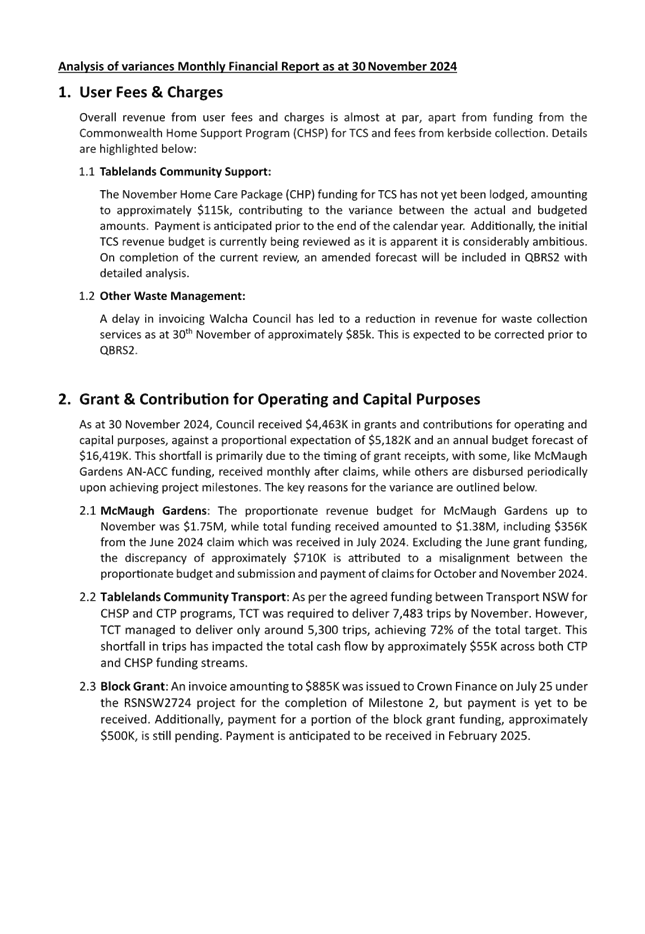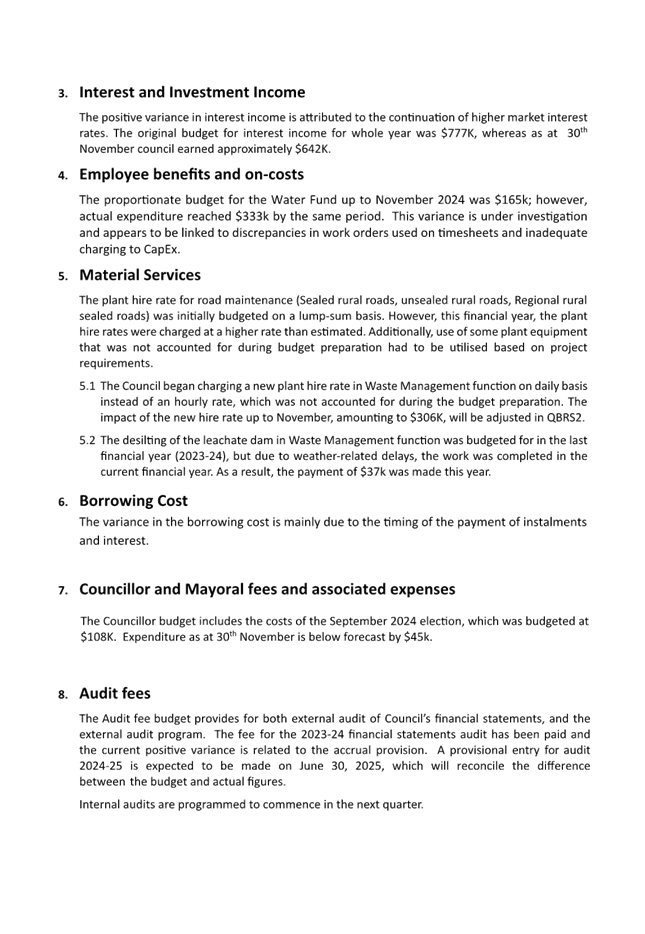|

|
|
Agenda & Business
PAPERS
|
|
Notice is hereby given, in accordance with the
provision of the Local Government Act 1993 that a meeting of Uralla
Shire Council will be held in the Council Chambers, 32 Salisbury Street,
Uralla.
|
|
Ordinary Council Meeting
17 December 2024
|
|
Commencing at 4:00 PM
|
|

|
|
Statement of Ethical Obligations
The Mayor and Councillors are bound by the Oath/ Affirmation of
Office made at the start of the Council term to undertake their civic duties
in the best interests of the people of Uralla Shire and to faithfully and
impartially carry out the functions, powers, authorities and discretions
vested in them under the Local Government Act or any other Act, to the
best of their skill and judgement.
It is also a requirement
that the Mayor and Councillors disclose conflicts of interest in relation to
items listed for consideration on the Agenda or which are considered at this
meeting in accordance with Council’s Code of Conduct and Code of
Meeting Practice.
|
|
Toni Averay
General
Manager
|
|
Ordinary Council
Meeting Business Agenda
|
17 December 2024
|
7 Confirmation
of Minutes
7.1 Confirmation
of Minutes Ordinary Meeting held 26 November 2024
|
Department:
|
General Manager’s
Office
|
|
Prepared By:
|
Executive Assistant
|
|
Authorised By:
|
General Manager
|
|
Reference:
|
UINT/24/20057
|
|
Attachments:
|
1. Minutes
Ordinary Meeting 26 November 2024 ⇩ 
|
|
Recommendation
That Council adopts the minutes of the Ordinary Meeting
held 26 November 2024 as a true and correct record.
|
|
Ordinary Council Meeting Business Agenda
|
17 December 2024
|












|
Ordinary Council
Meeting Business Agenda
|
17 December 2024
|
14 Reports to
Council
14.1 Christmas
Street Fair Evaluation Report
|
Department:
|
Infrastructure &
Development
|
|
Prepared By:
|
Grants Officer
|
|
Authorised By:
|
General Manager
|
|
Reference:
|
UINT/24/20446
|
|
Attachments:
|
1. Marketing
Campaign Report - Uralla Christmas Street Fair ⇩ 
2. Christmas
Street Fair Evaluation Data Report ⇩ 
|
|
LINKAGE TO INTEGRATED PLANNING AND REPORTING FRAMEWORK
|
|
Goal:
|
2. We
drive the economy to support prosperity
|
|
Strategy:
|
2.1. An
attractive environment for the business sector
|
Summary
Council received funding from the NSW Government to host the
inaugural Uralla Christmas Street Fair held on Friday 22 November 2024. The
event was highly successful – attracting a large audience, engaging our
community, and supporting local economic activity.
As part of the project, we implemented an extensive
evaluation program, with feedback sought from our major event stakeholder
groups: funders / sponsors, event partners, performers and participants, as
well as audiences in attendance.
|
Recommendation
That Council notes the information presented in this
report.
|
Report
Because we deployed mix methodology for data collection, and
recorded significant participant and audience feedback, we have a high degree
of confidence in our evaluation findings (4% margin of error).
Headline statistics included in the report:
- Program
partners: 68 Uralla Shire businesses & community groups, 35 market stall
holders all from within Uralla Shire, and 27 featured performers
- Total
estimated attendance of 2400 people
- 58%
of event attendees were visitors to Uralla Shire, 8% were first time visitors
to Uralla
- Our
social media campaign was highly successful, reaching over 32,000 unique
users
- Engagement
with our Facebook page increased 409% compared to the prior month (which was
our previously highest recorded month of activity).
Conclusion
Events such as this require funding to be identified and a
commitment from Council over time. Council may need to consider the
implications of resourcing and funding of these events into future.
Council Implications
Community Engagement/Communication
Nil
Policy and Regulation
Nil
Financial/Long Term Financial Plan
Nil
Asset Management/Asset Management Strategy
Nil
Workforce/Workforce Management Strategy
Nil
Legal and Risk Management
Nil
Performance Measures
Nil
Project Management
Nil
|
Ordinary Council Meeting Business Agenda
|
17 December 2024
|















|
Ordinary
Council Meeting Business Agenda
|
17 December 2024
|





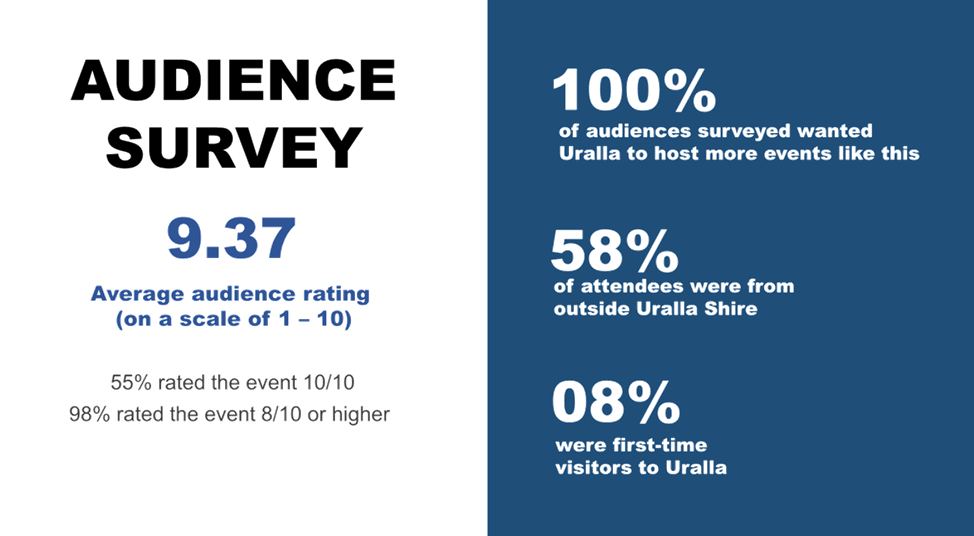









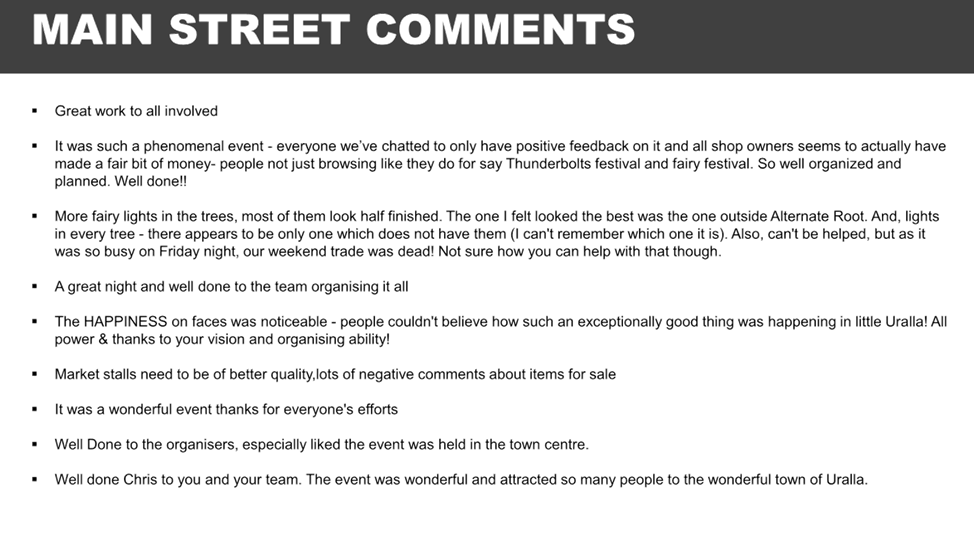

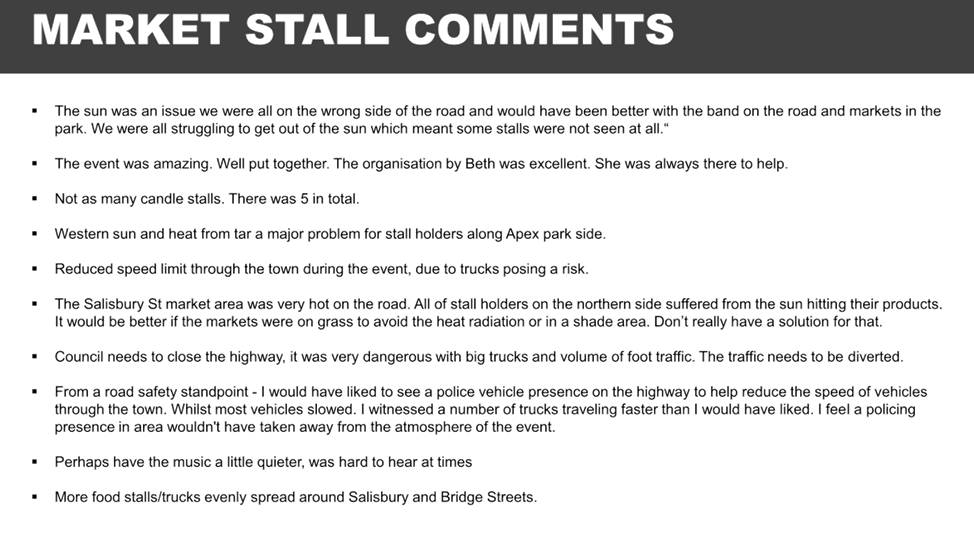
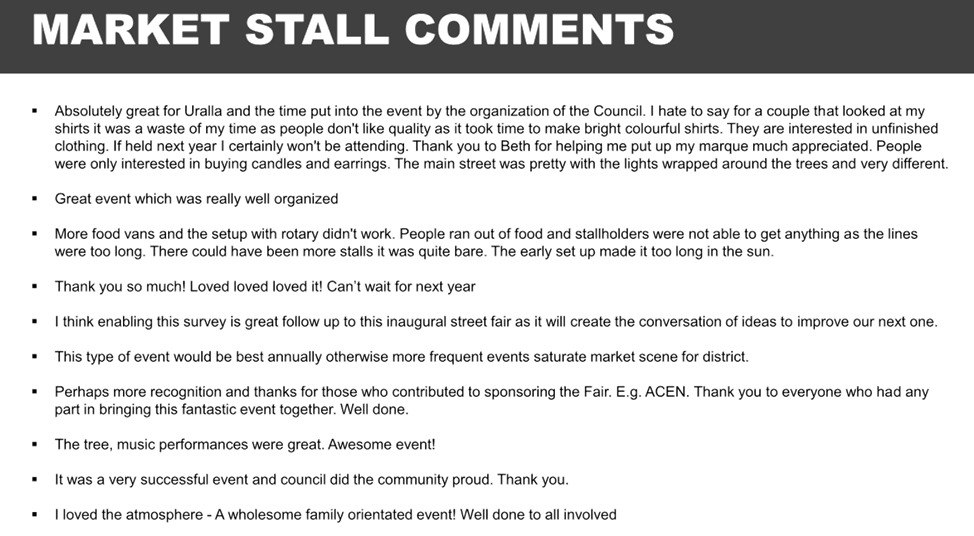

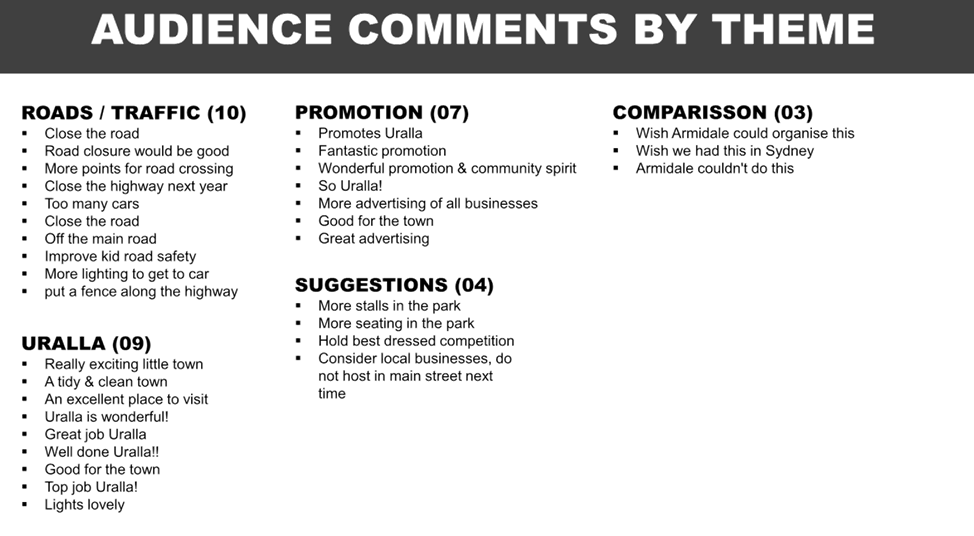
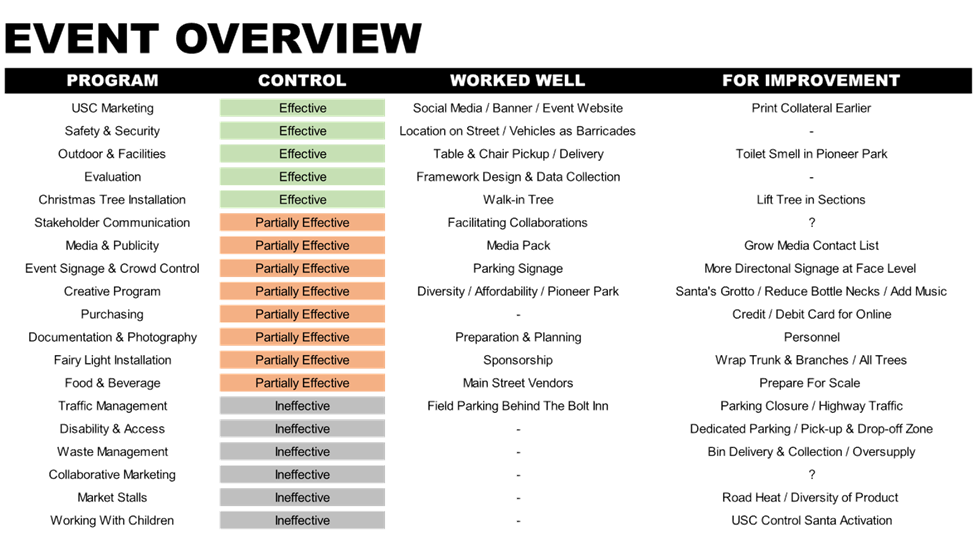
|
Ordinary Council
Meeting Business Agenda
|
17 December 2024
|
14.2 Amendments
to Fees and Charges
|
Department:
|
Infrastructure &
Development
|
|
Prepared By:
|
Acting Manager Planning
Development
|
|
Authorised By:
|
Director Infrastructure & Development
|
|
Reference:
|
UINT/24/18760
|
|
LINKAGE TO INTEGRATED PLANNING AND REPORTING FRAMEWORK
|
|
Goal:
|
4. We
are an independent shire and well-governed community
3. We
are good custodians of our environment
1. We
have an accessible inclusive and sustainable community
|
|
Strategy:
|
4.3. An
efficient and effective independent local government
3.1. To
preserve, protect and renew our beautiful natural environment
1.4. Access
to and equity of services
|
Summary
Each
year Council is required to determine fees and charges for services it
provides. The complete list of fees and charges are made up of both fees
provided under the relevant Acts, and fees determined by Council.
Council
has adopted its 2024/25 Fees and Charges Schedule as part of the 2024/25
budget. It has since been identified that a number of new fees should be
introduced prior to the next budget setting process, and certain other existing
fees amended, to cover the current costs accruing to Council, and also to
ensure clarity around Planning Proposal costs.
This
report proposes:
a) the introduction
of several new fees to the existing 24/25 Fees and Charges Schedule for
the following processes which are currently not charged:
· Subdivision
Works Certificates and any associated inspections.
· Road
Naming
· Section
138 Applications
b) the amendment of
some existing fees already included in the 24/25 Fees and Charges Schedule
for the following processes:
· Planning
Proposals
· Subdivision
Certificates
These
fees are required to cover the cost to Council of providing these services.
|
Recommendation
That Council:
1. Endorses
the recommended amendments to the 24/25 Fees and Charges Schedule for Public
Exhibition for a period of 28 days.
2. Receives
a further report following the public exhibition period subject to the
receipt of submissions if any amendments are proposed.
3. Adopts
the proposed fees if no submissions are received, and/or no changes are
proposed.
|
Report
Section 608 of the Local
Government Act 1993 provides that Councils may charge and recover an approved
fee for a service it provides, or for inspecting premises required to be
inspected in the exercise of Council’s functions.
Public notice of a Council’s
proposed Fees and Charges Schedule must be given in the draft Operational Plan
for the year in which the fee is to be made.
Section 610F of the Act provides
that if after the date the Operational Plan commences, a new fee is proposed,
the Council must give further public notice for 28 days prior to
adoption.
The following aspects of the
report will include commentary and justification of the action (including a
brief description of the work required), and a proposed fee and/or fee
structure. It is noted that the subject fees and charges have been reviewed
against nearby Councils and have been found to be reasonably consistent.
It is noted that under each aspect of work, a brief comparison has been given
with nearby Councils. This is proportionate and goes into greater detail in
relation to Planning Proposals and Subdivision Works Certificates.
Subdivision Works Certificate:
Under
Section 6.13 of the Environmental Planning and Assessment Act 1979 (EP&A
Act), a Subdivision Works Certificate (SWC) is required before you can
carry out subdivision work in accordance with a development consent. A SWC is a
certificate that operates in the same manner as construction certificate but
for subdivision works.
A
SWC certifies that subdivision work will be completed in accordance with
specified plans and specifications will comply with any requirements in the
regulations. The issuing of a subdivision works certificate does not negate the
need for a construction certificate for building works. A SWC does not
apply to complying development certificates and some Crown developments.
A
SWC involves the following internal parties:
- Administration
- Development
Planning
- Development
Engineering
Council’s
adopted Fees and Charges Schedule does not currently include fees for a SWC or
for additional inspections, if required.
In terms of comparison with nearby Council’s, the
following is noted:
|
LGA
|
Fee Summary
|
|
Tamworth Regional
|
· No fee indicated
|
|
Armidale Regional
|
· Similar to as proposed
|
|
Inverell Shire Council
|
· $110.00 per lot
|
|
Walcha
|
· No fee indicated
|
|
Gunnedah Shire
|
· Minimum fee $304.00
· $210 per application plus $47 per lot.
· Does not include inspection fees (between $440 and
$1,320)
|
|
Glen Innes Severn
|
· Minimum $325 application
· If creating a new road: $709 plus $65 per additional
lot
· No new road, or Strata: $352 plus $65 per additional
lot
|
Proposed fee:
|
Name
|
Fee
GST Excl)
|
GST
|
Fee
(GST Incl)
|
Unit
|
|
Subdivision
Works Certificate
|
$409.09
|
$40.91
|
$450.00
|
Per
lot
(includes
up to 5 inspections)
|
|
Subdivision
Works Inspection
|
$357.27
|
$35.73
|
$393.00
|
Per
inspection over 5
(if
over 5 required)
|
Road Naming:
A subdivision creating a new road will generally require
road naming. The authority overseeing the road is responsible for its naming.
Council must endorse and ensure the road name is approved by the Geographical
Names Board.
When naming public roads in NSW, road naming authorities
must follow the:
- Roads
Act 1993 (Part 10, Division 4, Section162)
- Roads
Regulation 2018 (part 2, Division 1, Clause 7)
- NSW
Address Policy and User Manual (6.7 Principles of Road Naming)
The process requires notification on Council’s
networks, along with general negotiation with the applicant, and involves the
following internal parties:
- Administration
- Development
& Planning
Council’s adopted Fees and Charges does not currently
include a fee for road naming.
Proposed fee:
|
Name
|
Fee
(GST Excl)
|
GST
|
Fee
(GST Incl)
|
Unit
|
|
Road
Naming Administration and Advertising Fee
|
$281.00
|
$0
|
$281.00
|
Per
road
|
The fee is consistent with Armidale Regional Council,
exceeds Gunnedah Shire Council ($246) and is less than Tamworth Regional
Council ($300 plus $25/road plus $80 amendment fee).
Section 138 Application
Pursuant
to Section 138 of the Roads Act 1993, approval is required for certain
activities within a road reserve. This includes (but is not limited to) the
following in, on or over a public road:
- Erection
of structures or carrying out of work.
- Digging
up or disturbance of the road surface.
- Removal
or interference with a structure, work or tree.
The most common work is for
driveway crossovers and drainage inlets to kerbs (usually associated with a
Development Consent). This requires lodgement of an application and typically
involves review of submitted documentation, and assessment against relevant
standards.
It is not intended to request a
fee for other Section 138 application types, such as for tree works, erection
of a temporary hoarding or A-frame signage.
The process involves the following
internal parties:
- Administration
- Development
Engineering
Council’s adopted Fees and Charges does not currently
include a fee for a driveway crossover or drainage inlet works.
Proposed fee:
|
Name
|
Fee
(GST Excl)
|
GST
|
Fee
(GST Incl)
|
Unit
|
|
Section
138 Approval
(Driveway
crossover and kerb inlets)
|
$197.00
|
$0
|
$197.00
|
Per
application
|
The fee is consistent with Armidale Regional Council, and
less than Tamworth Regional, Gunnedah and Walcha Councils.
Planning Proposals
Making and amending local
environmental plans (LEPs) requires with a Planning Proposal (PP), as set out
under Division 3.4 of the NSW Environmental Planning and Assessment Act 1979.
A PP is the process to change a development standard in the LEP. For example, a
PP can propose to rezone land, change minimum lot sizes, increase or decrease
the range of permissible uses for a site or change other development standards
that are applicable to a site.
It is worth reiterating that the
process is of much more complexity than a Development Application, which is the
assessment route for a proposal which is within the limits of the LEP.
Council’s fees and charges
prescribes the following fee information:
|
Planning Proposal Application
|
|
|
Subject to $4,500 deposit, and at full cost to the
applicant.
|
Last year fee At full
cost to applicant
|
It is considered that the above fee information is vague and
does not reflect the broad range and complexity of PP’s. While the
fee information ensures that that the applicant is liable for full costs, it
does not provide guidance as to the likely fees, or key steps. Furthermore, the
fee information provides difficulty and ambiguity as it excludes milestones
where fee invoices from Council would be expected.
In terms of comparison with nearby Councils, the following
is noted:
|
LGA
|
Fee Summary
|
|
Tamworth Regional
|
· Minor: $19,000.00
· Standard: $44,999.00
· Complex: $57,999.50
|
|
Armidale Regional
|
· Similar to as proposed – see table below
|
|
Inverell Shire Council
|
· Minor: $7,000.00
· All others: $16,500.00 plus $115/hr beyond 60 hours
|
|
Walcha
|
· At cost to applicant
|
|
Gunnedah Shire
|
· Minor: $5870.00
· Major*: $11,155.00
|
|
Glen Innes Severn
|
· Minor: $7,400
· Major*: $14,400.00
· Complex: $21,800.00
|
|
Gwydir Shire
|
· $650 lodgement fee plus $120/hr beyond 20 hours
· Incidentals at cost
|
*major is not a current term for a Planning Proposal, and
may require update.
Proposed Fees:
The following fee structures are respectively recommended
for ‘Minor’, ‘Standard’ and ‘Complex’
Planning Proposals. (Noting that ‘Comprehensive’ PP’s are
excluded from the proposed list, as they are a Council-driven type.
It is proposed to adopt a planning proposal fee structure
similar to Armidale and Tamworth.
However should Council prefer to align with another smaller
Council, an alternative would be to adopt a planning proposal fee structure
similar to Glen Innes Severn.
This could be determined post- exhibition subject to
Council’s preference.
|
Planning Proposals Minor
LEP Amendments
Total overall fee for minor LEP
amendments is $14,000 plus $180 per hour over 50 hours plus full cost of
community consultation, public hearings and specialist studies if required.
|
|
Stage
|
Fee
(GST
Excl)
|
GST
|
Fee
(GST
Incl)
|
Unit
|
|
Stage 1 - pre-lodgement
|
$1,050.00
|
$0.00
$0.00
$0.00
|
$1,050.00
|
Per proposal
|
|
Stage 2 - lodgement
|
$3,000.00
|
$3,000.00
|
|
Stage 3 - submission
requesting gateway determination
|
$5,250.00
|
$5,250.00
|
|
Public Notification and Community Consultation
|
Full Cost Recovery
|
|
Public Hearing
|
Per hearing
|
|
Specialist Studies
|
Per study
|
|
The cost of specialist studies is to be met by the
proponent for the planning proposal
|
|
Standard Planning Proposals
Total overall fee for Standard
LEP amendments is $32,000 plus $180 per hour over 75 hours plus full cost of
community consultation, public hearings and specialist studies if required.
|
|
Stage
|
Fee
(GST
Excl)
|
GST
|
Fee
(GST
Incl)
|
Unit
|
|
Stage 1 - pre-lodgement
|
$2,100.00
|
$0.00
|
$2,100.00
|
Per proposal
|
|
Stage 2 - lodgement
|
$6,300.00
|
$6,300.00
|
|
Stage 3 - submission
requesting gateway determination
|
$14,700.00
|
$14,700.00
|
|
Stage 4 - implement
gateway determination and make LEP amendment
|
$10,500.00
|
|
$10,500.00
|
|
Public Notification and Community Consultation
|
Full Cost Recovery
|
|
Public Hearing
|
Per hearing
|
|
Specialist Studies
|
Per study
|
|
The cost of specialist studies is to be met by the
proponent for the planning proposal.
|
|
Complex Planning Proposals
Total overall fee for all
Complex LEP amendments is $46,000 plus $180 per hour over 90 hours plus full
cost of community consultation, public hearings and specialist studies if
required.
|
|
Stage
|
Fee
(GST
Excl)
|
GST
|
Fee
(GST
Incl)
|
Unit
|
|
Stage 1 - pre-lodgement
|
$4,200.00
|
$0.00
|
$4,200.00
|
Per proposal
|
|
Stage 2 - lodgement
|
$10,500.00
|
$10,500.00
|
|
Stage 3 - submission
requesting gateway determination
|
$18,900.00
|
$18,900.00
|
|
Stage 4 - implement
gateway determination and make LEP amendment
|
$14,700.00
|
$14,700.00
|
|
Public Notification and Community Consultation
|
Full Cost Recovery
|
|
Public Hearing
|
Per hearing
|
|
Specialist Studies
|
Per study
|
|
The cost of specialist studies is to be met by the
proponent for the planning proposal.
|
Subdivision Certificate
Justification:
A Subdivision Certificate (SC)
authorises the registration of a plan of subdivision under Part 23 of the Conveyancing
Act 1919. When issued, a SC is taken to be part of the development consent that
authorised the carrying out of the subdivision.
A SC is similar to an Occupation
Certificate for a building, in that it is typically issued towards the end of
the development process, at a time when works are complete or substantially
complete. An Occupation Certificate certifies that a building is ready for
Occupation whereas a SC certifies that new lots are ready to be registered.
The process requires lodgement of
an application and assessment of the plan of subdivision against either the
related Development Consent or exempt development criteria. From an
internal perspective, this includes ensuring:
- Relevant
services have been provided or arranged.
- Works have
been completed to Council’s satisfaction (e.g. mains extensions, road
works)
- Relevant
title documents meet the intent of conditions of consent.
The
stage follows a Subdivision Works Certificate approval and is the opportunity
to ensure that the SWC has been complied with, to Council’s satisfaction.
A
SC involves the following internal parties:
- Administration
- Development
Planning
- Development
Engineering
Councils
current fee is as follows:
|
Name
|
Fee
(GST Excl)
|
GST
|
Fee
(GST Incl)
|
Unit
|
|
Subdivision
Certificate / Title Plan Processing Fee
|
$189.50
|
$0
|
$189.50
|
Per
application
|
Proposed Fee:
|
Name
|
Fee (GST Incl)
|
Unit
|
|
Subdivision Certificate
/ Title Plan Processing Fee
- Units, Occupancies or Lots - 2-10
|
$500 + $90 per unit/lot
|
Per certificate
|
|
Subdivision Certificate
/ Title Plan Processing Fee
- Units, Occupancies or Lots - > 10
|
$1,100 + $90 per
unit/lot
|
The fee exceeds Glen Innes Severn ($225 total fee), Inverell
($150 plus $55 /lot plus $55/per 88b instrument plus $100 inspection fee),
Gunnedah ($171.50 up to 5 lots, $163.00 plus $10 per lot over 5 lots) (Tamworth
($250/lot plus $25/lot plus $150 per 88b instrument) but is consistent with
Armidale Regional Council.
Conclusion
The additional and amended fees
will ensure that appropriate cost recovery will occur in relation to the
processing of several development-related applications and processes, and where
relevant, ambiguity is reduced.
Council Implications
Community
Engagement/Communication
The proposed amendments will be
exhibited for 28 days.
Policy
and Regulation
Local Government Act 1993
Environmental Planning and
Assessment Act (1979)
Financial/Long
Term Financial Plan
The proposed new fees will
generate revenue to cover the cost of providing the relevant services.
Asset
Management/Asset Management Strategy
N/A
Workforce/Workforce
Management Strategy
N/A
Legal
and Risk Management
Local Government Act 1993
Environmental Planning and
Assessment Act (1979)
Performance
Measures
Works and processes are
prioritised within resources and other commitments to minimise delays for
applicants.
Project
Management
N/A
|
Ordinary Council
Meeting Business Agenda
|
17 December 2024
|
14.3 Keeping
of Animals Policy
|
Department:
|
Infrastructure &
Development
|
|
Prepared By:
|
Acting Manager Planning
Development
|
|
Authorised By:
|
Director Infrastructure & Development
|
|
Reference:
|
UINT/24/18611
|
|
Attachments:
|
1. Draft
Policy (Amended) ⇩ 
2. Submissions
(Redacted) ⇩ 
3. Summary
of Submissions and Officer Response ⇩ 
4. Draft
Policy April 2024 ⇩ 
|
|
LINKAGE TO INTEGRATED PLANNING AND REPORTING FRAMEWORK
|
|
Goal:
|
3. We
are good custodians of our environment
4. We
are an independent shire and well-governed community
|
|
Strategy:
|
3.2. Maintain
a healthy balance between development and the environment
4.2. A
strategic, accountable and representative Council
|
Summary
The Draft Keeping of Animals
Policy (Urban Areas) was presented to Council 23 April 2024, where it was resolved
as follows:
|
1. Endorses the Draft Policy - Keeping of Animals Policy
(Urban Areas) for Public Exhibition for a period of 28 days for the purposes
of receiving public submissions, subject to the following amendments:
a) Page 5, Clause
6.5: Delete ‘Construction of kennel facilities must comply with the
Building Code of Australia’.
b) Insert into Part
4 ‘Statement”: Any animal housing structures shall be
structurally adequate and comply with Building Code of Australia if required.
c) Delete all
references to Schedule 2 of the Local Government (General) Regulation
2021 references in the draft Policy where it relates to specific
animals/birds, noting that these provisions apply as noted in Clause 5 on
Page 2 of the draft Policy.
2. Notify the
following groups of the revised policy and the opportunity to provide
feedback upon commencement of Public Exhibition:
· Uralla
& Bundarra Pony Clubs;
· New
England Exhibition of Poultry Association;
· Uralla
& Bundarra Showground Land Managers; and
· Any
other group likely to be impacted by the Draft Policy.
3. Receives a
further report following the public exhibition period subject to the receipt
of submissions and/or if the draft policy is proposed to be amended.
4. Authorises
the adoption of the Draft Policy - Keeping of Animals (Urban Areas) if no
submissions are received, and no changes are made.
|
The Draft Policy was exhibited for an initial period of
28 days (including through Council’s Facebook page) and was further
extended until 30 June 2024. Additionally, key and identifiable community
groups were notified of the Draft Policy, as per the resolution.
A total of 16 (sixteen) written submissions were made in
response to exhibition of the Draft Policy. As such, this report has been
prepared in response to the submissions. It is noted that the previous version
presented to Council on 23 April 2024 was based on an evolutionary update of
the current Policy (2010). Following Council feedback and a review of
submissions, it was determined that the policy was not fit for purpose and
required a holistic and substantial revision to better respond to the needs of
the Shire. A review of the policies of several other Councils including
Tenterfield, Byron, Liverpool Plains, Lake Macquarie, Maitland City,
Muswellbrook Councils was also undertaken in order to develop a best practice
approach.
While this report responds to the submissions made as per
the above detailed resolution, the amended policy has been significantly
revised.
|
Recommendation*
That
Council:
1. Adopts the Draft Policy - Keeping of Animals Policy (Urban Areas) (2024);
and
2. Notes submissions received in response to consultation.
|
*Note that an alternative
recommendation has been provided at the end of the report
Report
Submissions
Submissions in relation to the policy as exhibited from
April to June 2024 are attached to this report and are grouped into General and
Animal Specific themes. A summary is as follows:
Table 1: Summary of Submission Themes
|
General Matters
|
Animal-Specific
Matters
|
|
Definition of Urban Areas
Biosecurity
Website information
Grammar
Impact on economy & community
Enforcement issues
Impact on existing animals
Unfair frequency of policy review
Conflict with Companion Animals Act
1998
Appropriateness for school(s) to be
affected by policy
|
Goats
Dogs
(including hunting dogs, rural-work
dogs and breeders)
Cats
Pigeons
Poultry
Bees
Birds
|
Please refer to the attached documents for:
· Review of the
submissions in detail, together with the Officer’s response and
commentary; and
· Redacted
submissions.
REFERRALS:
Internal – The draft revised policy has been
reviewed by Manager Governance and Service Centre, who has provided support,
subject to non-material amendments which have now been incorporated.
External – The draft revised policy has been
referred to Northern Tablelands Local Land Service 4 December 2024. At the time
of finalisation of this report, no response has been provided. Notwithstanding,
the proposal is responsive to referral comments provided by Andrew Biddle (Team
Leader, Animal Biosecurity and Welfare). In particular, the policy now refers
to obligations under NSW Biosecurity Act 2015 and Biosecurity
(National Livestock Identification System) Regulation 2017.
DRAFT POLICY: KEY AMENDMENTS
The changes to the policy are extensive. For this reason, a
tabled comparison is not considered practical. Changes proposed include:
· Expressed
identification of the land zonings to which the policy would apply. Note that
land zoned R5 (large lot residential) remains excluded.
· Improved clarity
around the hierarchy and interaction with other polices, such as the Companion
Animals Act 1998, Local Government (General) Regulation 2021, NSW Biosecurity
Act 2015 and Biosecurity (National Livestock Identification System)
Regulation 2017.
· Inclusion of a
clear and legible tabled format (Table 1 of Policy) to succinctly identify the
number of animals, distance from enclosures to dwellings and the like and any
additional requirements.
· Inclusion of added
flexibility, through expressly setting out a framework and
consideration/assessment criteria for applying for further animals.
· Inclusion of
clearer information regarding the issue of orders.
A summary of key animal specific changes has been included
(refer below). It is noted that for each animal, specified additional
requirements have been included, which are intended to capture the relevant
requirements, but avoid duplication of associated legislation and ensure
brevity and user-friendliness. For this reason, it is recommended to review the
revised policy in full.
Where a new species has been included, details have been
omitted as the table below is intended for summary comparison purposes only. In
the context of the policy, additional species have been included for
completeness, however by their unique nature, this is not considered itself to
warrant further exhibition. An alternative recommendation has been provided to
support Council’s decision, however it is the officers view that the revised
policy is responsive to the submissions received, and for this reason, further
notification is not an inherent requirement.
Table 2: Summary of Species-specific changes
|
Dogs
|
No change to area &
number requirements
New provision for
Attack-trained dogs.
Specified additional
requirements:
· Comply with requirements of the Companion
Animals Act 1998 including registration and control of dogs.
· Ensure fencing is adequate. In addition,
attack-trained dogs shall be held in an urban area only where appropriate
fencing is provided to prevent escape.
· Prevent persistent, excessive or offensive noise.
· The area in which the dogs are housed is
to be maintained in a hygienic condition to:
a) Limit
the spread of disease; and
b) Minimise
offensive odour.
|
|
Cats
|
No change to number
requirements
Specified additional
requirements:
· Comply with requirements of Companion Animals Act 1998
including registration and control of cats.
· Prevent persistent, excessive noise.
· Owners are encouraged to contain their cats during the hours of darkness to
prevent attacks on native fauna.
|
|
Poultry
|
Increased number allowance
for all poultry
No material change to
setback requirements.
Allowances for roosters and
male species generally, subject to Council’s discretion.
Specified additional
requirements:
· Prevent escape of poultry (a poultry yard is recommended).
· Keep
poultry yards clean, free of rats and mice, and free from offensive
odours.
· Prevent persistent, excessive noise.
· Roosters are prohibited unless housed in a soundproof enclosure or with
similar noise control method, to the satisfaction of Council.
· Comply with the Biosecurity Act 2015 (NSW)
and Biosecurity (National Livestock Identification System) Regulation 2017,
including holding a PIC.
|
|
Pigeons
|
Reduced allowance for
pigeons
Specified additional
requirements:
· Do not use open lofts.
· Keep lofts/cages clean, and free of rats
and mice.
· Lofts shall be erected away from fences
and buildings, to facilitate cleaning.
· Keep pigeons free of lice.
· Clean up and correctly dispose of manure
daily.
· Ensure pigeons allowed to fly free do
not repeatedly cause damage to, or interfere with the enjoyment of, other
property or premises.
· Comply with the Biosecurity Act 2015 (NSW)
and Biosecurity (National Livestock Identification System) Regulation 2017,
including holding a PIC.
|
|
Birds
|
Introduction of setback
requirements and maximum numbers
Separation of birds into
different categories
Specified additional
requirements:
· Use cages and aviaries of appropriate
size.
· Keep cages and aviaries clean, and free
of rats and mice.
· Prevent persistent, excessive noise.
· Hold National Parks and Wildlife permit
(if required).
|
|
Rabbits
|
Not previously included
|
|
Ferrets
|
|
Pet rats, mice
and guinea pigs
|
|
Sheep and goats
etc (including deer and camelids)
|
No change to number
requirements
Inclusion of new setback
requirements.
Inclusion of allowances for
uncastrated male species.
Specified additional
requirements:
· Do not slaughter at premises where
animals are kept
· Ensure fencing is adequate.
· Prevent persistent, excessive noise.
· Neighbouring trees/shrubs are protected.
· The keeping of uncastrated male species
(e.g. Rams, Bucks and or Billy Goats) is not permitted, except with the prior
written approval of Council.
· Comply with the Biosecurity Act 2015 (NSW)
and Biosecurity (National Livestock Identification System) Regulation 2017,
including holding a PIC.
|
|
Pigs
|
No change to number
requirements
Introduction of setback to
dwelling requirement.
Specified additional
requirements:
· Do not keep in a place/manner that may
pollute water likely to be used by a person for drinking/domestic purposes or
in a dairy.
· Do not deposit dung in a place/manner
that may pollute water likely to be used by a person for drinking/domestic
purposes.
· Do not slaughter at premises where animals are kept.
· Comply with the Biosecurity Act 2015 (NSW)
and Biosecurity (National Livestock Identification System) Regulation 2017,
including holding a PIC.
|
|
Horses and Cattle
|
No change to area
requirements.
Maintained prohibition for
uncastrated male species.
Specified additional
requirements:
· Ensure fencing is adequate.
· Do not slaughter at premises where
animals are kept.
· Neighbouring trees/shrubs are to be protected.
· The area must be kept free of offensive
odour/flies and rodents.
· Comply with the Biosecurity Act 2015 (NSW)
and Biosecurity (National Livestock Identification System) Regulation 2017,
including holding a PIC.
|
|
Reptiles
|
Not previously included
|
|
Fish, aquarium
and pond
|
|
Bees
|
Increased allowances, to
promote survival.
Provision of a minimum
area, for keeping of keeping of bees, in response to allowance for increased
number of hives
Specified additional requirements:
· Beehives must be registered with the NSW
Department of Primary Industries.
· For keepers of European honey bees (Apis mellifera),
be registered with NSW Government and comply with the Australian Honey Bee
Industry Biosecurity Code of Practice.
· Registration details must be prominently displayed
on hive ware.
· Must not cause a nuisance or safety hazard to
neighbouring premises.
· Strongly recommend that hobbyists engage with local
beekeepers club/ association to learn disease management and husbandry.
· The keeping of bees on a lot less than
1500m2 is prohibited, except with the prior written approval of
Council.
|
The flexibility of the policy would be secured through Part
2.3, which is considered to be responsive to community needs while still
providing a clear framework for situations where existing animals may be
considered. To facilitate this aspect of the policy, Council would create an
approved form for any application.
Conclusion
As amended, the Draft Keeping
of Animals Policy (2024) has been thoroughly revised, and now provides
flexibility together with clearer requirements for the keeping of animals in
urban areas. Additionally, the Policy has been amended for general housekeeping
and to ensure that it meets relevant legislation which has been implemented or
updated since the existing policy was adopted.
Alternative Recommendation*
That
Council:
1. Endorses
the revised Draft Policy - Keeping of
Animals Policy (Urban Areas) (2024) for Public Exhibition for a
period of 28 days for the purposes of receiving further public submissions.
2. Receives
a further report following the public exhibition period subject to the receipt
of submissions and/or if the draft policy is proposed to be amended.
3. Authorises
the adoption of the Draft Policy - Keeping of Animals (Urban Areas) (2024) if:
a) No submissions are received; or
b) No new submission themes/matters are
raised, to the satisfaction of the General Manager; or
c) If no amendments to the policy are
required to be made.
Council Implications
Community
Engagement/Communication
The Draft Policy has been amended
in response to previous notification, which exceeded 28 days.
Policy
and Regulation
The Policy is consistent with the
Local Government Act 1993.
Financial/Long
Term Financial Plan
No financial impacts. Enforcement
will be undertaken within existing resources.
Asset
Management/Asset Management Strategy
Nil
Workforce/Workforce
Management Strategy
Enforcement will be undertaken
within existing resources.
Legal
and Risk Management
The proposed Policy supports State legislation including the
Local Government Act 1993 and the Companion Animals Act 1998.
Performance
Measures
Customer requests and Complaints
in respect of the policy provisions will be investigated and documented in
accordance with Council’s governance and customer charter provisions.
Project
Management
Not applicable.
|
Ordinary Council Meeting Business Agenda
|
17 December 2024
|
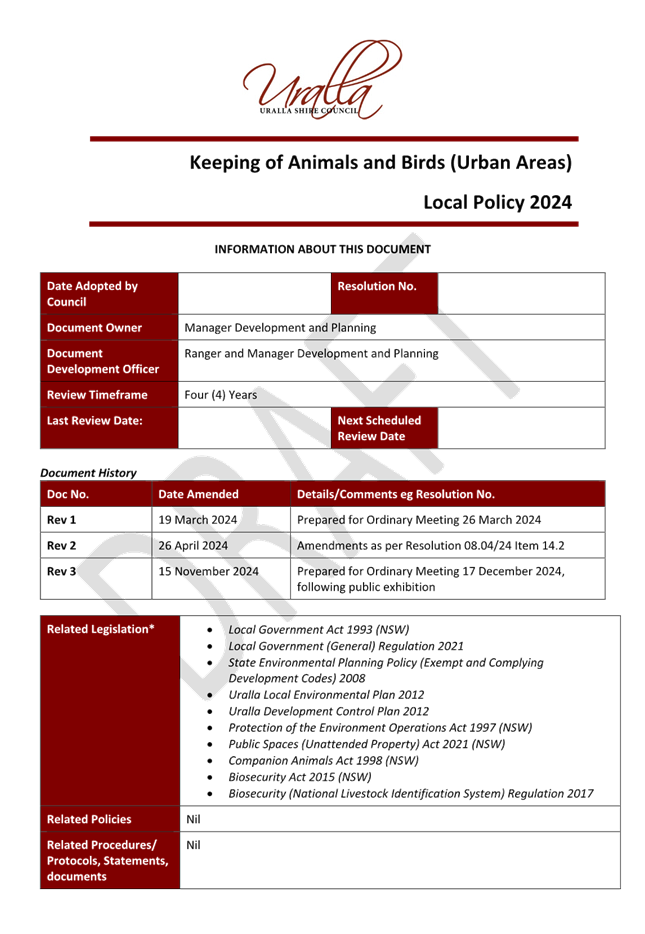

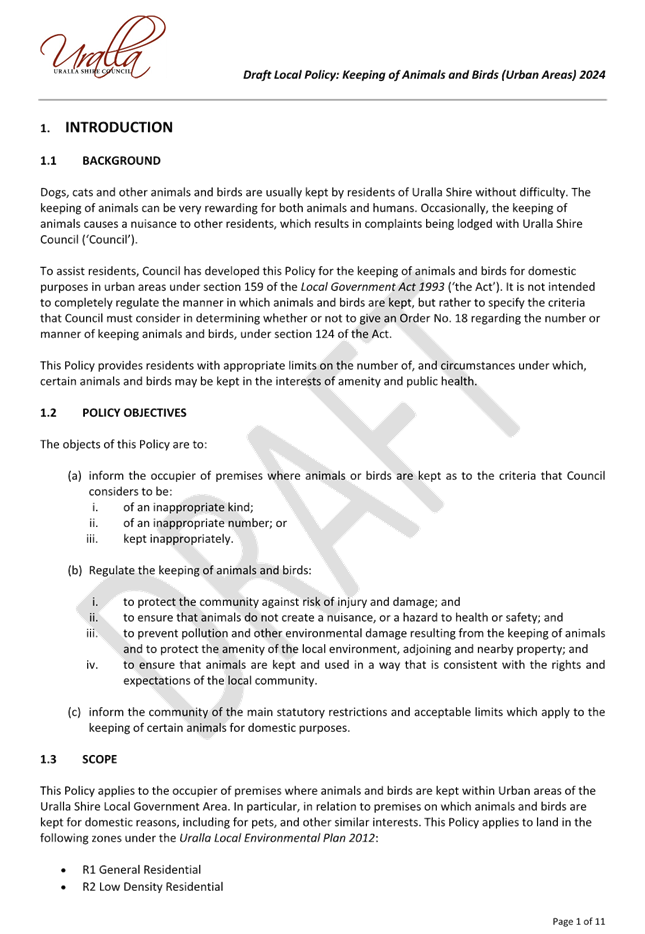
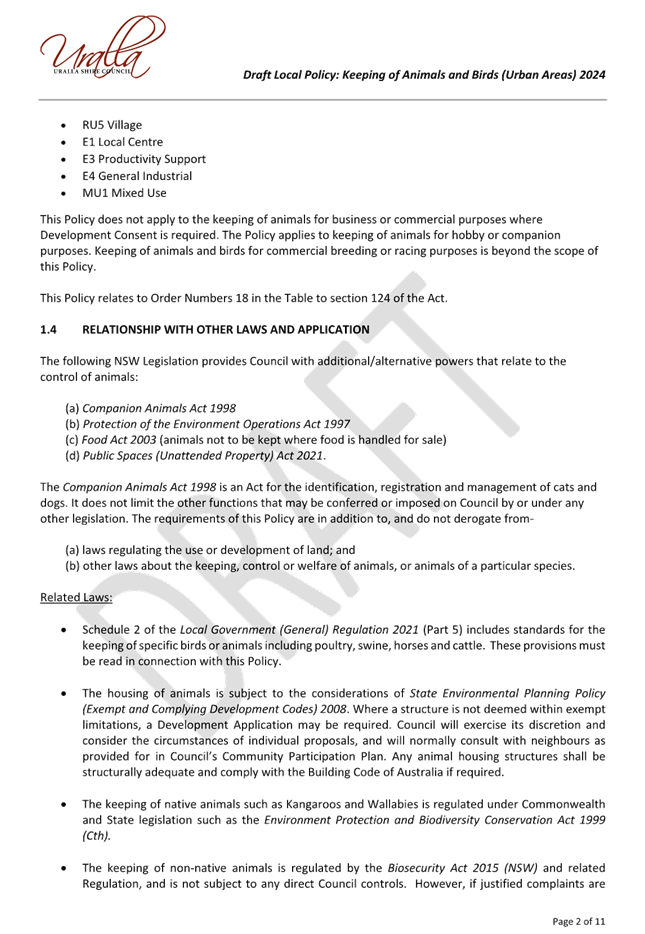
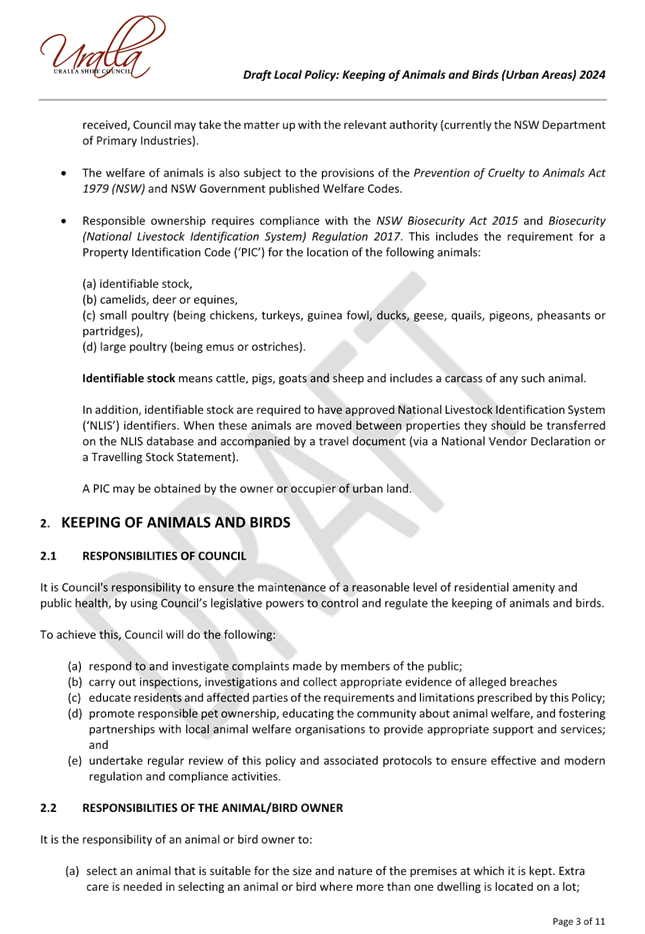
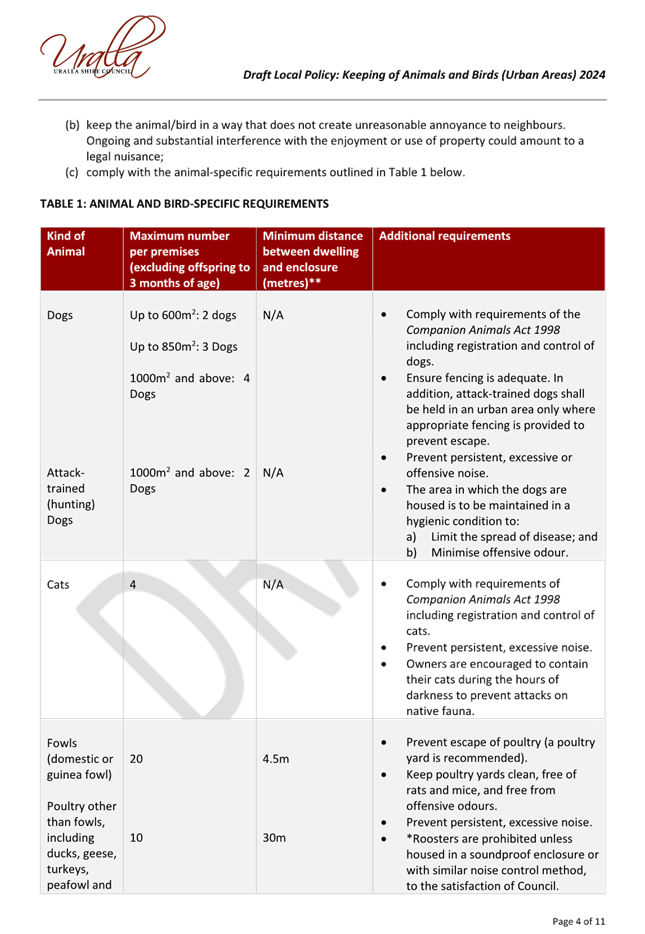
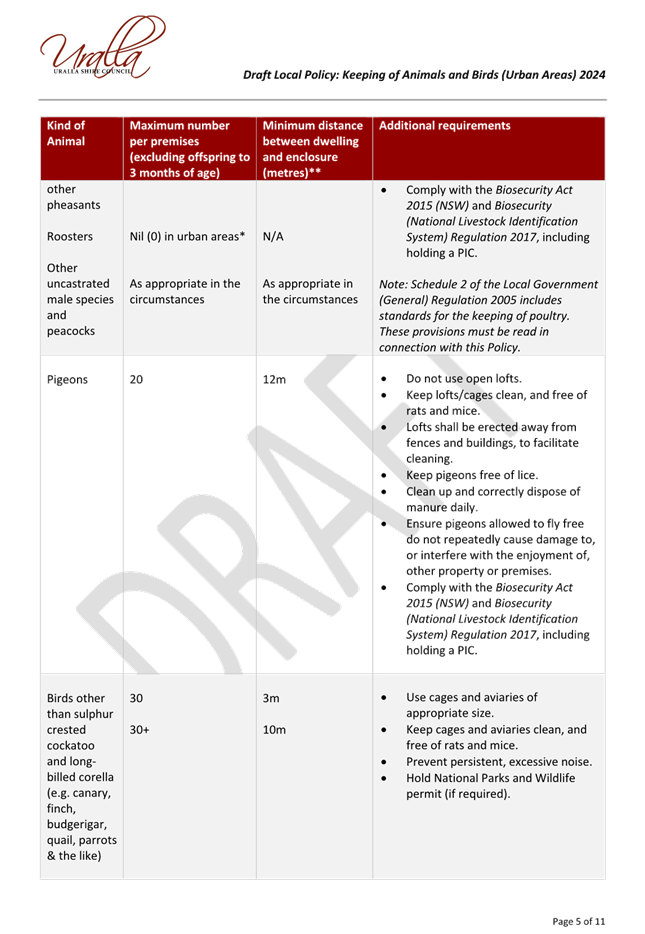

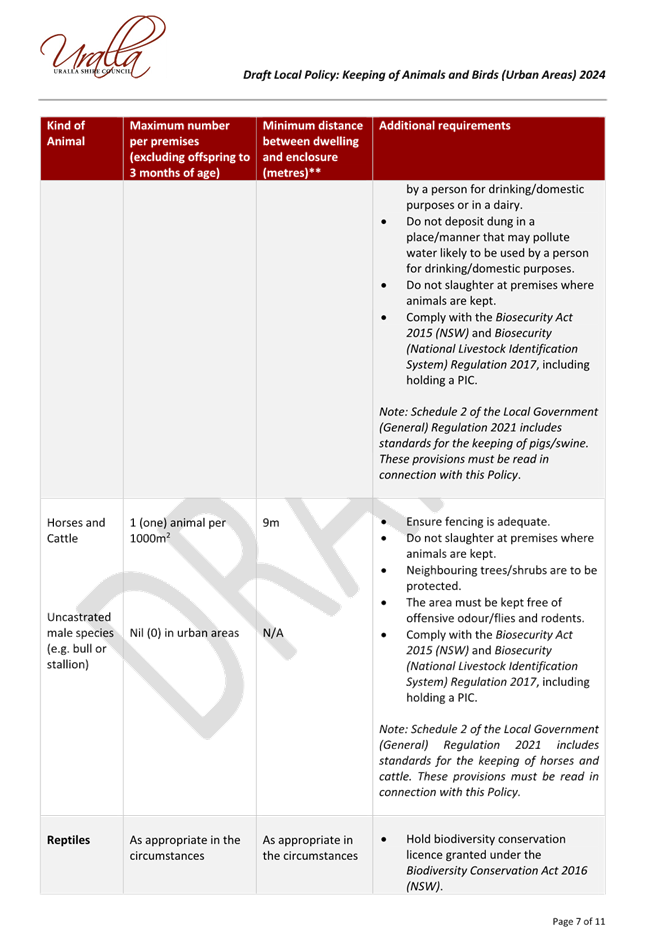


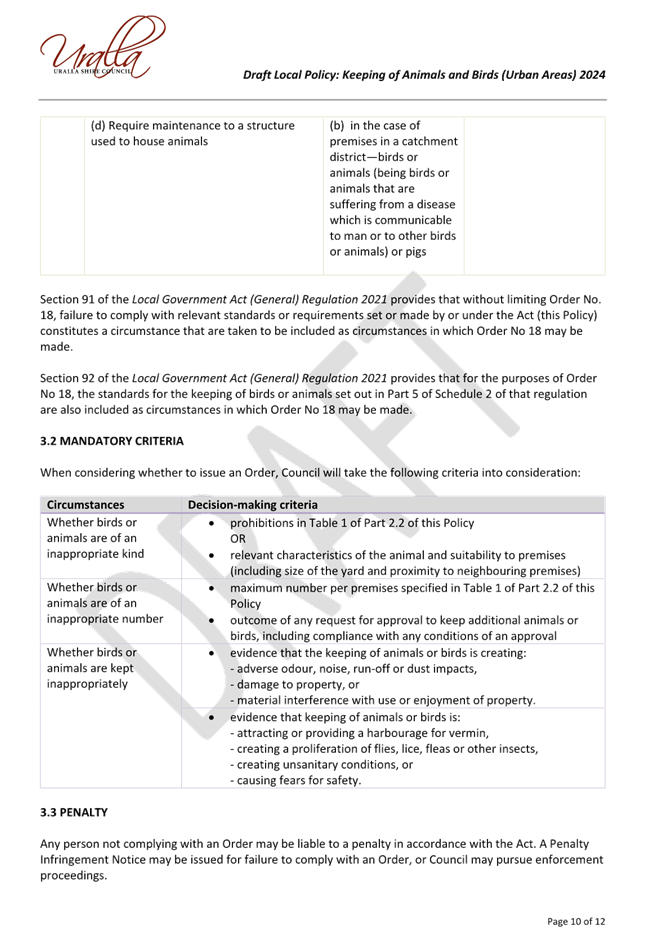
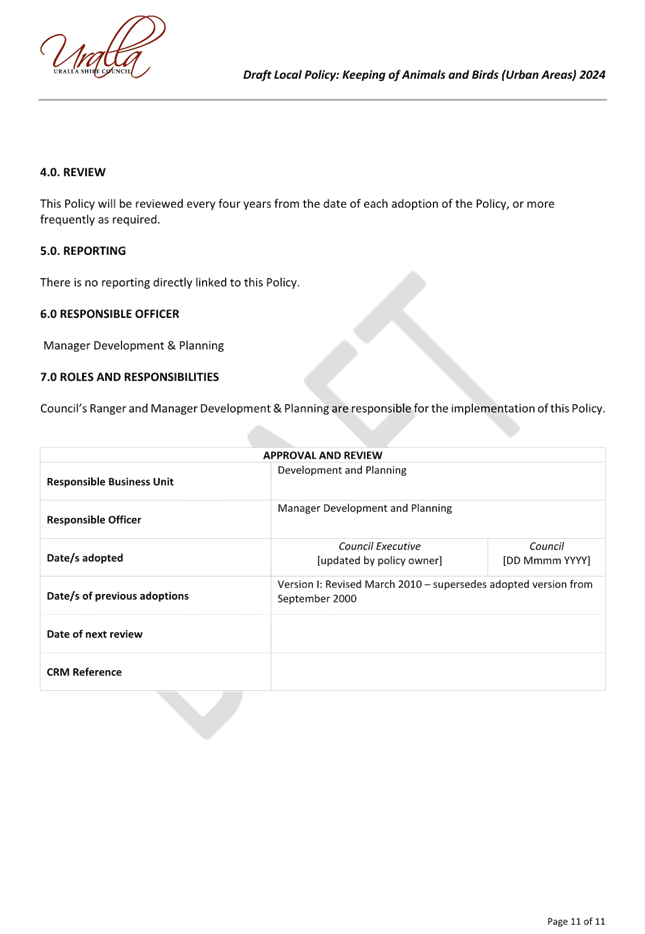
|
Ordinary
Council Meeting Business Agenda
|
17 December 2024
|
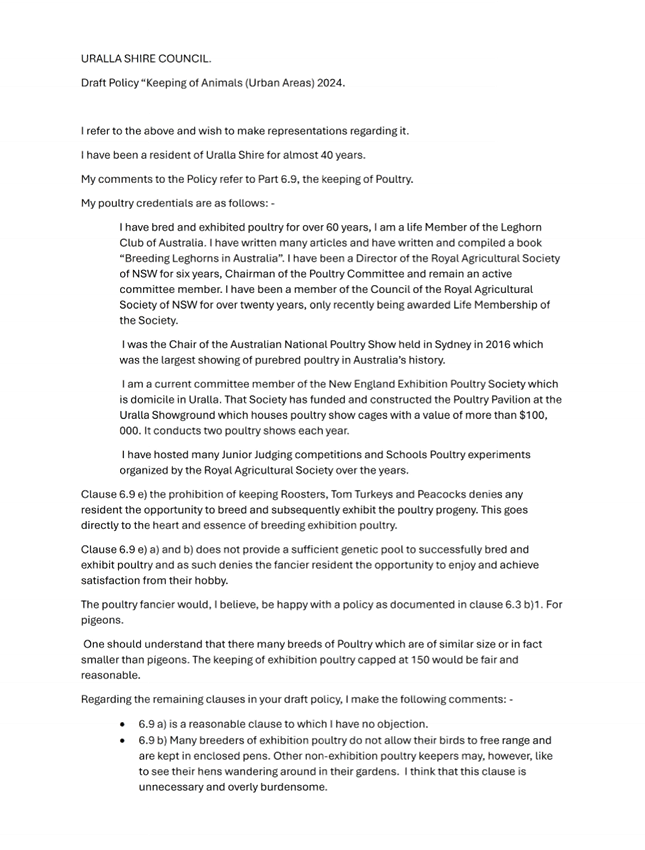

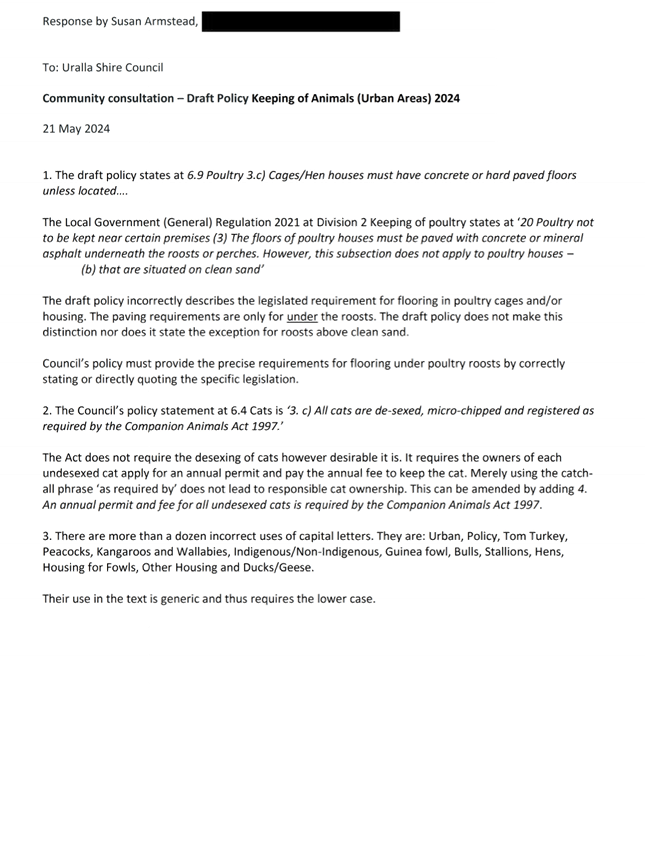
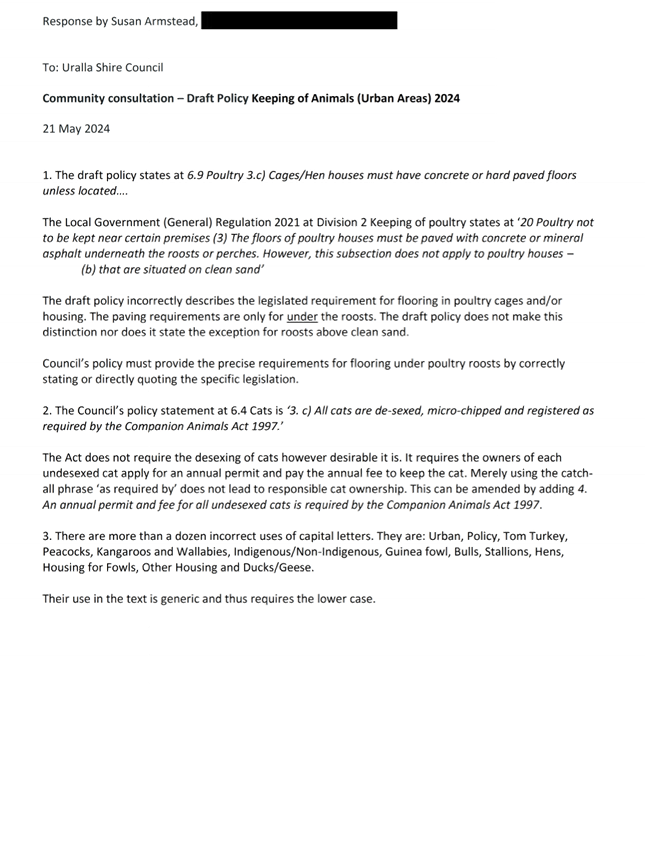

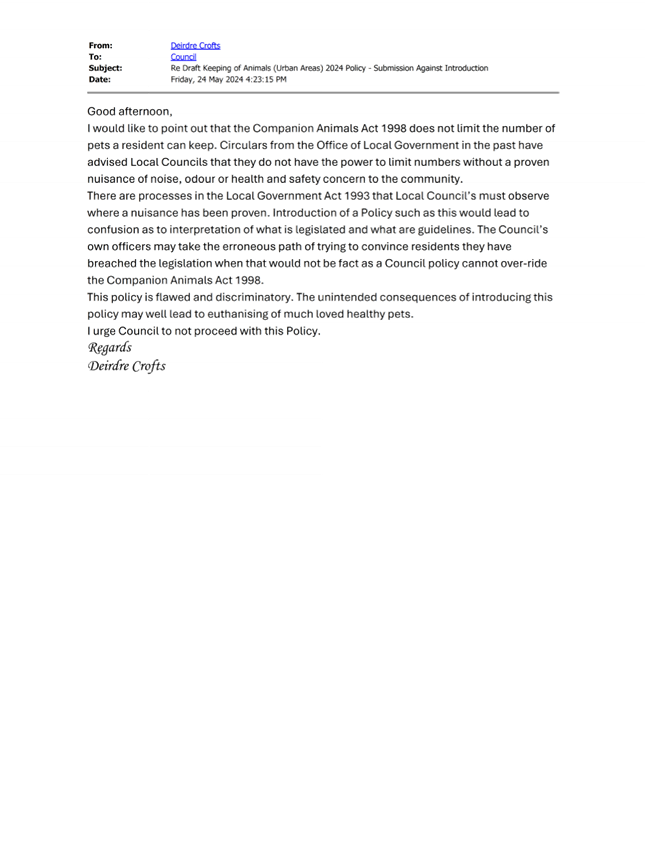

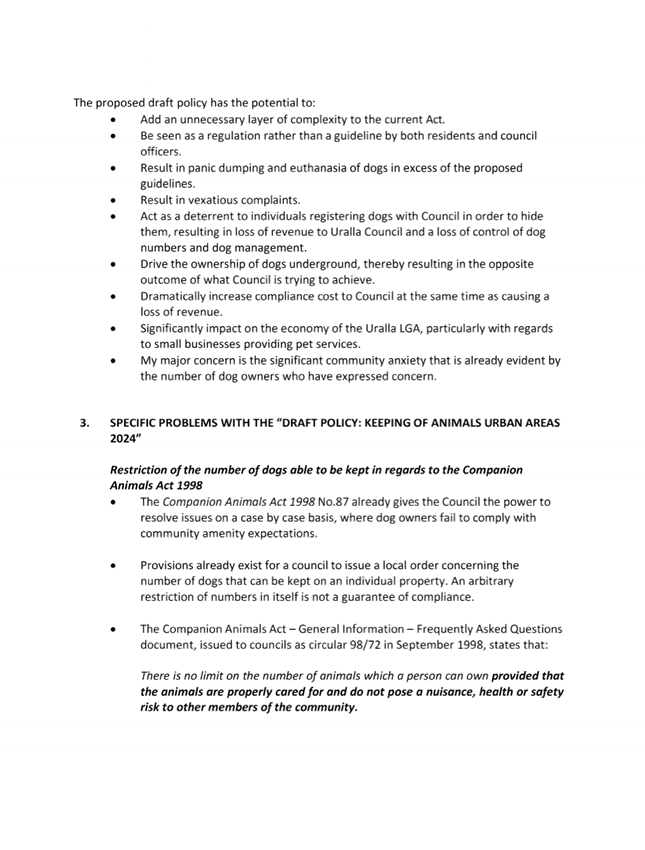
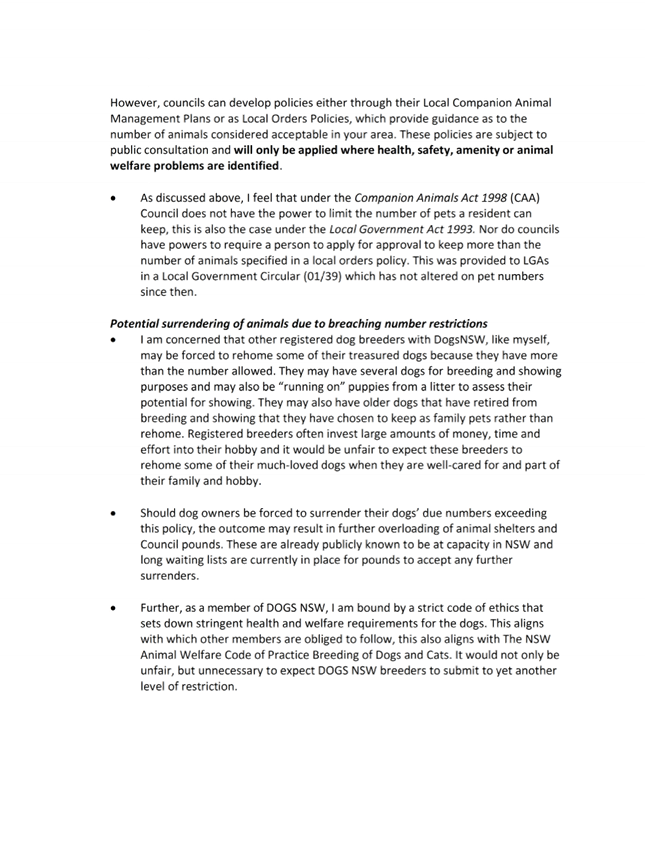

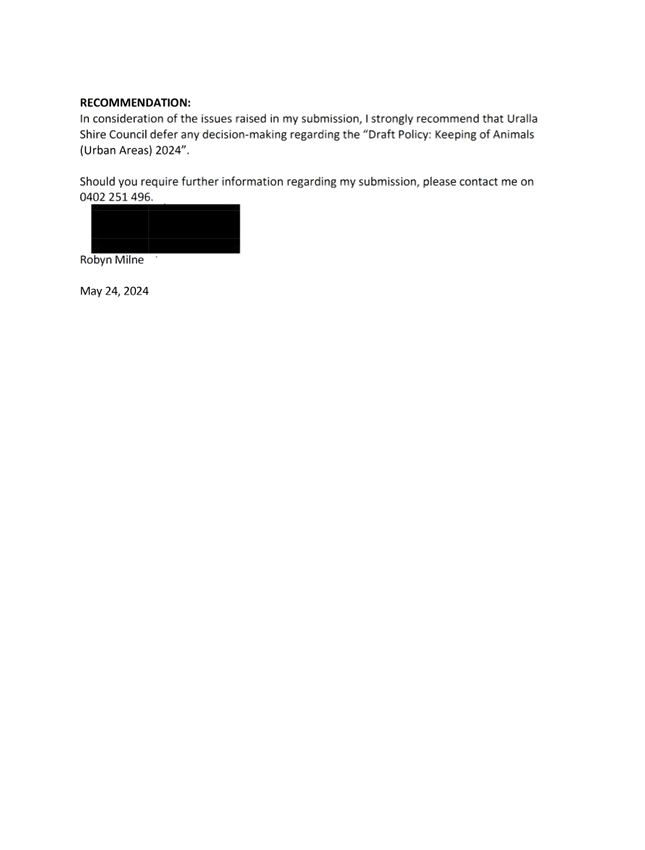
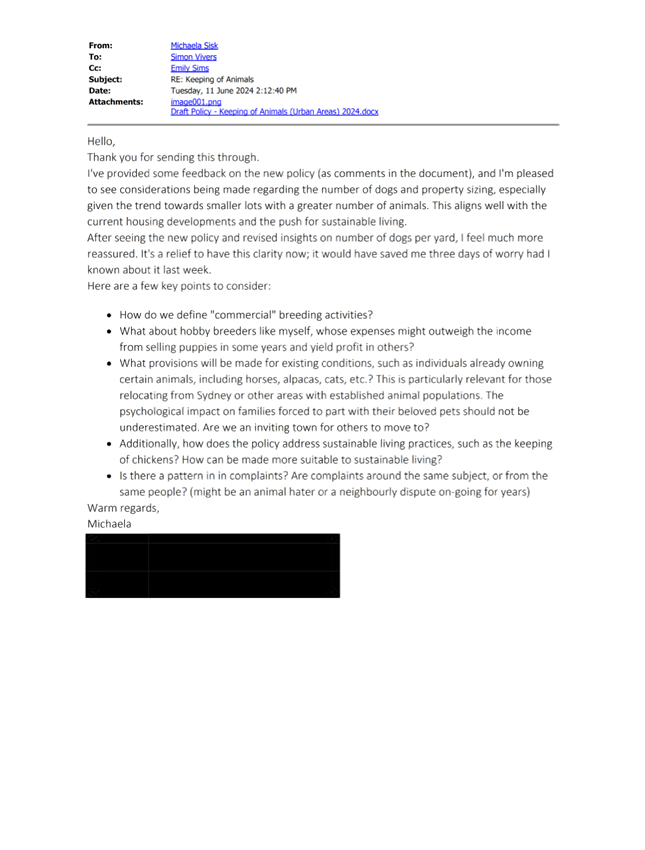
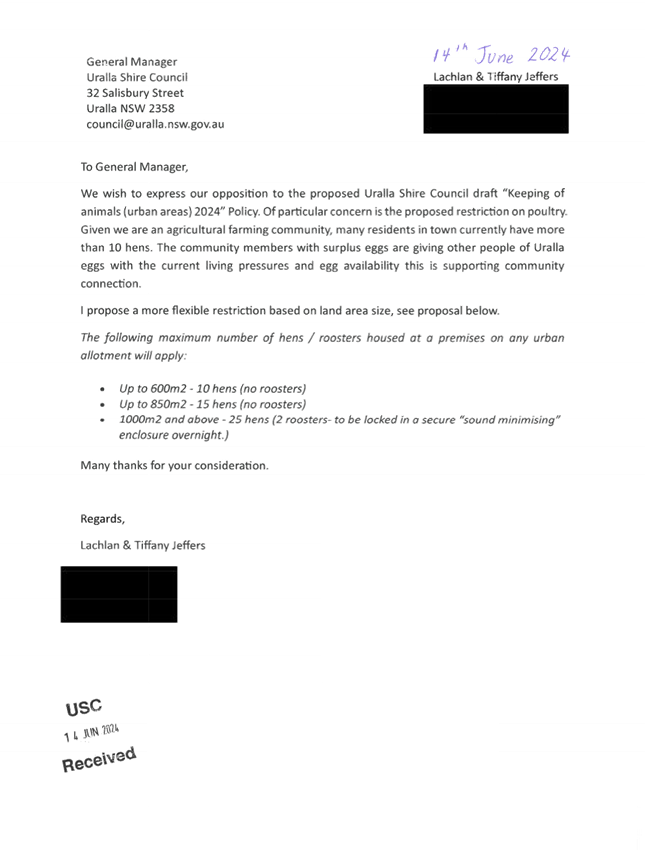
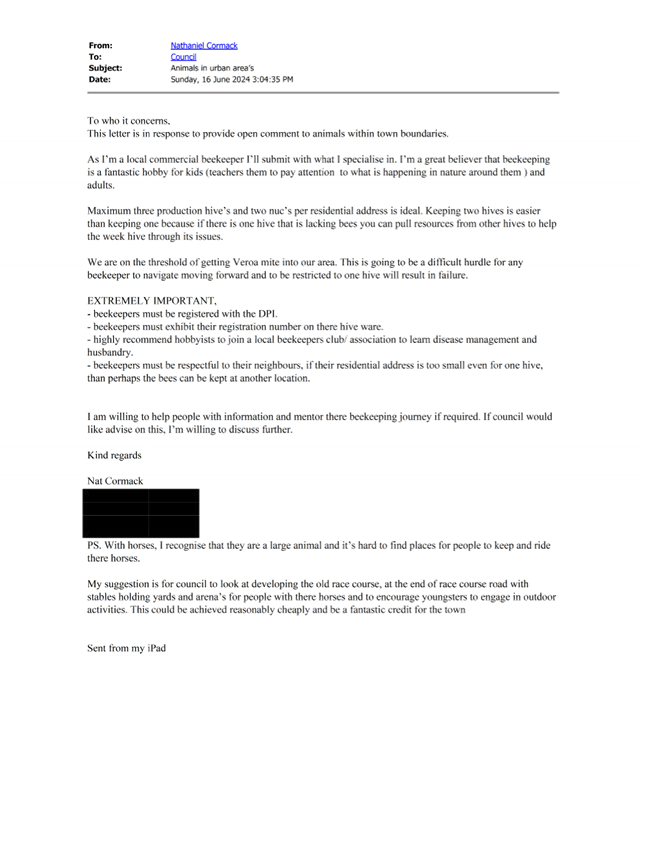
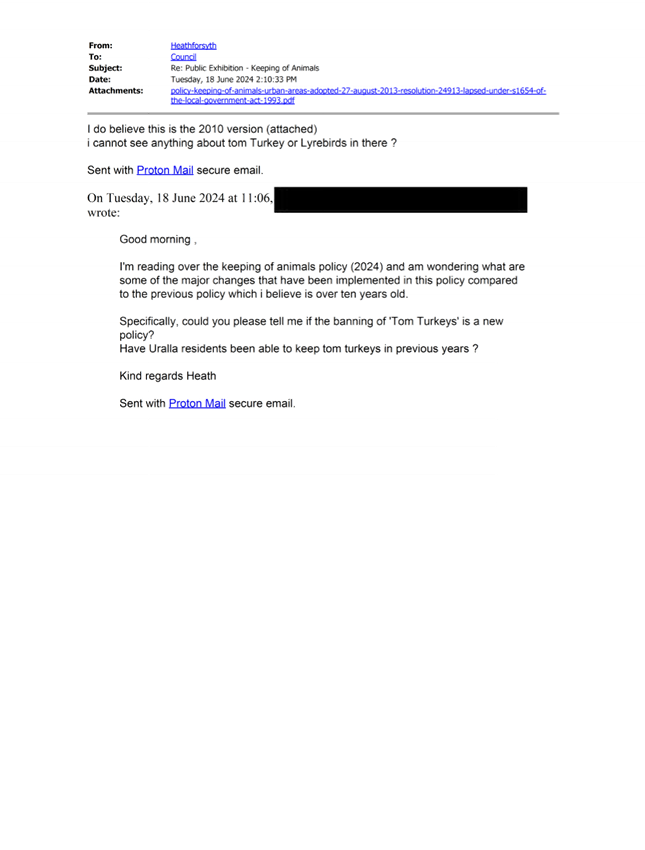
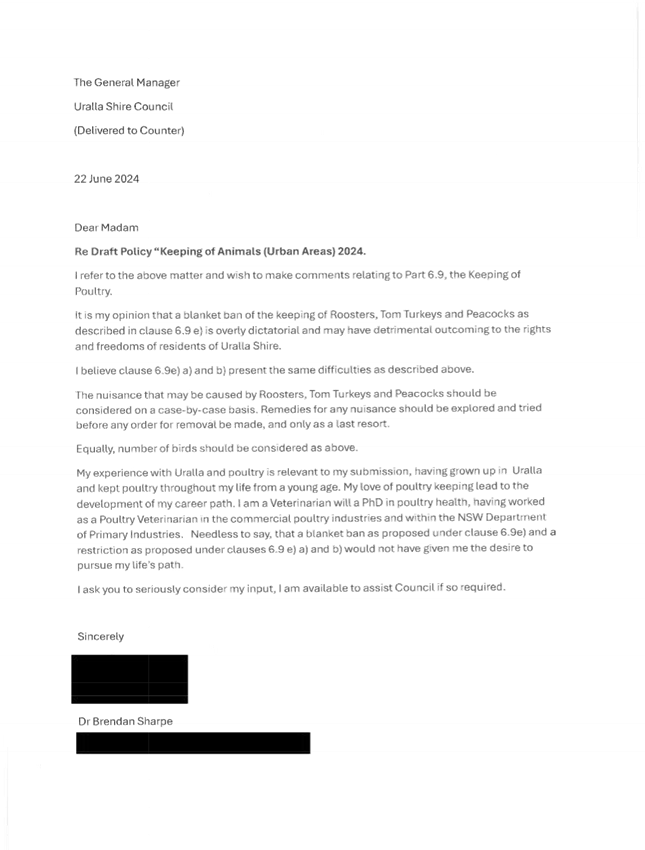
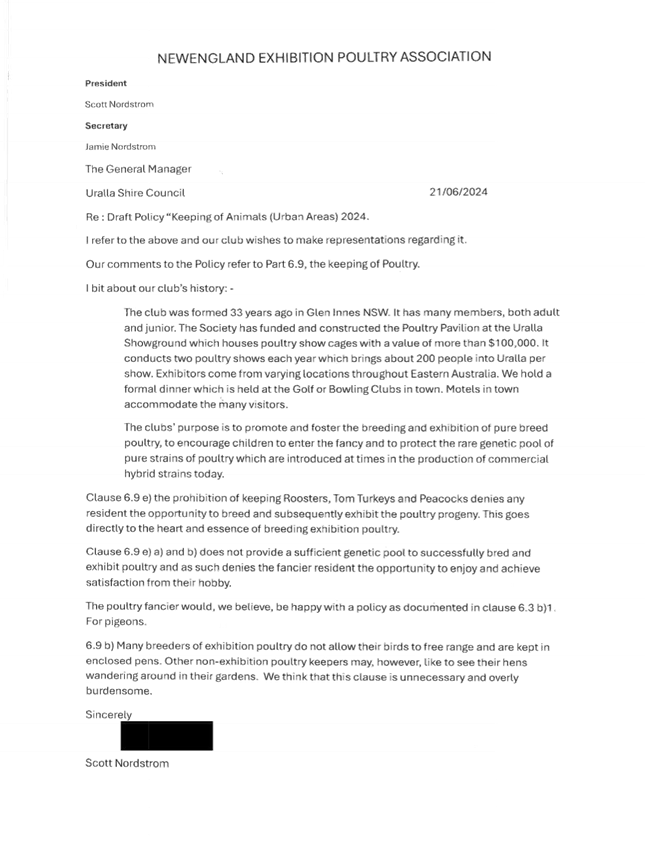
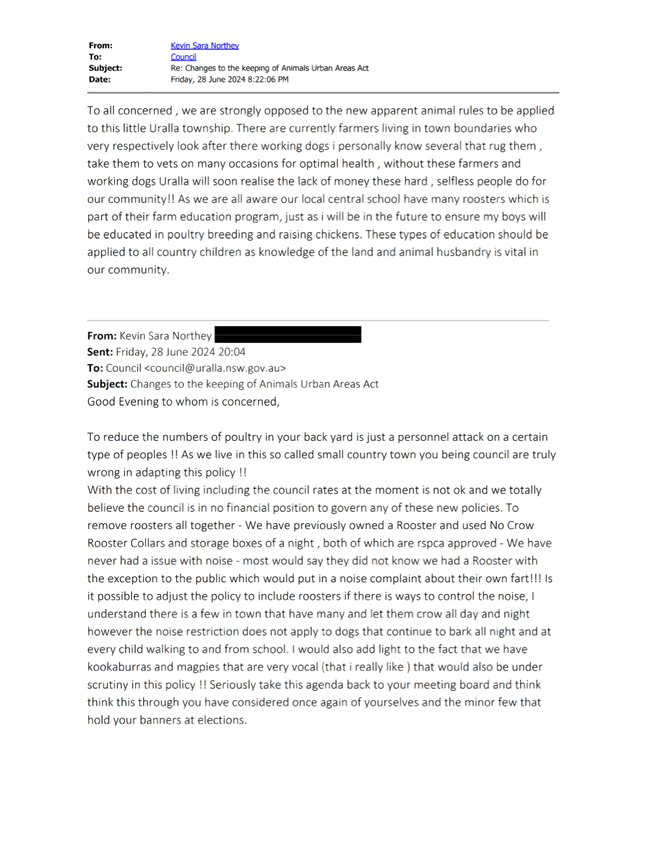
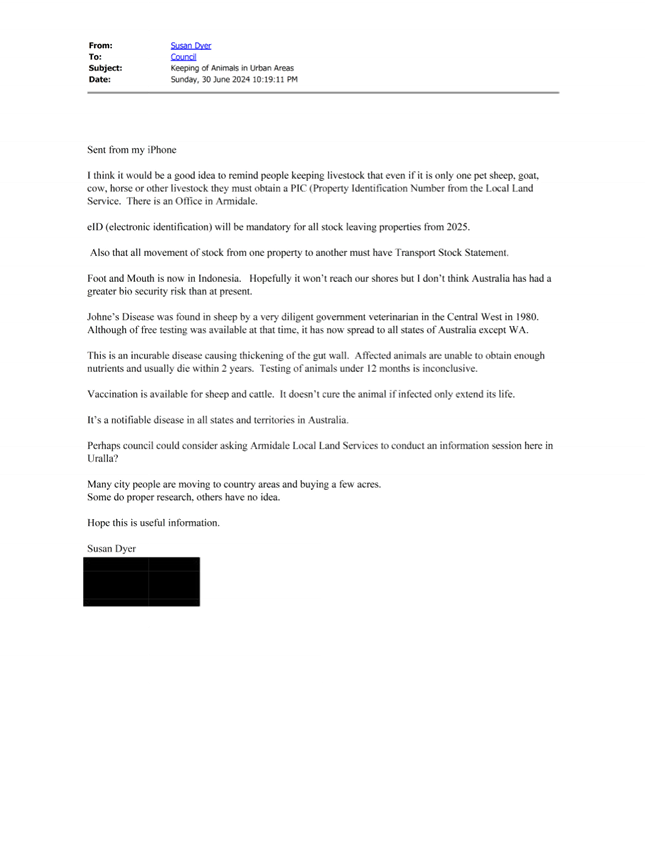
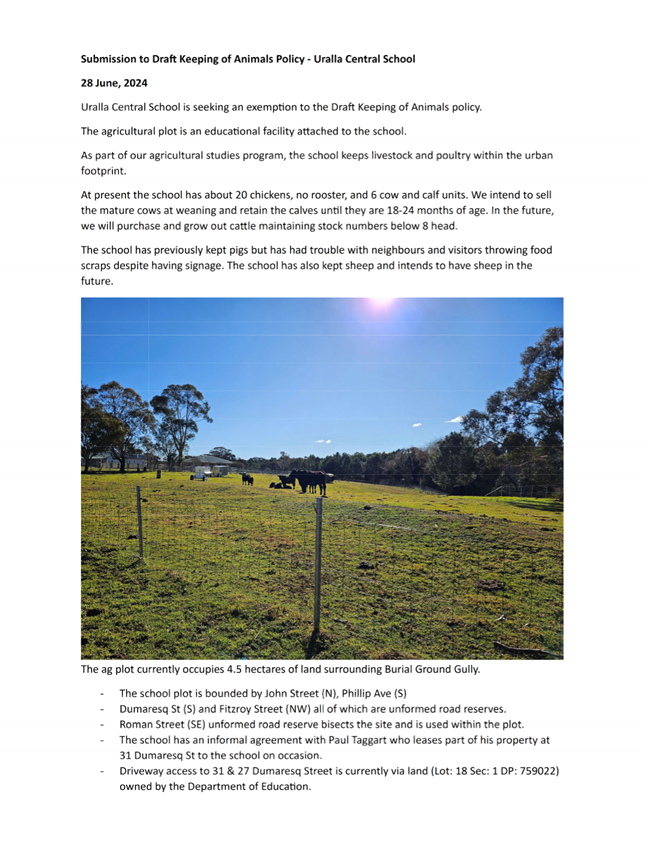
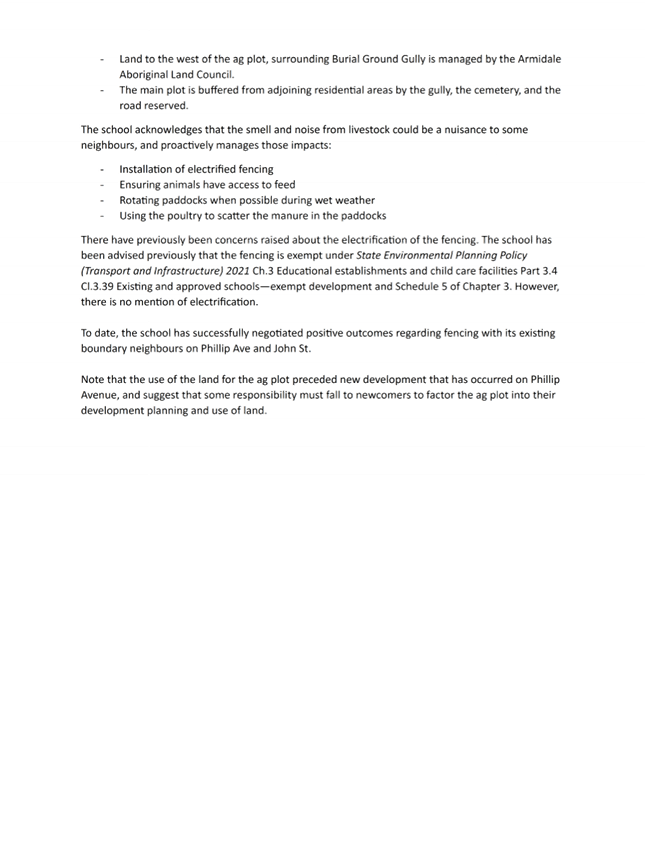
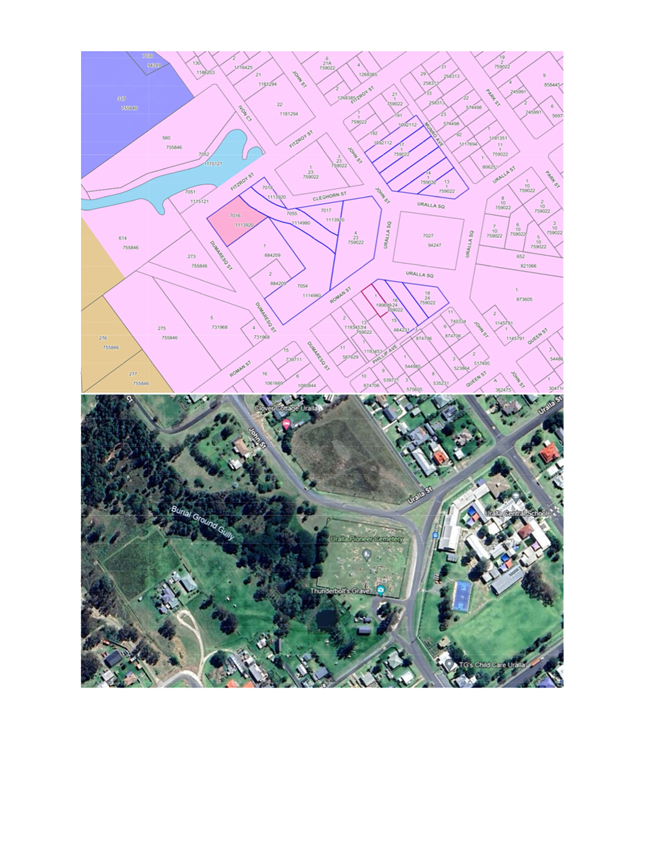
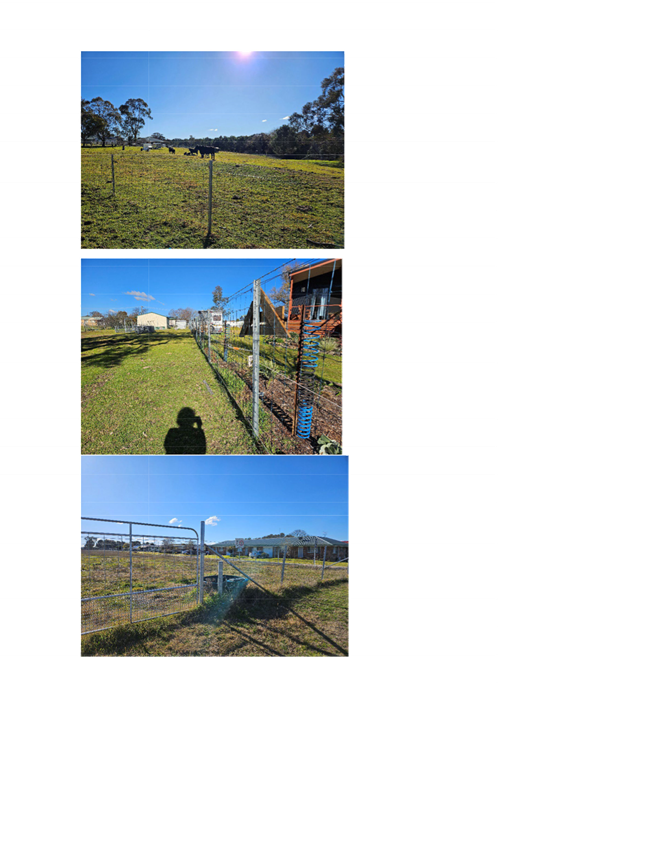
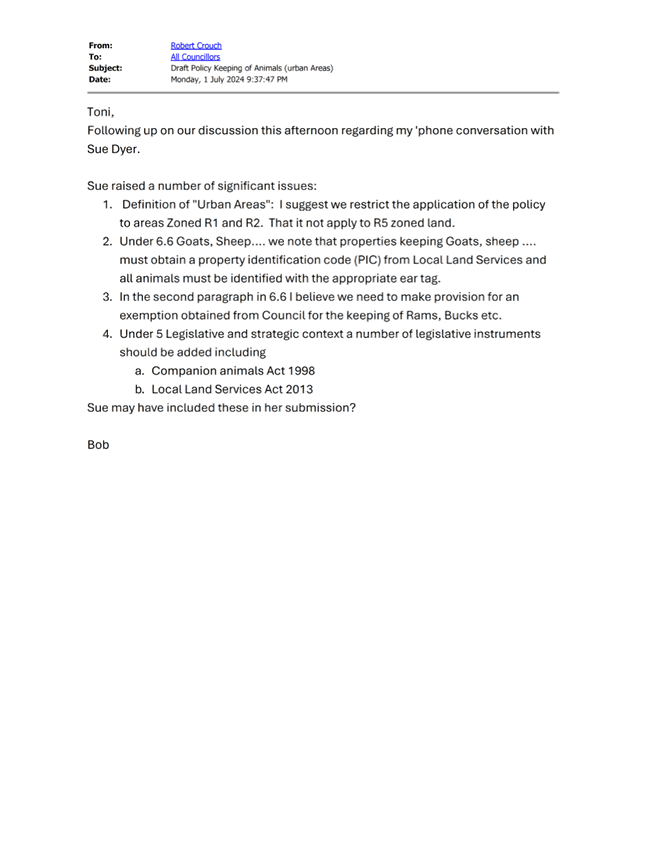


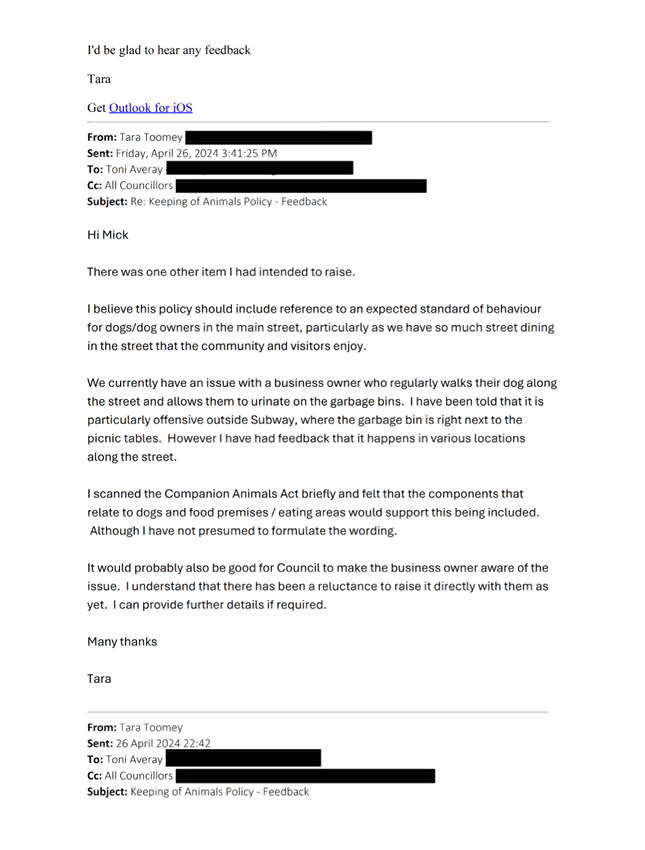
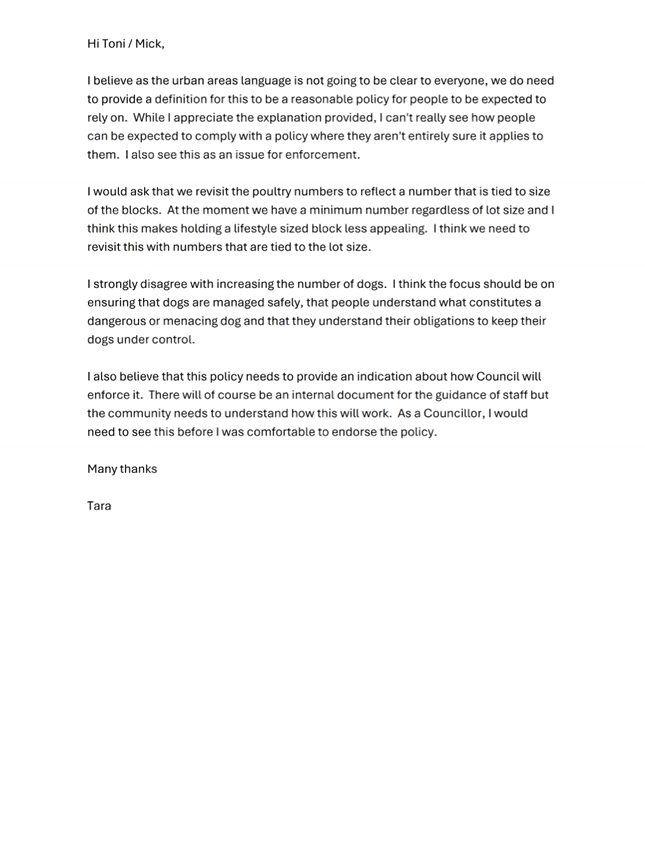
|
Ordinary
Council Meeting Business Agenda
|
17 December 2024
|
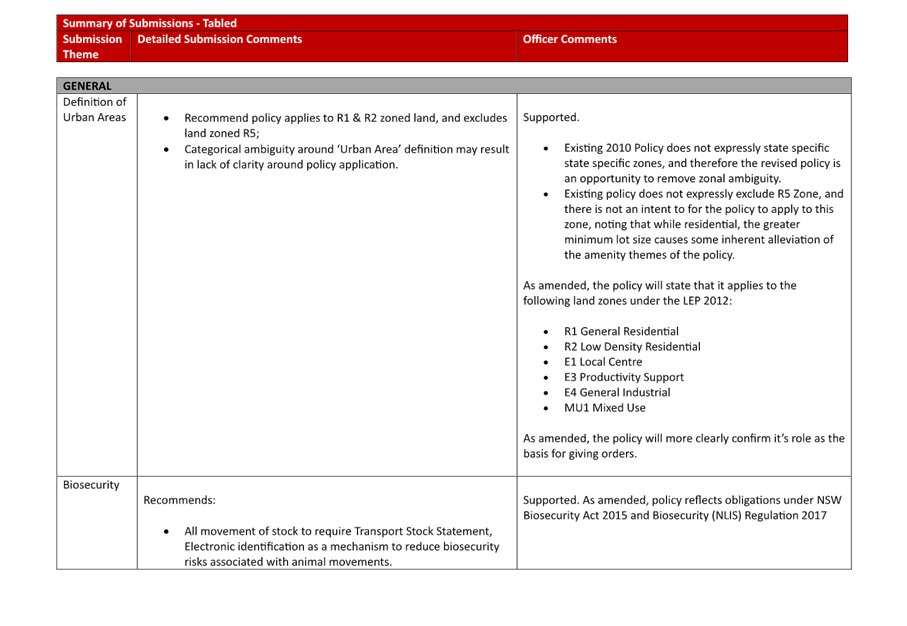
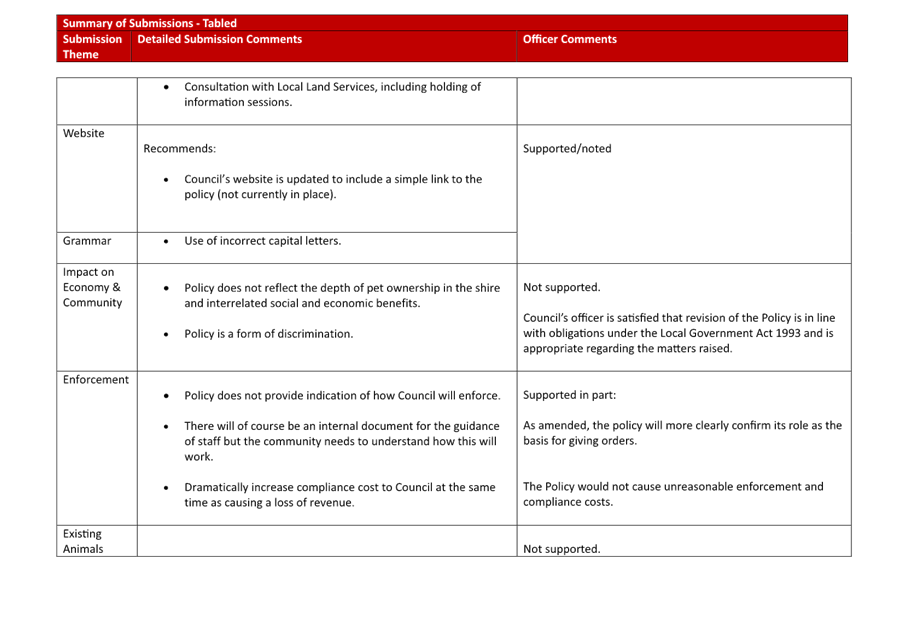
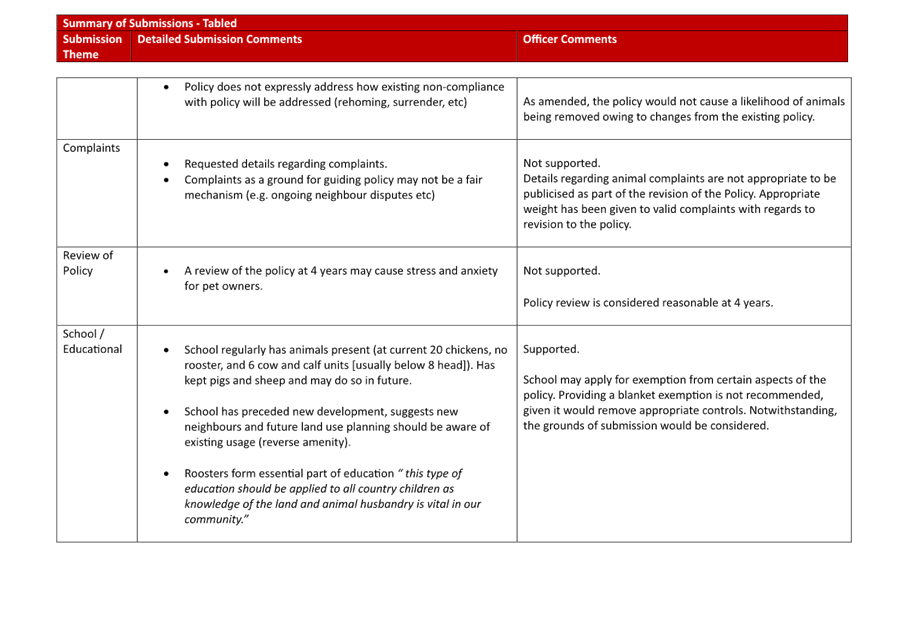
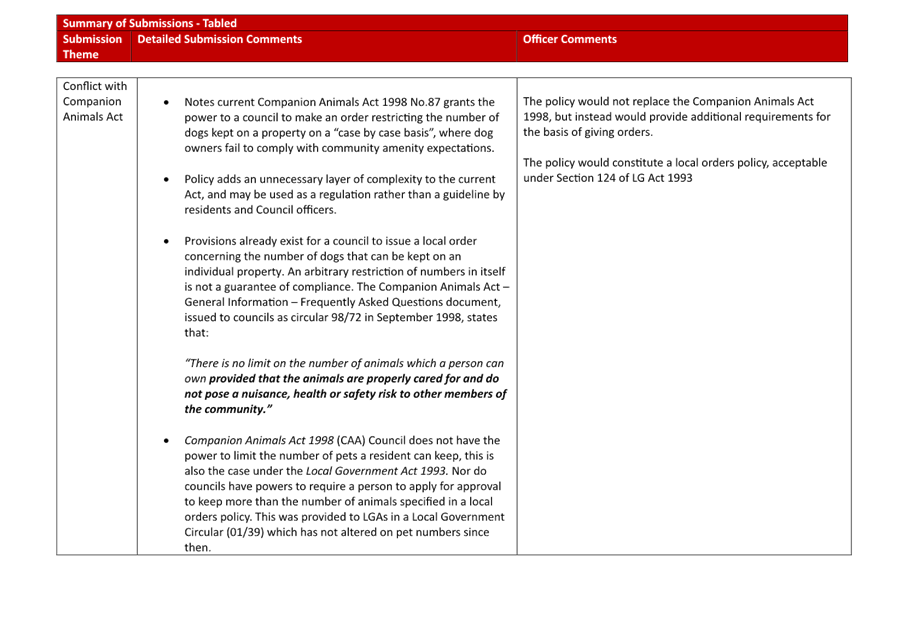
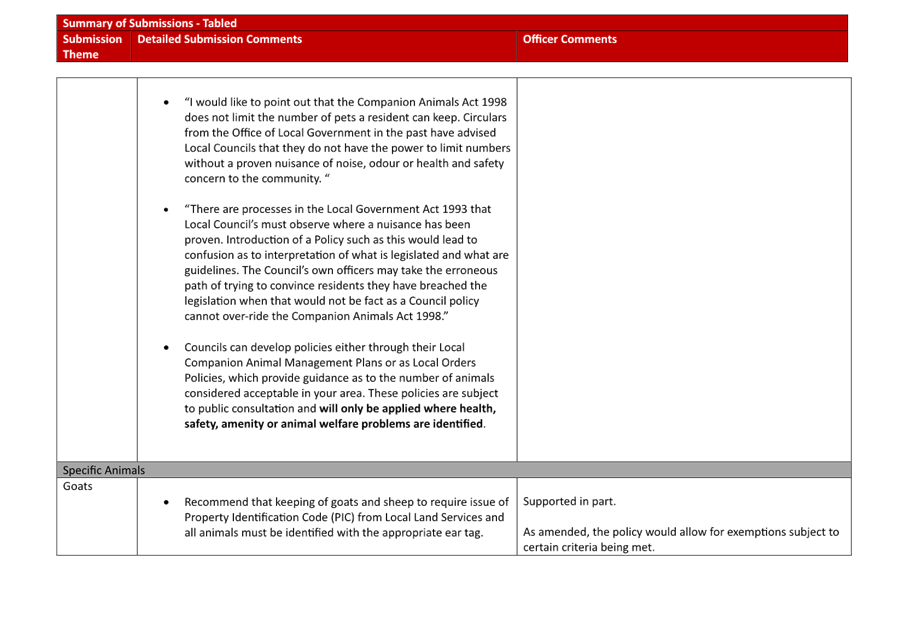
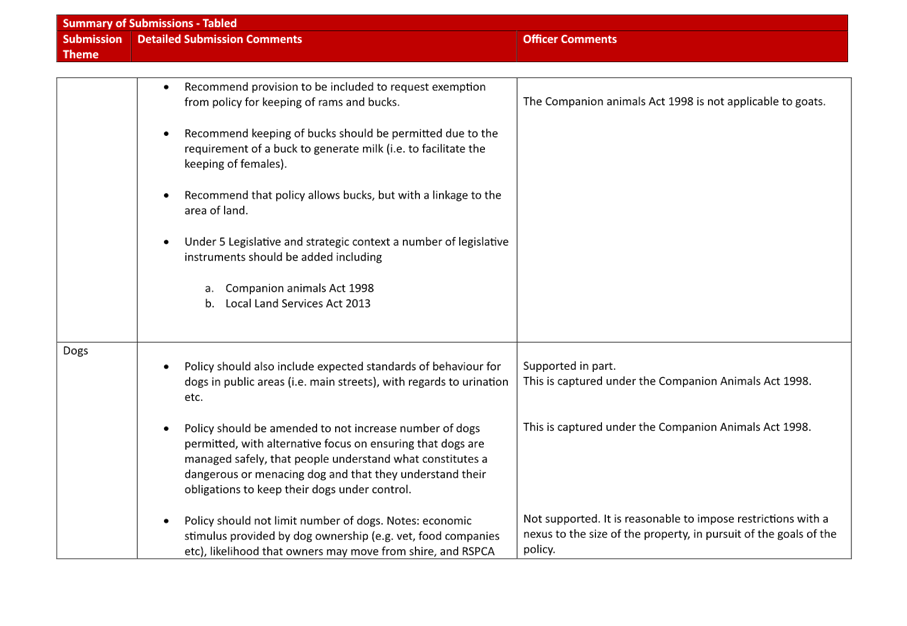
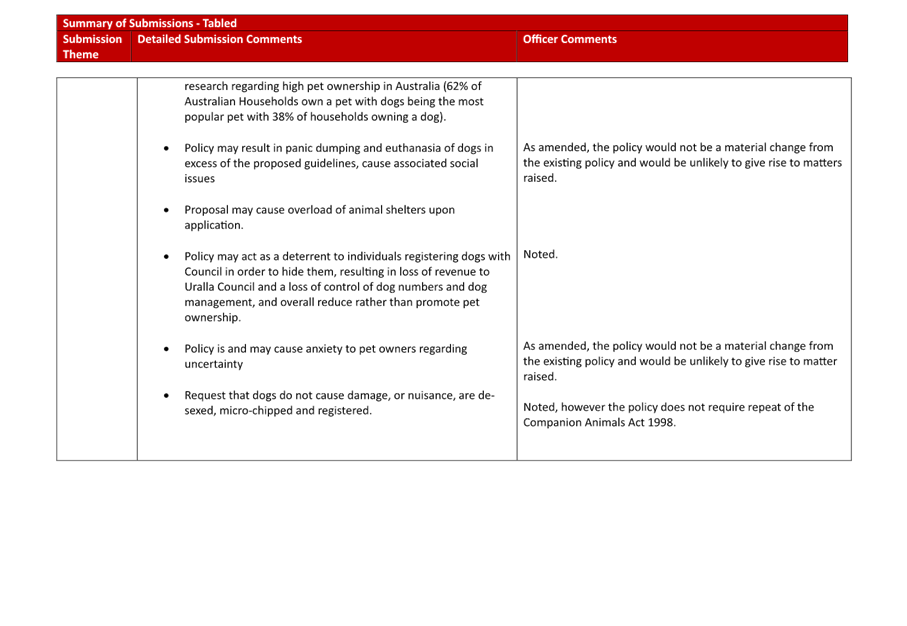
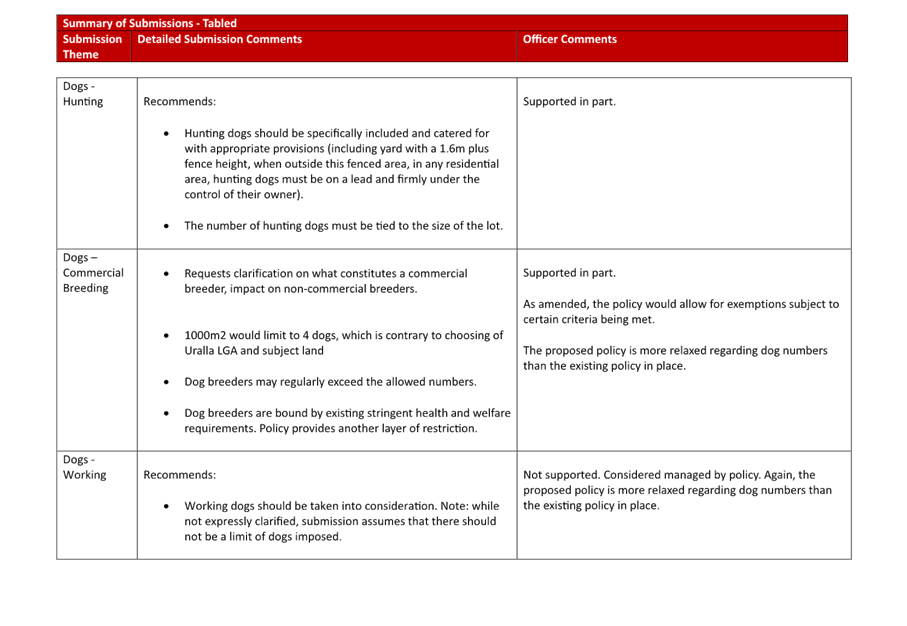
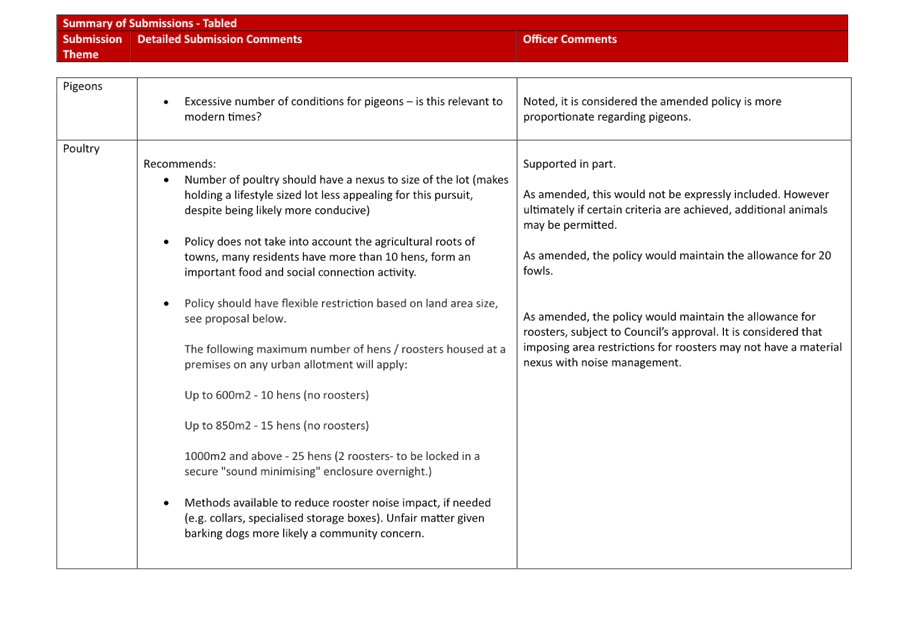
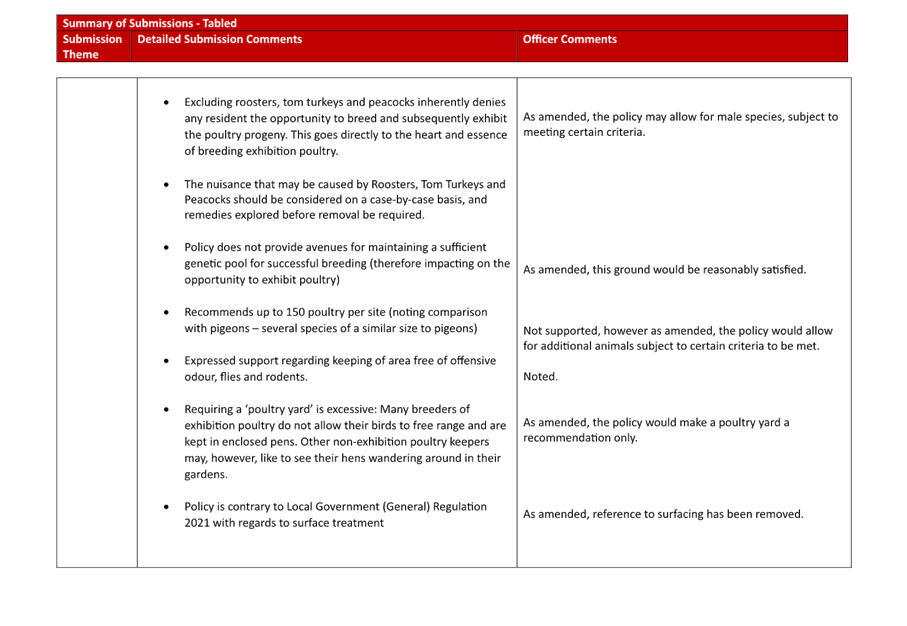
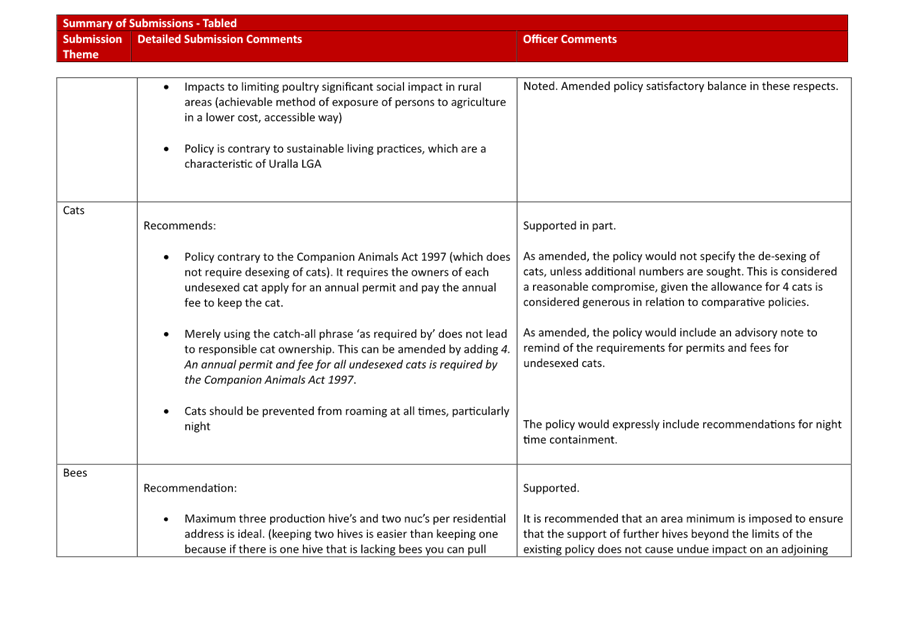
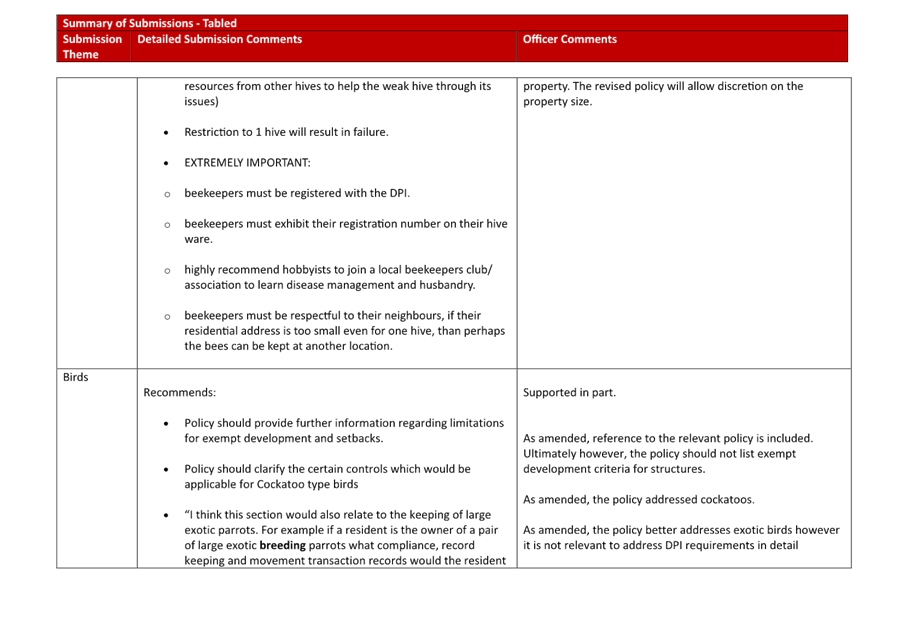
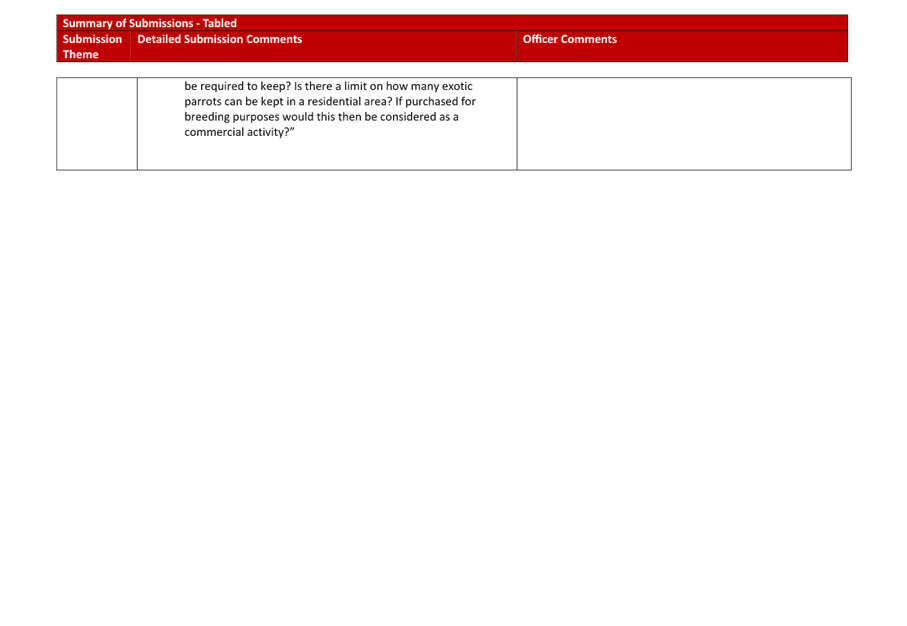
|
Ordinary Council Meeting Business Agenda
|
17 December 2024
|
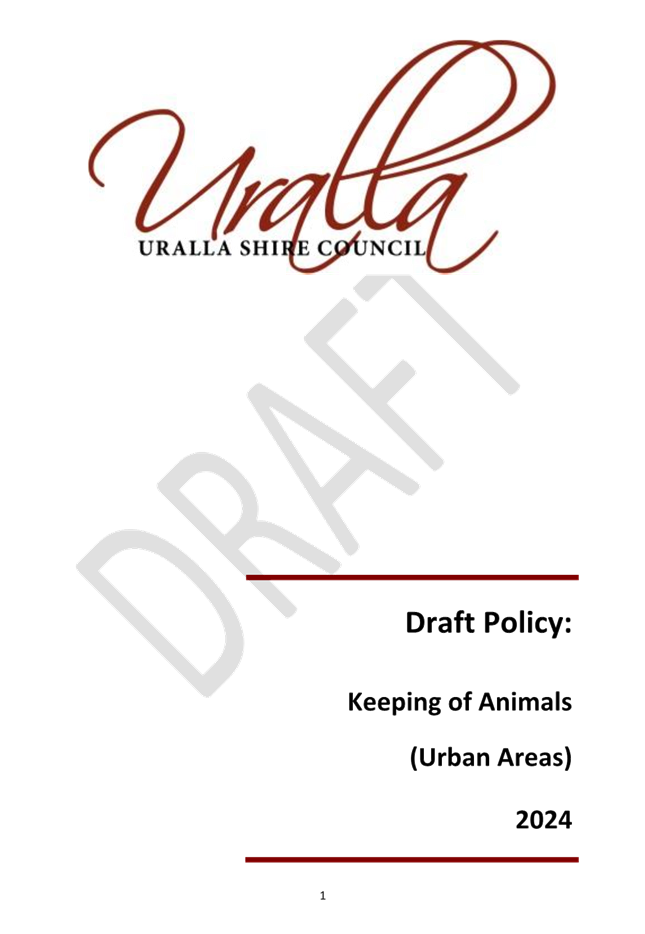
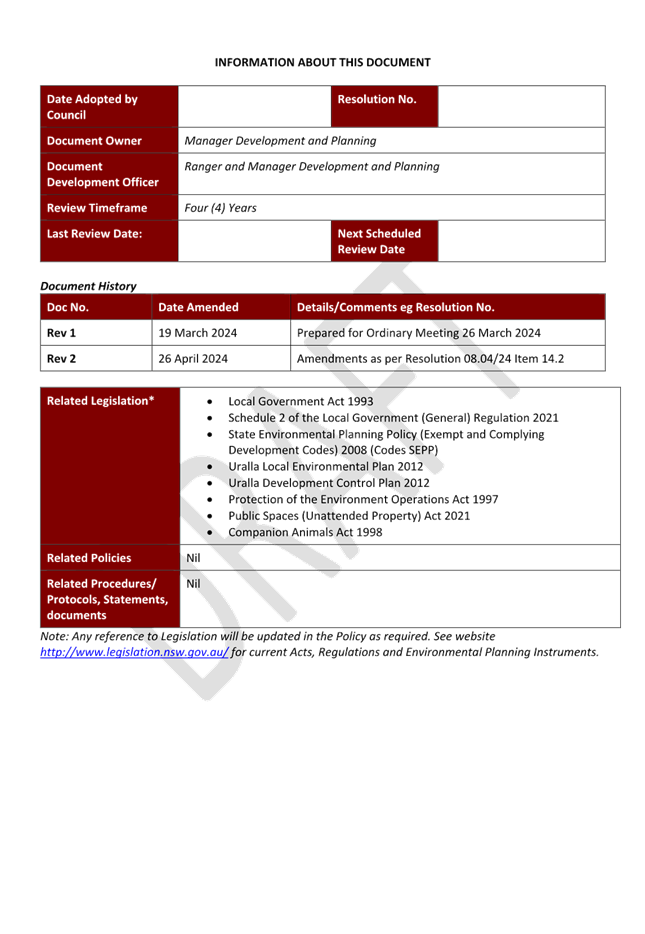
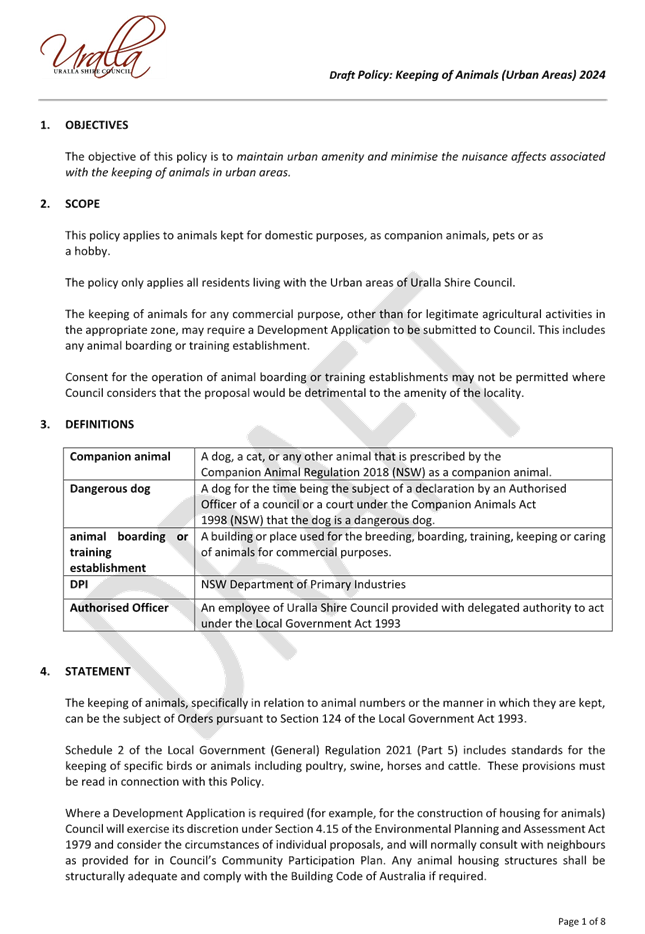
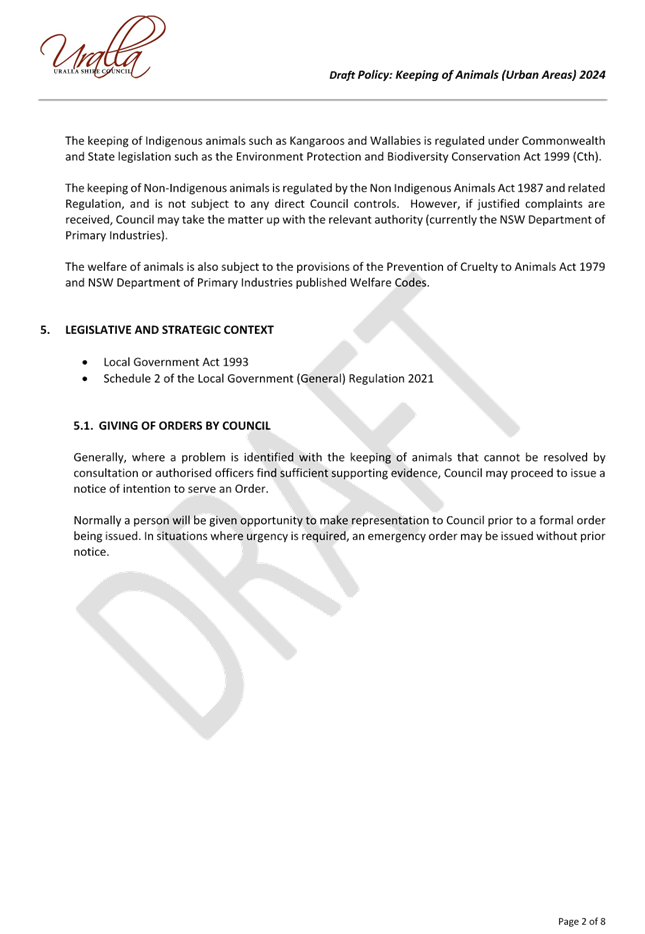
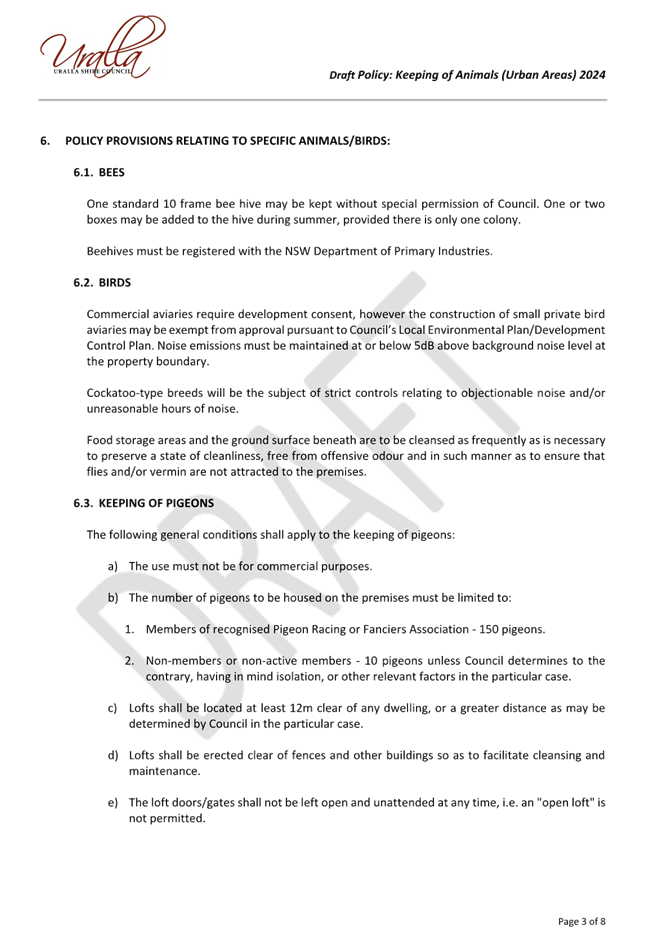
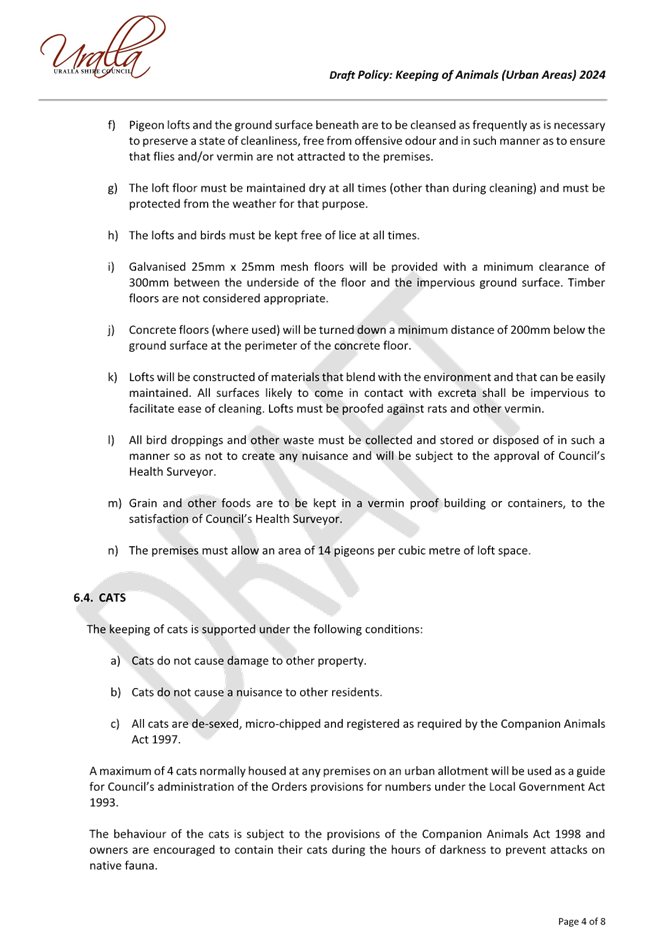
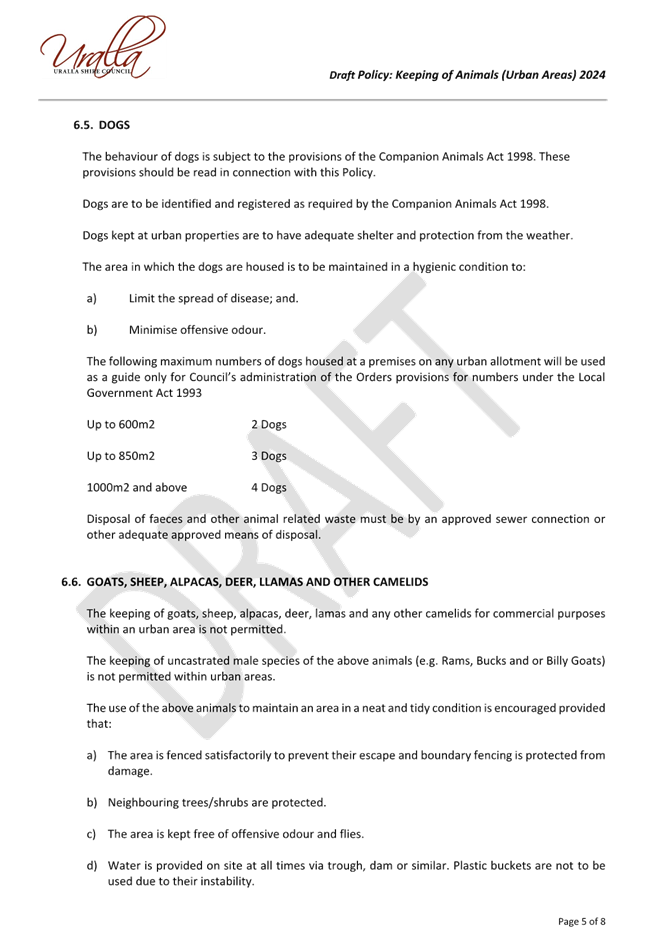
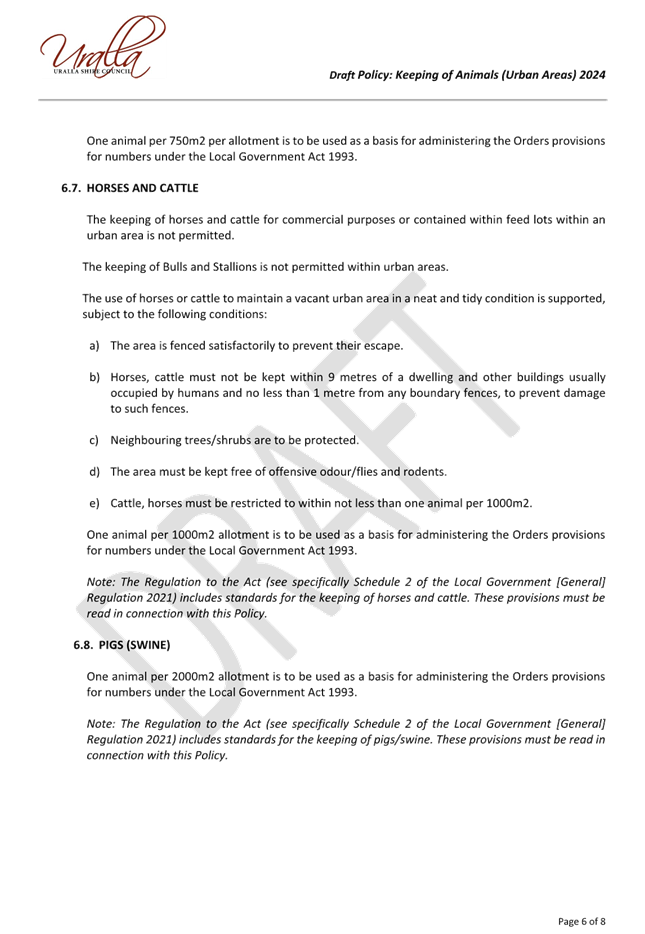
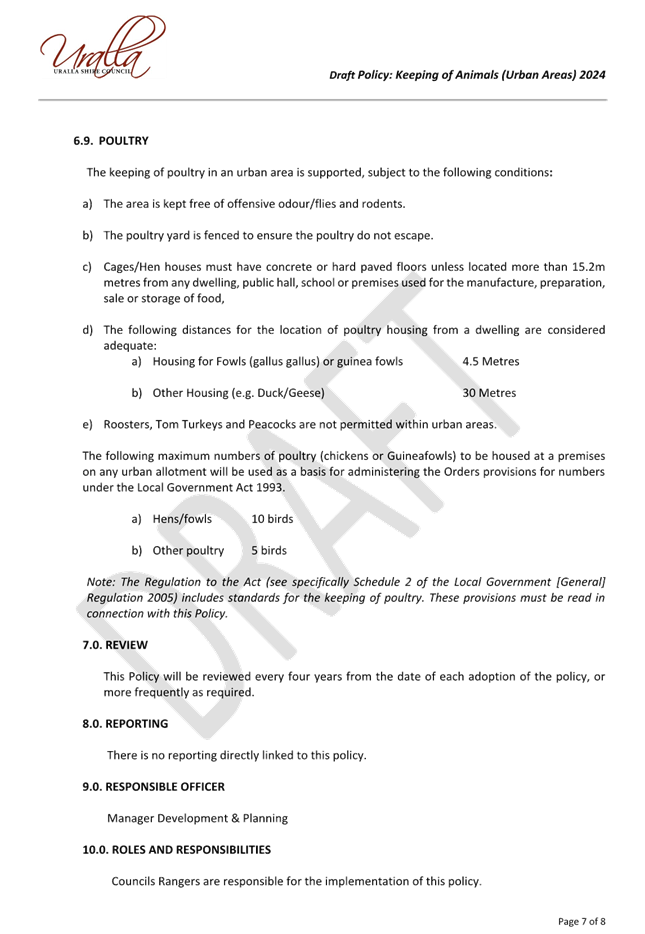
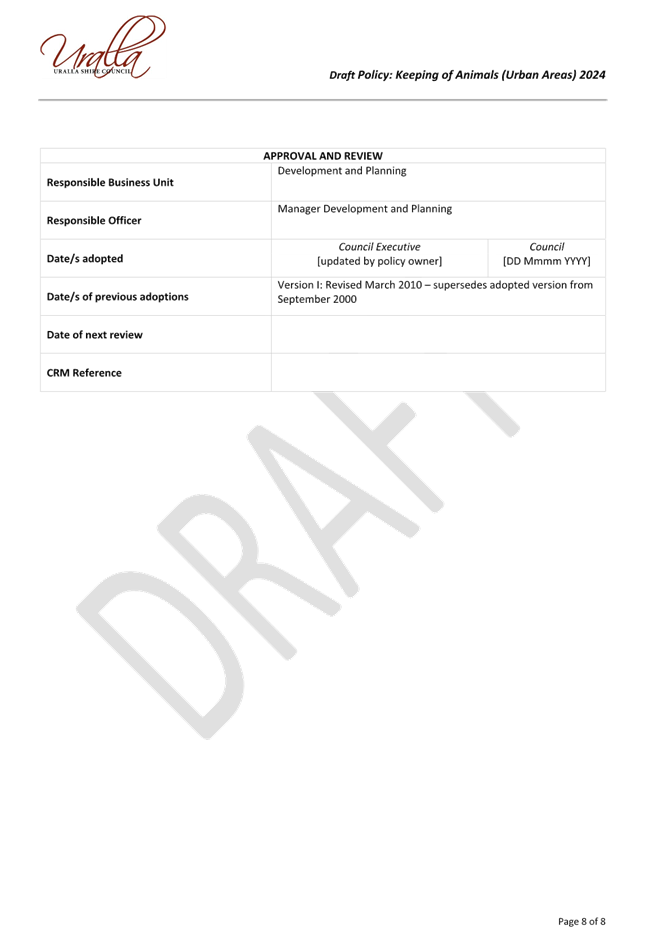
|
Ordinary Council Meeting Business Agenda
|
17 December 2024
|
14.4 EnergyCo
New England REZ) Community Reference group
|
Department:
|
Infrastructure &
Development
|
|
Prepared By:
|
Planning Officer Strategic
|
|
Authorised By:
|
General Manager
|
|
Reference:
|
UINT/24/20328
|
|
Attachments:
|
1. NE
REZ CRG terms of reference ⇩ 
|
|
LINKAGE TO INTEGRATED PLANNING AND REPORTING FRAMEWORK
|
|
Goal:
|
4. We
are an independent shire and well-governed community
|
|
Strategy:
|
4.1. Informed
and collaborative leadership in our community
4.3. An
efficient and effective independent local government
4.2. A
strategic, accountable and representative Council
|
Summary
EnergyCo have established a community reference group for
the New England Renewable Energy Zone (REZ) network infrastructure project.
Uralla Shire Council is offered a standing position on the reference group.
|
Recommendation
That Council nominate a Councillor as its representative
to EnergyCo’s New England Renewable Energy Zone transmission project
community reference group.
|
Report
1. EnergyCo’s
New England Renewable Energy Zone (REZ) network infrastructure project is
classified as Critical State Significant Infrastructure, designed to build
transmission lines connecting solar and wind farms in New England to the
electricity grid. The project Environmental Impact Statement (EIS) is being
developed for lodgement in late 2025.
2. To
facilitate community engagement, two community reference groups have been
established: one for REZ communities and another for areas between the REZ and
Bayswater.
3. These
groups serve as forums for discussions between EnergyCo, the community, and key
stakeholders about the project and broader REZ-related issues.
4. EnergyCo
has reserved a standing position for all Councils within the REZ on these reference
groups and has invited Uralla Shire Council to nominate a representative. The
intention is that the position is taken up by an elected representative (rather
than an officer). Participation is optional, but the reference group is one of
the formal means by which Council can provide feedback to the project.
5. The
groups are independently chaired, and the first meeting is scheduled for late
January.
Conclusion
Council is invited to nominate a representative to ensure
Uralla’s interests are considered in the REZ project’s development.
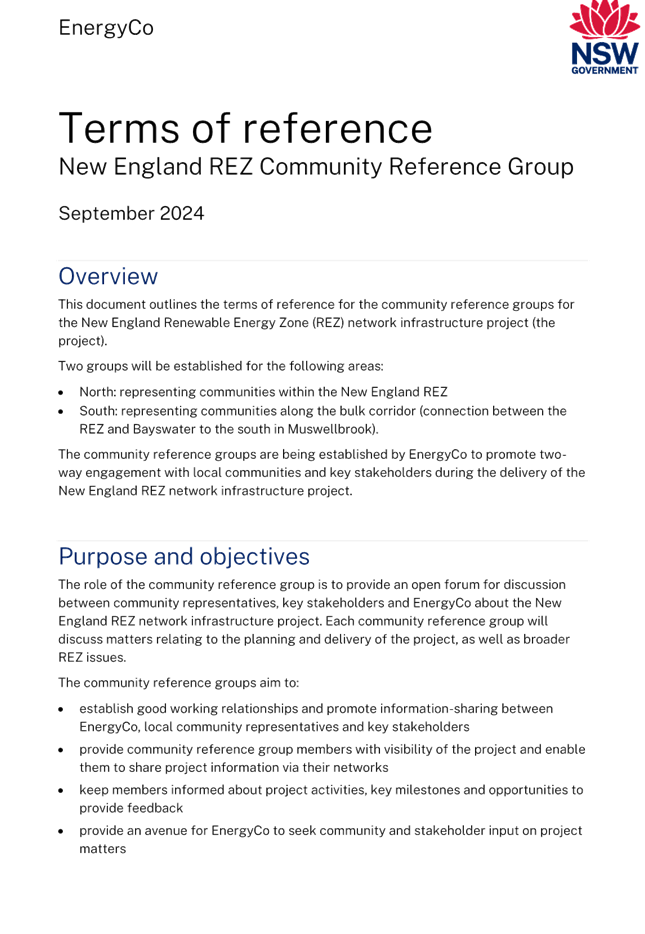
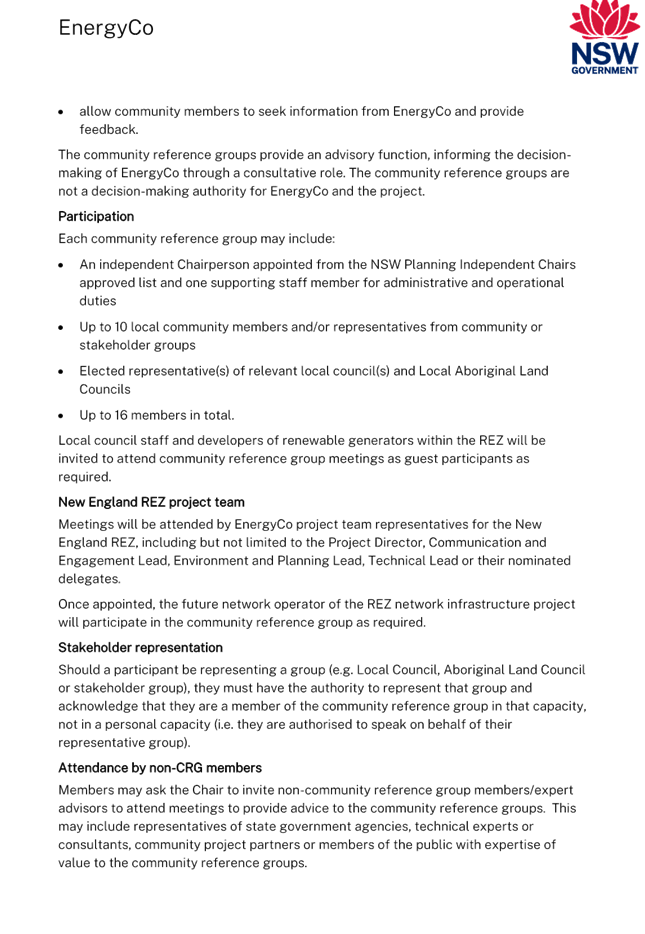
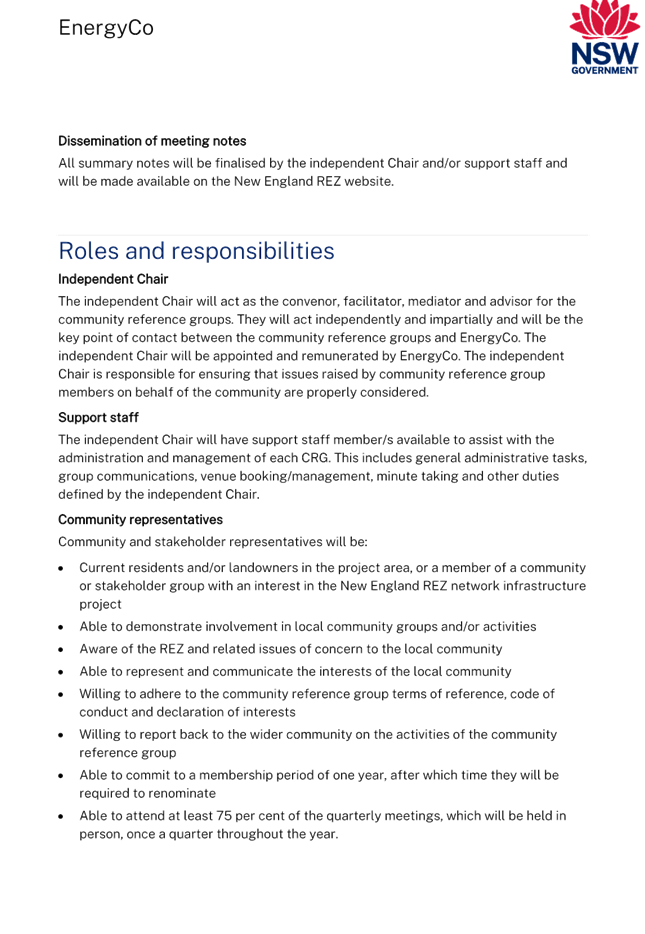
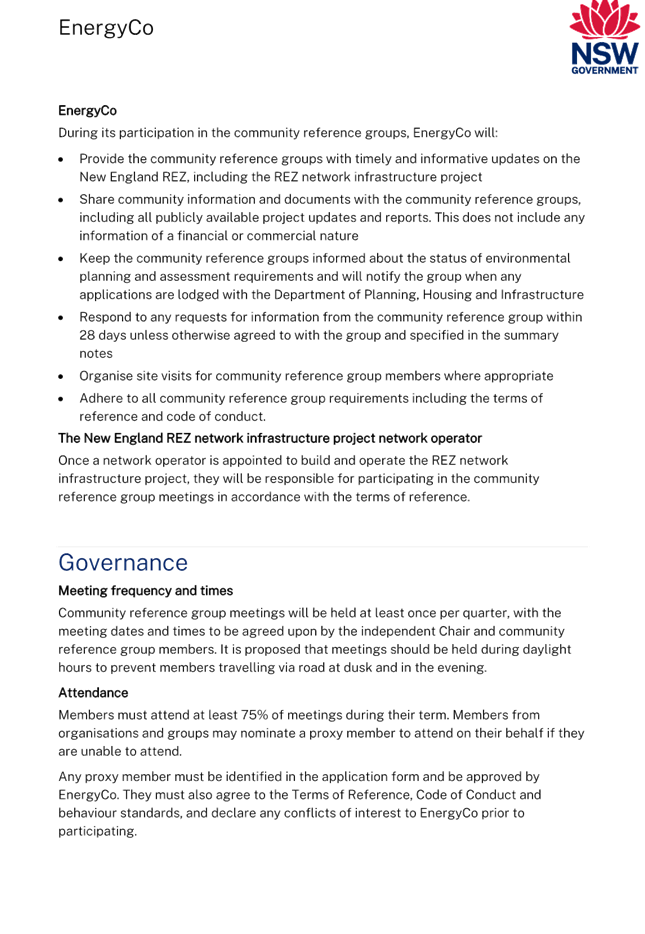
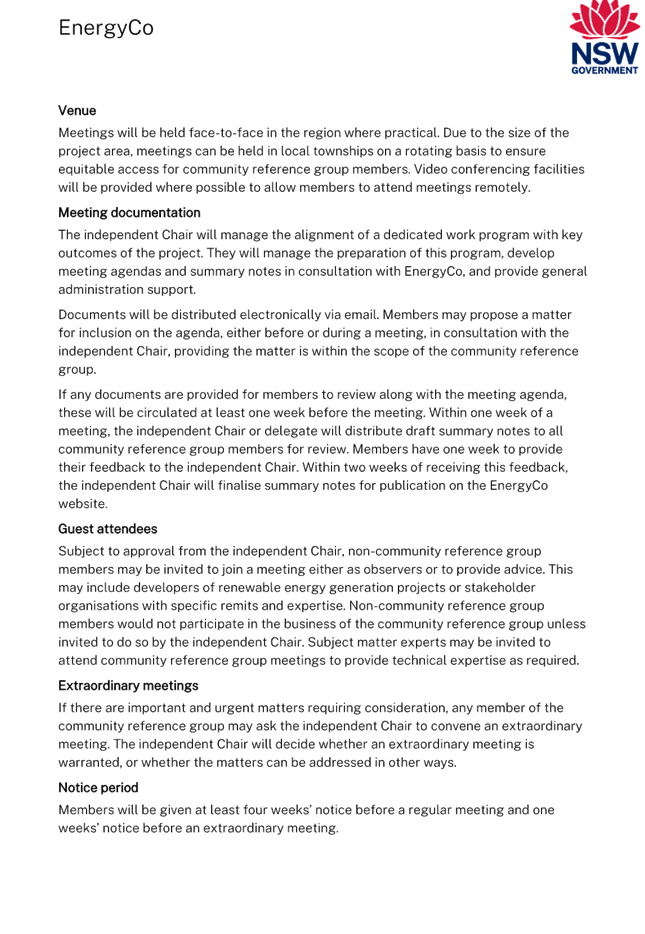
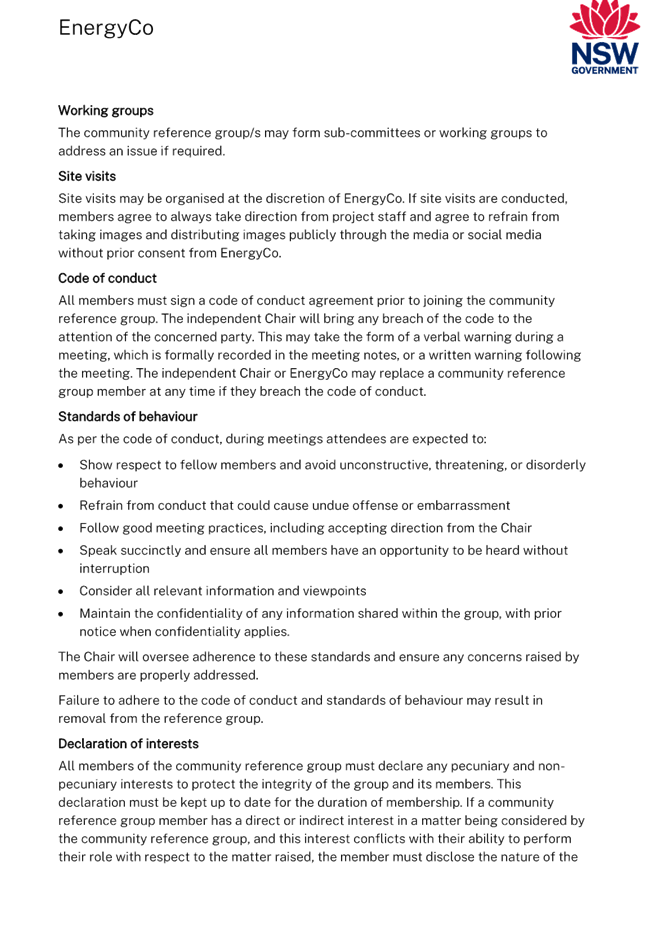
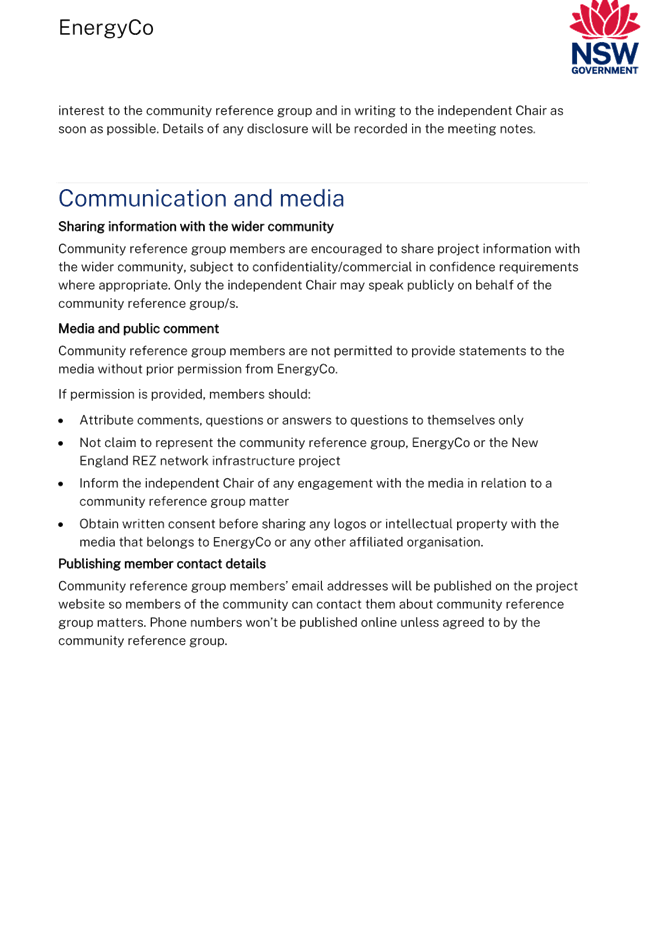
|
Ordinary Council
Meeting Business Agenda
|
17 December 2024
|
14.5 Community
Engagement Strategy
|
Department:
|
Infrastructure &
Development
|
|
Prepared By:
|
Planning Officer Strategic
|
|
Authorised By:
|
General Manager
|
|
Reference:
|
UINT/24/19885
|
|
Attachments:
|
1. DRAFT
Community Engagement Strategy & CPP 2024 ⇩ 
|
|
LINKAGE TO INTEGRATED PLANNING AND REPORTING FRAMEWORK
|
|
Goal:
|
4. We
are an independent shire and well-governed community
|
|
Strategy:
|
4.2. A
strategic, accountable and representative Council
4.1. Informed
and collaborative leadership in our community
|
Summary
This report outlines updates to the Community Engagement
Strategy (CES) and Community Participation Plan (CPP) as required under the Local
Government Act 1993 and Environmental Planning and Assessment Act 1979.
Key changes include:
· Integrating the
CPP into the CES to create a unified framework.
· Simplifying
language and expanding engagement tools
· Updating criteria
for public notification and referral of Development Applications (DAs).
The revisions align Council processes with statutory
requirements and improve the clarity and accessibility of the existing
Strategy.
|
Recommendation
That Council endorses the revised Community Engagement
Strategy for public exhibition for a period of 36 days.
|
Report
Under Section 402A of the Local Government Act 1993,
Council is required to develop and implement a strategy for community
engagement when creating plans, policies, and programs, and for determining
activities. The Community Engagement Strategy (‘the Strategy’) must
be reviewed every four years, within three months of an election.
Uralla is entering a period where frequent community input
will be needed for projects like the Integrated Water Cycle Management project,
the Local Housing Strategy, and a review of the Community Strategic Plan.
It is acknowledged that our approach to community engagement
may evolve as Council collaborates with community development specialists,
particularly through the Striking a New Deal initiative, which supports
our response to the rapid growth of renewable energy development in the Shire.
To ensure we meet statutory obligations, it is recommended
that Council adopts the revised Community Engagement Strategy and Community
Participation Plan (‘CPP’). This revision enhances the existing
framework considerably – particularly the CPP - by simplifying language,
reducing ambiguity, and streamlining decision-making processes.
Community Engagement Strategy
Council’s
existing Strategy was adopted in 2017 (resolution 12.02/15) and was due for
review in 2022. A light revision was drafted in 2022 (but not tabled) forms the
basis of the 2024 review. An overview of the update is provided in Table 1
below.
Table 1:
Community Engagement Strategy - Comparison of Existing and Revised Content
|
Aspect
|
Existing
|
Revised
|
|
Integration of Documents
|
Standalone
document.
|
Includes the
CPP as an appendix for a unified engagement framework.
|
|
Engagement
Levels
|
Breaks down each IAP2 level
with strategies described in each category: Inform, Consult, Collaborate,
Empower (IAP2 principles)
|
More accessible
presentation of IAP2 levels with examples in each category and a stand-alone
section on methods of engagement.
|
|
Language Simplification
|
Example: Engagement
will be undertaken where there is an opportunity to influence outcomes.
|
Revised: We
will engage when the community can influence decisions.
|
|
Feedback
and Evaluation
|
Limited mention of
feedback: Council will consider community input in decision-making.
|
Detailed process: Council
will provide feedback to explain how input was used and evaluate engagement
effectiveness.
|
|
Engagement Tools
|
Listed general
tools like newsletters, media, and events.
|
Added digital
tools (social media, interactive videos), expanded traditional tools
(listening posts, targeted mail).
|
Engagement Matrix
The Engagement Matrix is an operational part of the
Strategy, frequently used by Council officers to guide when and how engagement
should occur.
It has been updated for clarity and with more modern
engagement tools (Table 2). Additionally, some instructions have been recoded.
For example, social media posts will be required more frequently, media
releases will be used less often. These changes reflect the evolving role of
communication channels in public engagement.
Table 2:
Engagement Matrix - Comparison of Existing and Revised Content
|
Aspect
|
Existing Engagement Matrix
|
Revised Engagement Matrix
|
|
Categorisation
of projects
|
Projects categorised
into:
· Shire-wide / High
Impact
· Shire-wide / Low Impact
· Locality-based / High
Impact
· Locality-based / Low
Impact.
|
Categories remain
unchanged, retaining the same structure for alignment with project types.
|
|
“Inform”
Tools
|
Included tools like newsletters,
Council website, newspaper ads, media releases, and letterbox drops.
|
Adds:
· Social Media: Increased emphasis on platforms to
extend communication reach.
· Council Newsletter: foreshadows establishment of
Council email newsletter
|
|
“Consult”
Tools
|
Tools included public
exhibitions, forums, surveys, and site meetings.
|
Adds:
· Listening Posts:
Councillors and staff host informal discussions at local venues.
|
|
“Collaborate”
Tools
|
Methods focused on reference
groups, large stakeholder meetings, and advisory committees.
|
Adds:
· Co-design Workshops: Collaborative planning with stakeholders.
· Focus Groups
· Reference Groups
· Advisory Committees
|
Community Participation Plan
The CPP forms part of the Community Engagement Strategy and
is a requirement under the Environmental Planning and Assessment Act 1979
(EP&A Act). It must meet the minimum community participation standards
outlined in Schedule 1 of the Act.
The CPP specifies when and how the public will be informed
or consulted on planning matters and the circumstances under which Council
becomes directly involved in planning decisions.
It provides clear guidelines for public notification and
participation in Council’s planning functions, including Development
Applications (DAs) and Strategic Planning documents. It also details how
decision-makers will explain their decisions and demonstrate how community
views were considered.
The 2024 revision introduces substantial changes to improve
the accessibility and utility of the CPP. It adopts a more flexible,
merit-based approach to determining which applications require notification,
moving away from rigid prescriptions, particularly for DAs where notification
is not mandated.
Previously, a single objection triggered Council review;
however, under the revised CPP, three or more objections will now be required
for referral to Council. This aligns with the proposed amendments to the
General Manager’s Instrument of Delegation, also the subject of a report
to this meeting. A quantitative measure, such as the number of objections, has
been chosen over a qualitative one, such as unresolved submissions, to remove
ambiguity in decision-making processes.
It is also noted that Council may still call for any
application to be reported to Council for decision notwithstanding the number
of submissions.
These changes are supported by clearer guidance on
submission requirements, ensuring that community feedback is relevant,
constructive, and focused on valid planning issues. The changes to the CPP are
summarised in Table 3 below:
Table 3:
Community Participation Plan - Comparison of Existing and Revised Content
|
Aspect
|
Existing CPP
|
Revised CPP
|
|
Integration
of Documents
|
CPP was a
standalone document.
|
Integrated into the
Community Engagement Strategy as an appendix, aligning planning participation
with broader engagement efforts.
|
|
Planning
Submission Process
|
Submissions required name, address,
and details of objections, but lacked detail on what constituted valid
issues.
|
Provides
guidance on relevant planning issues under Section 4.15 of the EP&A Act
(e.g., privacy, noise, overshadowing).
|
|
State Significant Development (SSD)
|
No specific
mention of State Significant Development processes
|
New section addressing SSD:
· Explains Council’s limited role in
assessing SSDs.
· Commits Council to assist and facilitate
community input on SSD proposals.
|
|
Notification
|
Requires notification where
impact is considered detrimental.
Prescribes
specific criteria for instances where notification is not required e.g., “ancillary structures …which are
sited 1m from any boundary, sited behind or in-line with the existing
building line and comply with council’s building setbacks”
Silent as to when a DA
might be advertised more broadly
|
Requires notification where
DA’s may affect adjoining land amenity.
Increases council
discretion and removes specific criteria.
Provides new guidance on
when a DA will be advertised more broadly.
|
|
Notification
Periods
|
“Public
exhibition for DAs will occur for a minimum of 14 days.”
|
Clarifies timing and methods for DA advertising, and adds
statutory timeframes for different types of applications e.g., designated
development
|
|
Referral to Council
|
“Development applications
that have had a written objection submitted will be referred to Council for
determination.”
|
Increases threshold for Council
referral and provides clear criteria for instances where delegated authority
will not be used:
· Applications with three (3) or more written
objections.
· Applications valued over $2 million.
· Subdivisions creating five or more additional lots.
· Applications subject to Division 8.2 review under
the EP&A Act.
|
|
Privacy
|
Privacy was
briefly addressed in submission processes
|
New guidance on the status of submissions under the
Government
Information (Public Access) Act 2009.
|
|
Speaking
at council meetings
|
No guidance on public
participation at Council meetings
|
New section outlines
opportunity to speak at Public Forum
|
Conclusion
The revised Community Engagement Strategy and Community
Participation Plan meet statutory requirements and streamline engagement
processes. Adoption following appropriate exhibition and consultation will
support upcoming projects and strengthen the framework for community
participation.
|
Ordinary Council Meeting
Business Agenda
|
17 December 2024
|
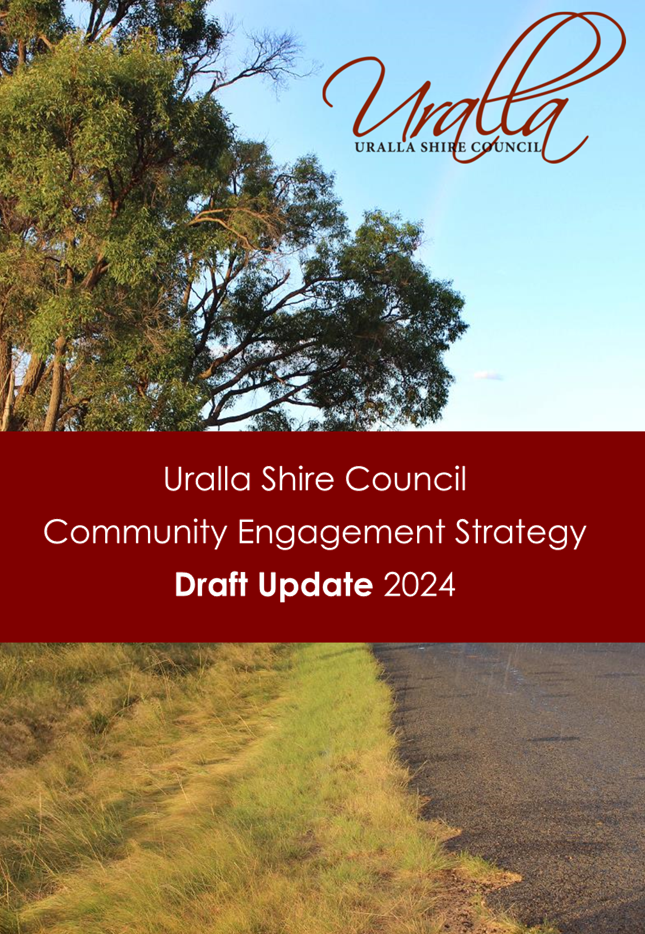
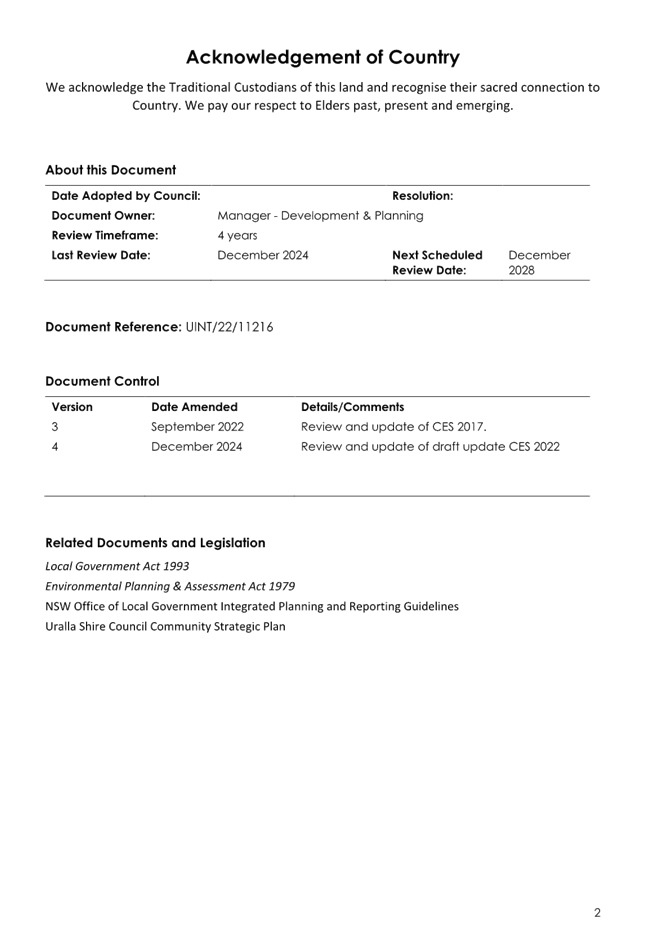
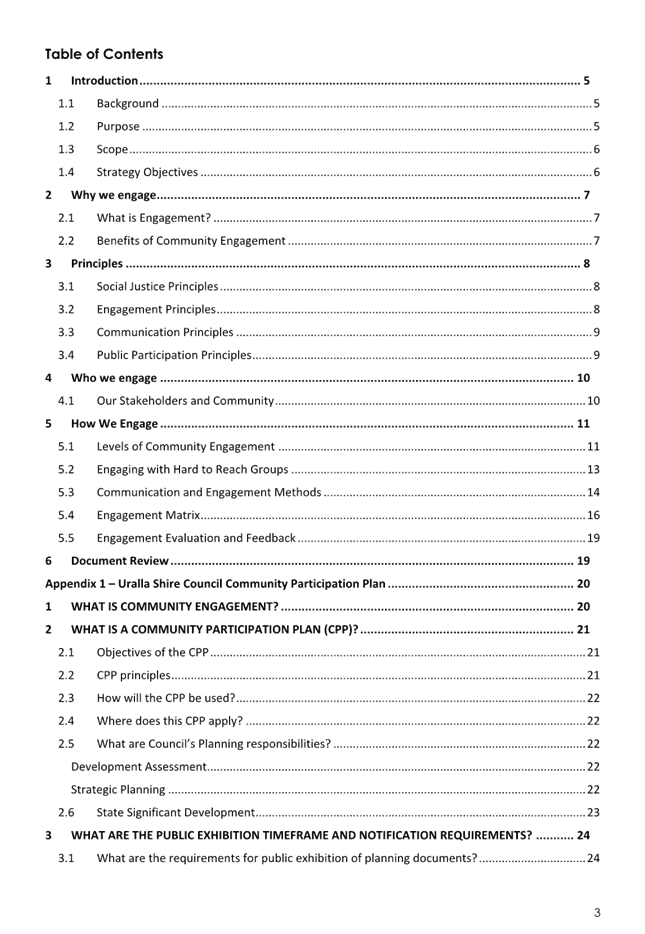

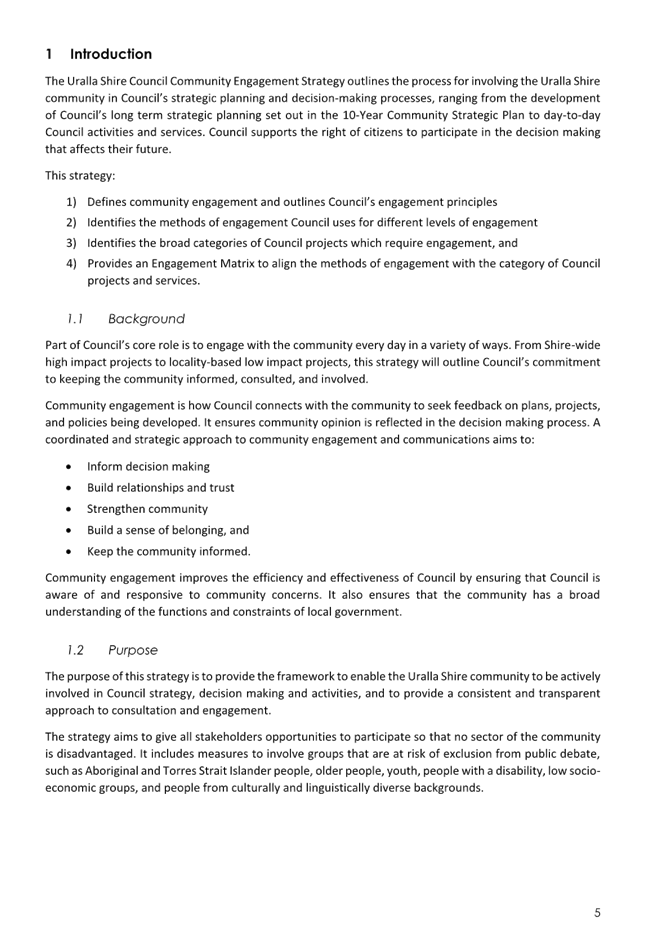
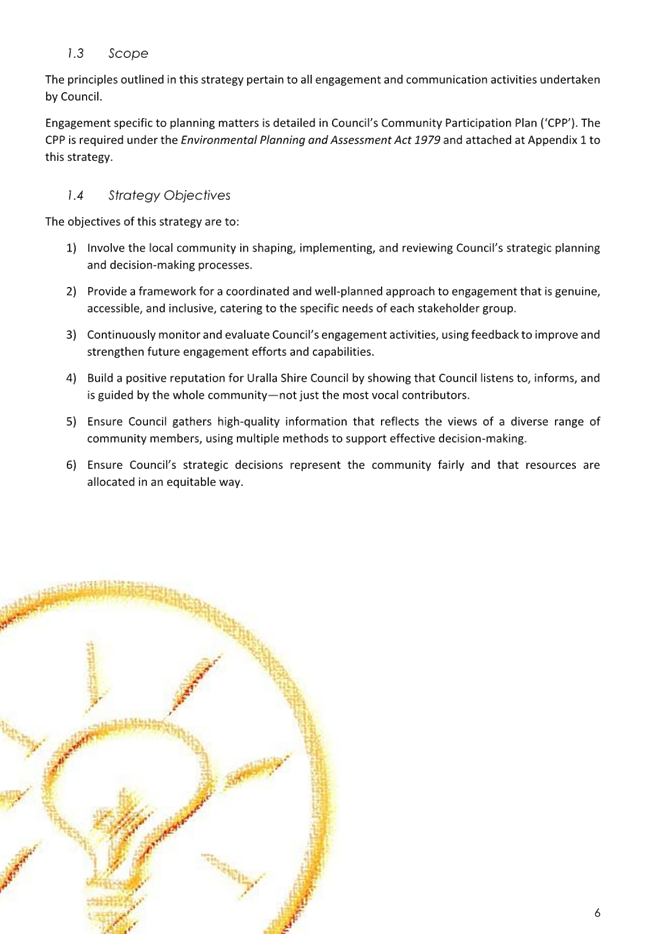
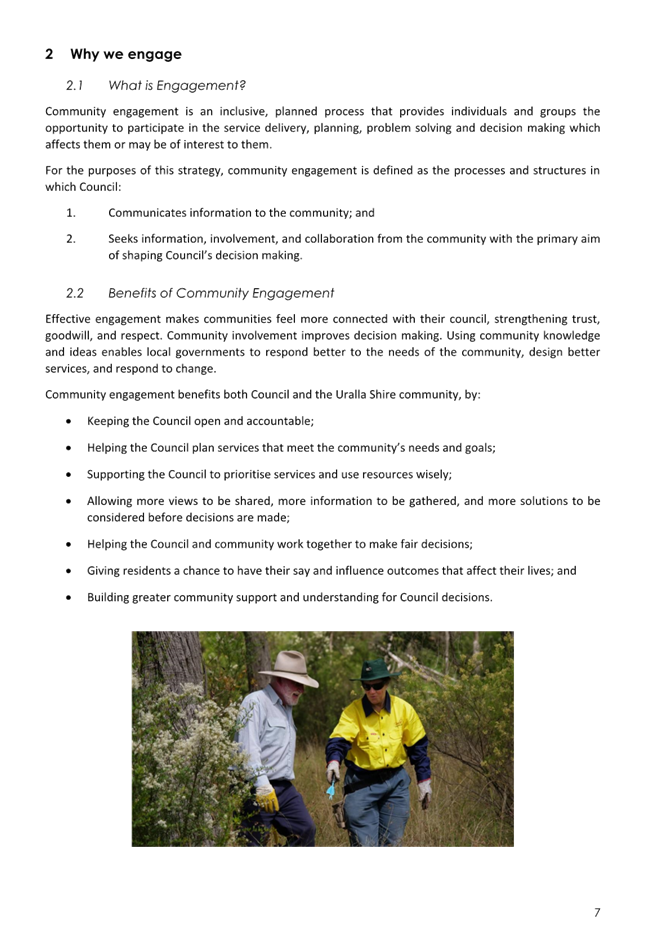
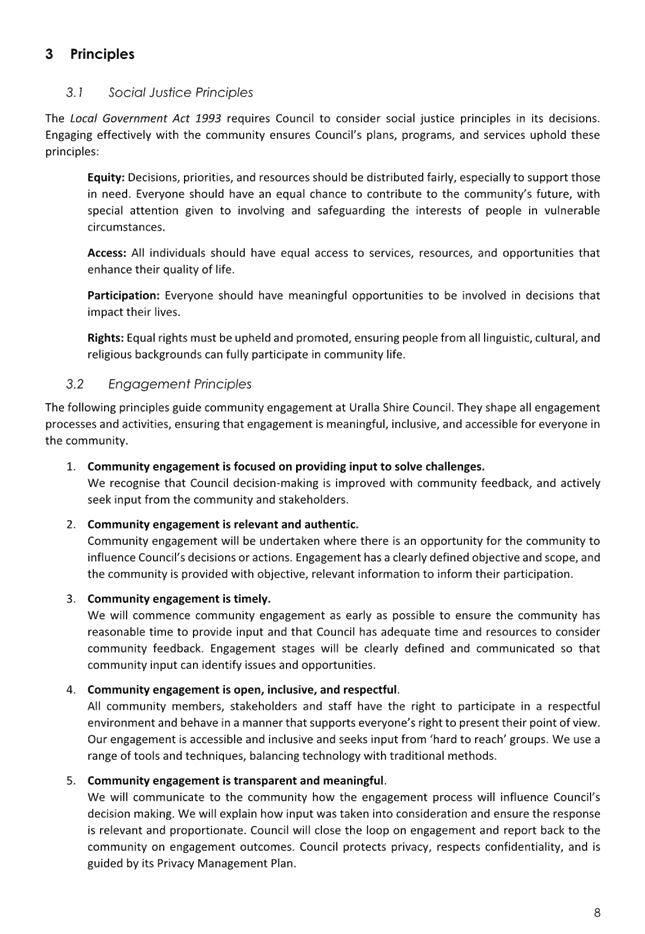
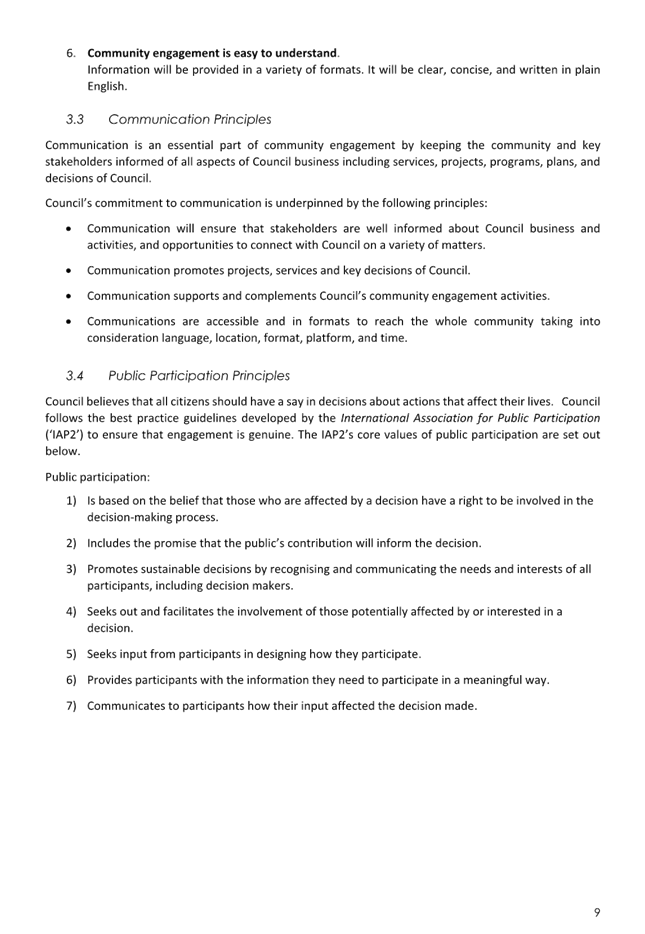
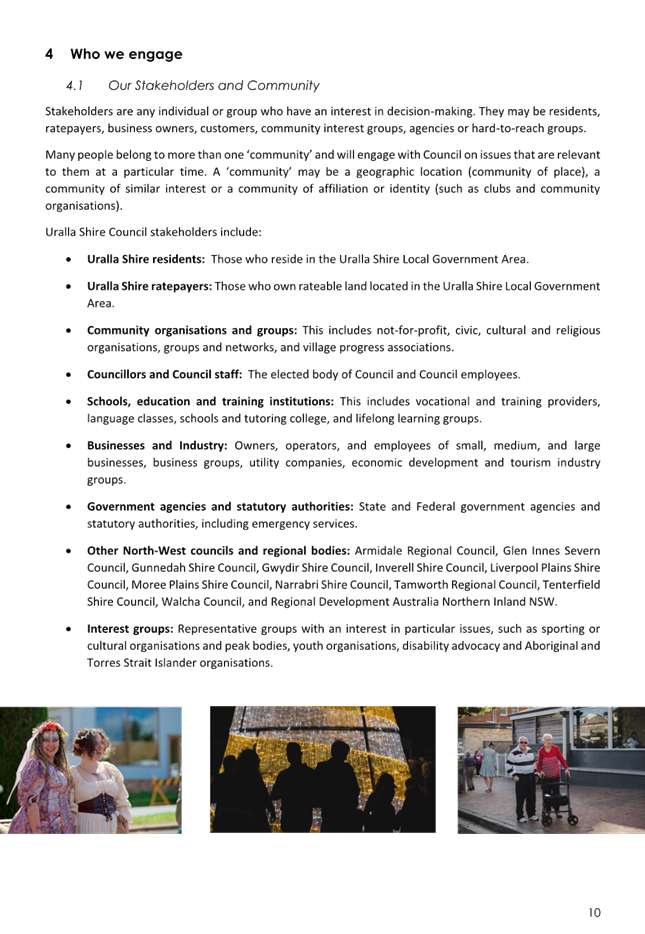

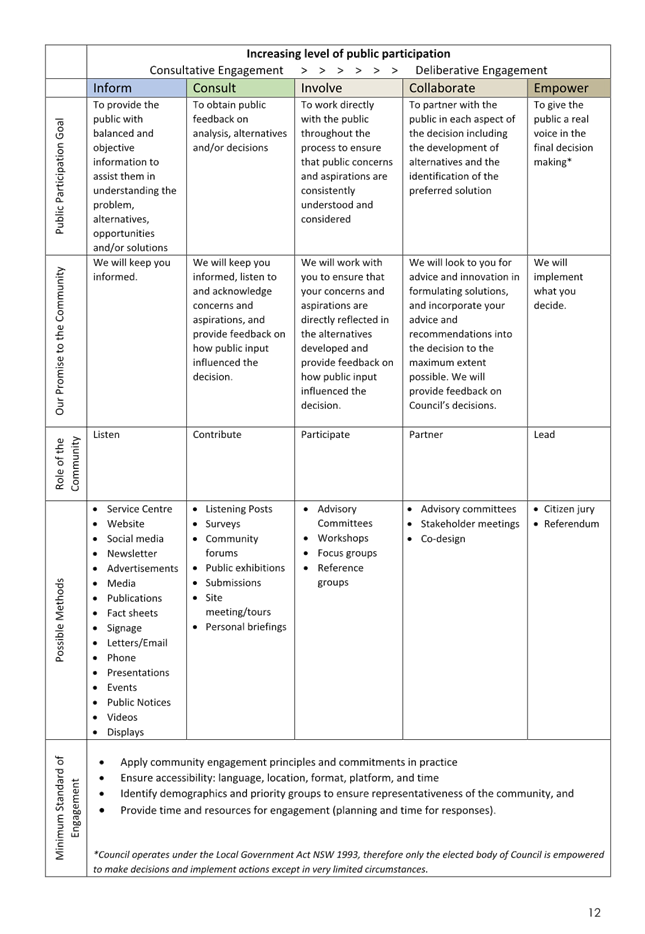
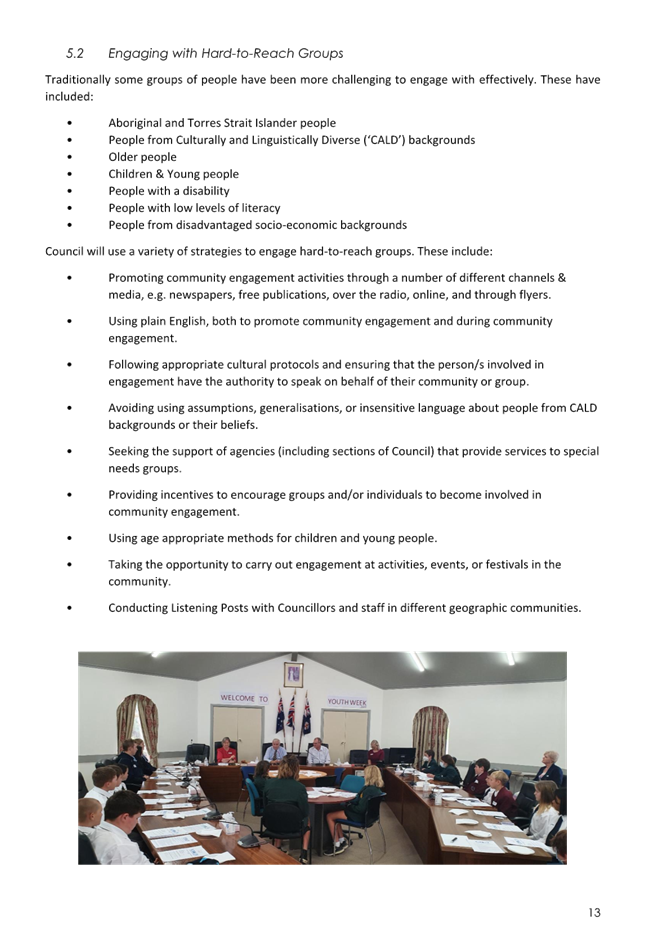
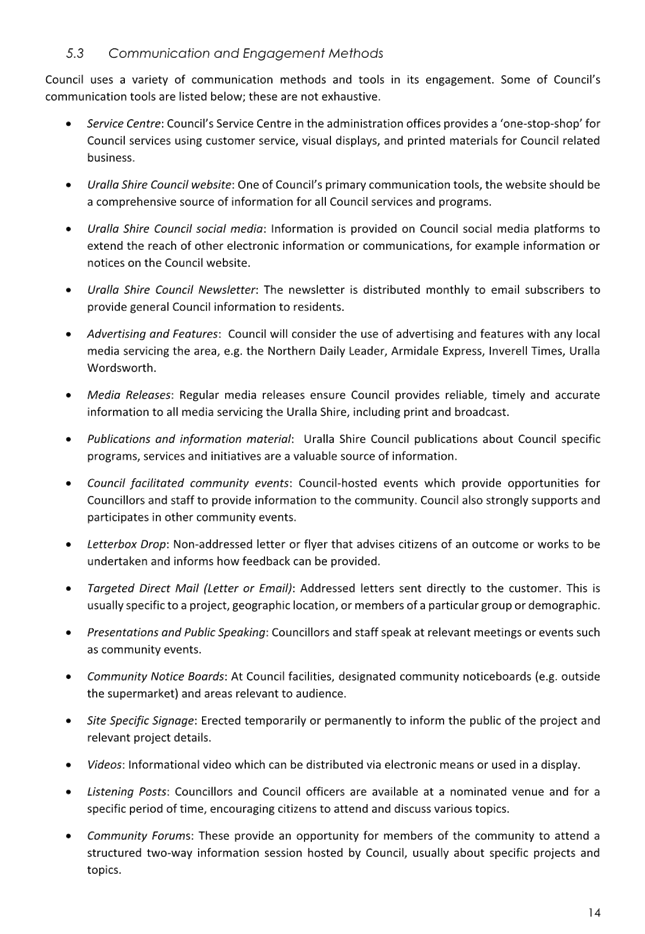
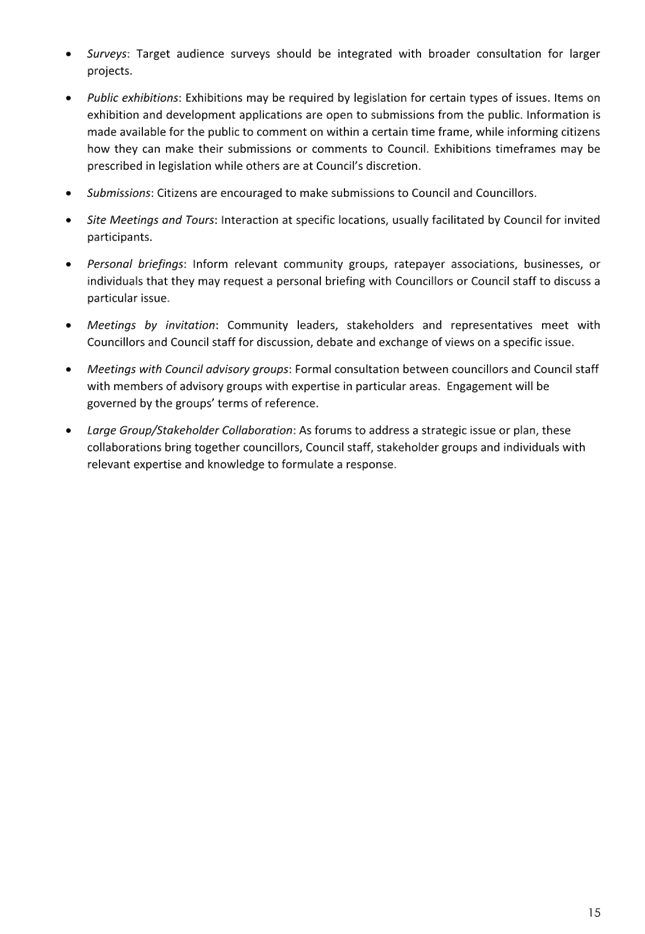
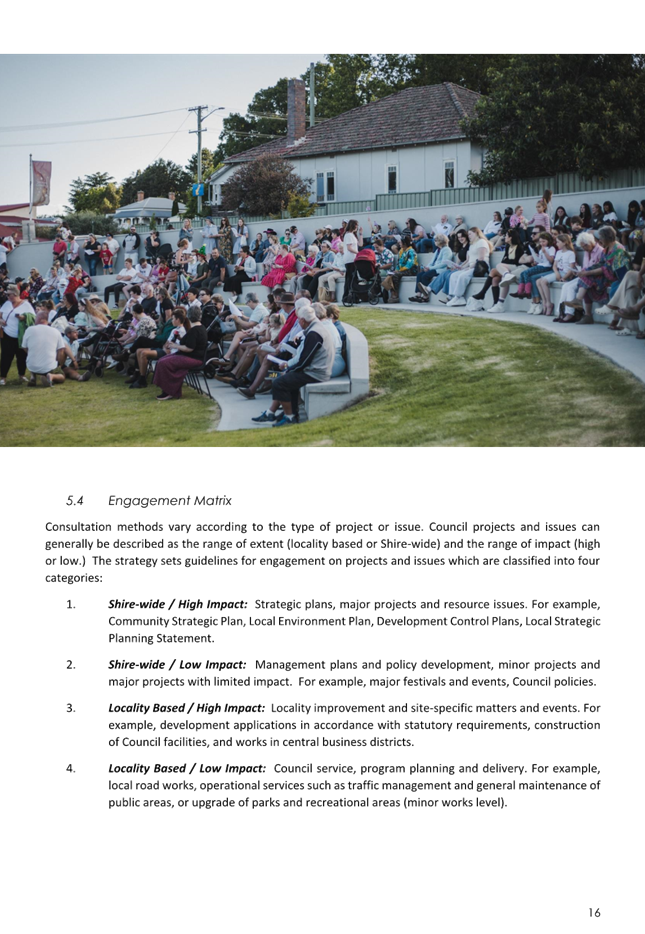

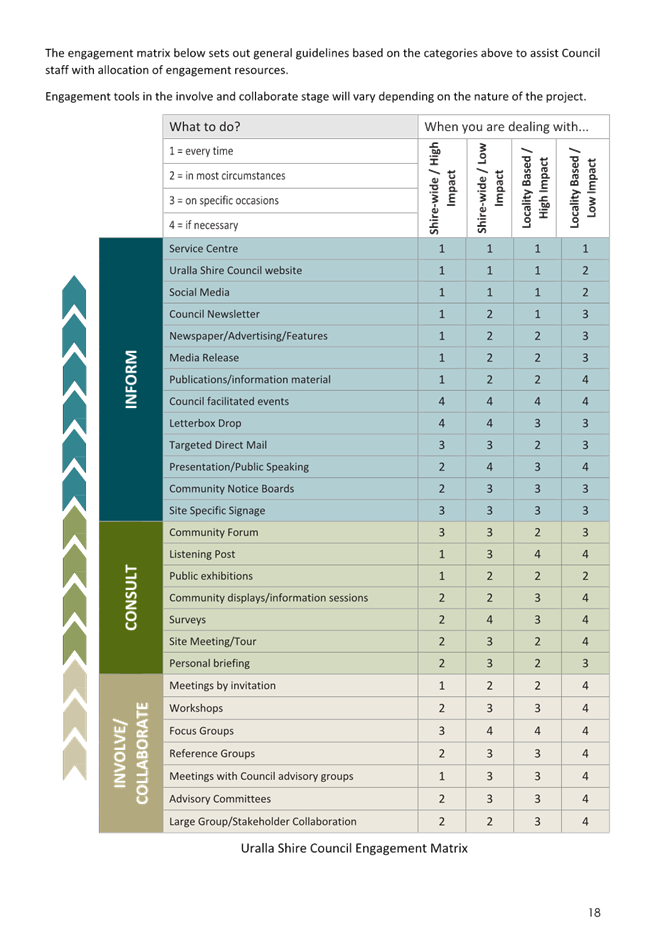
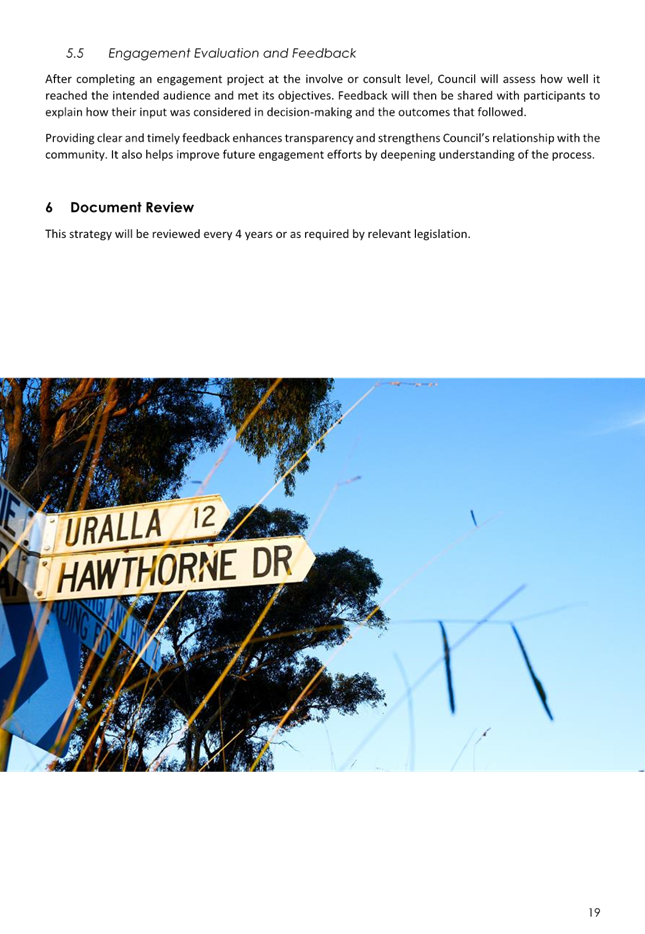
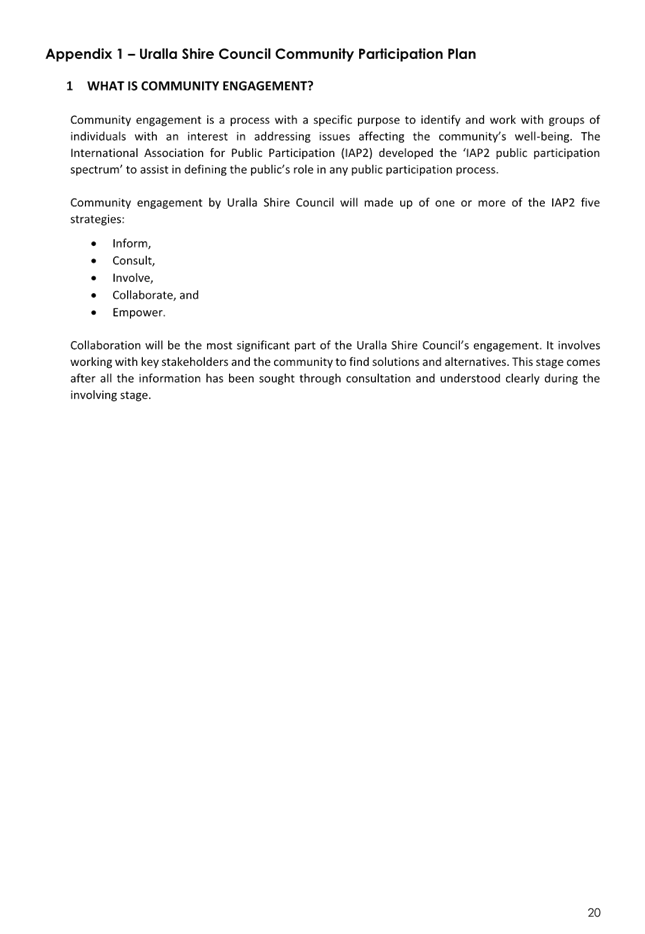
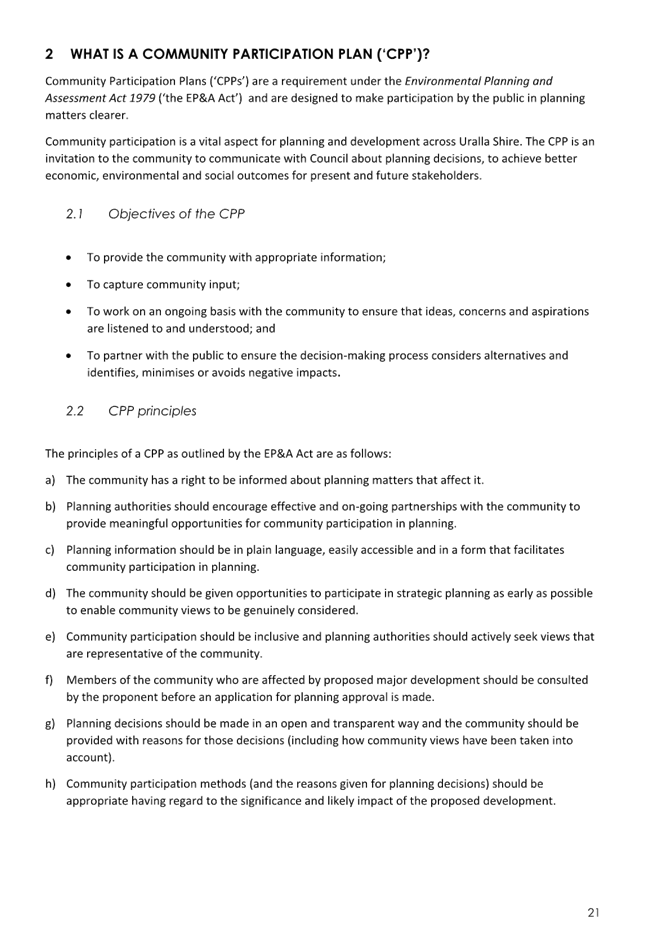
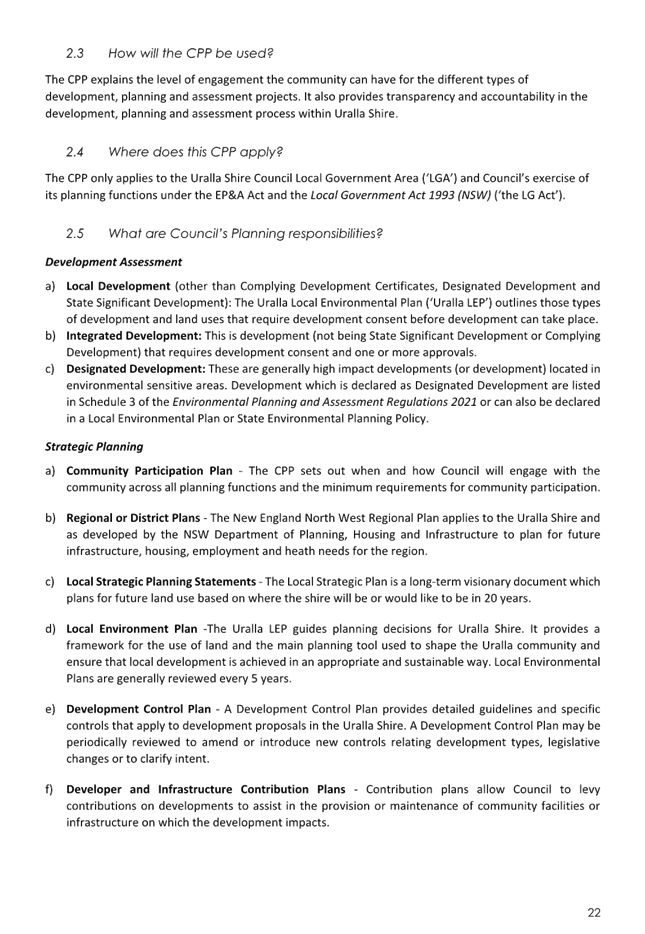

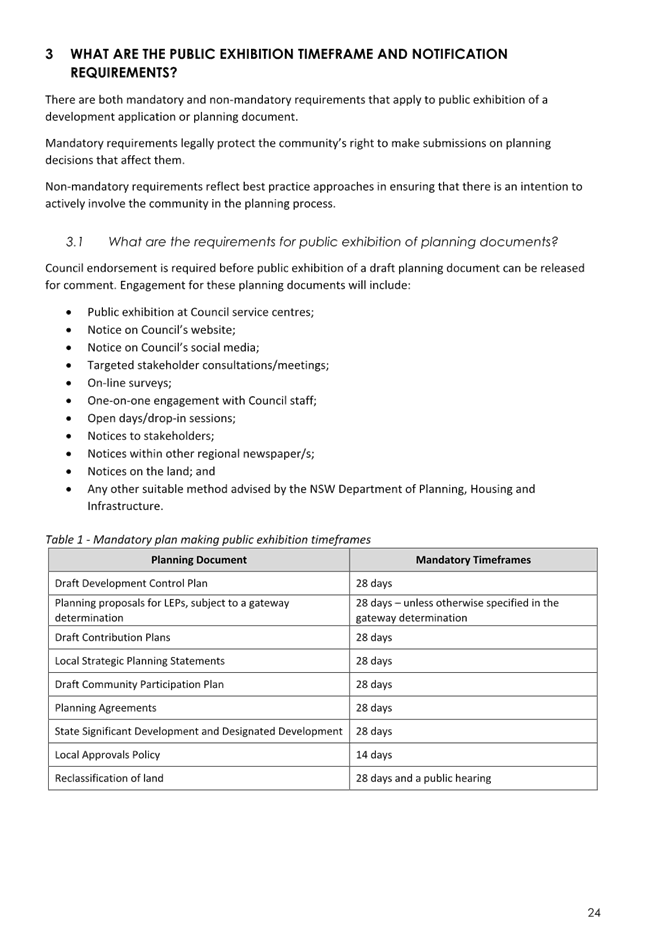
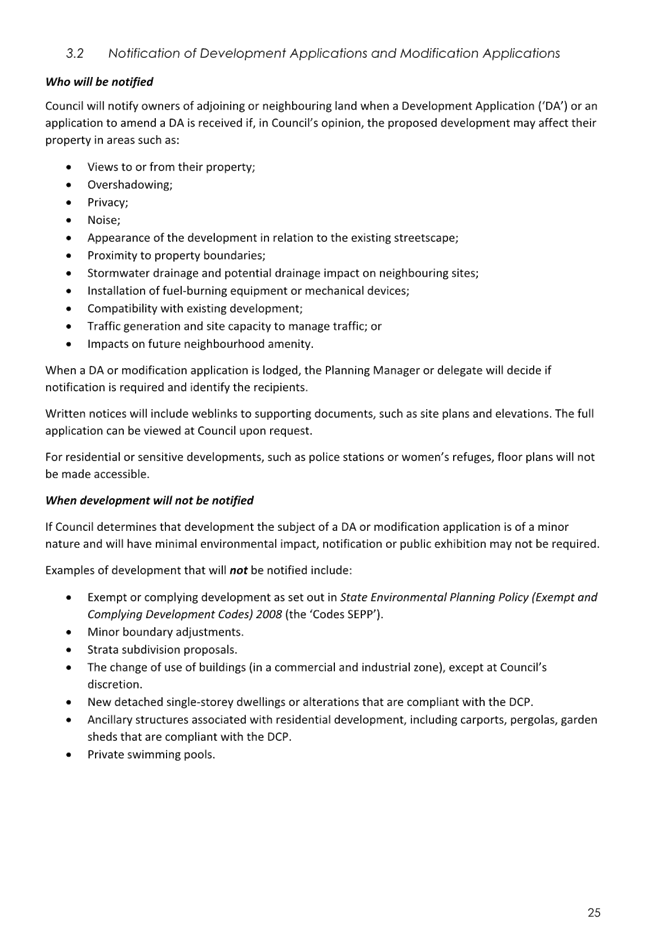
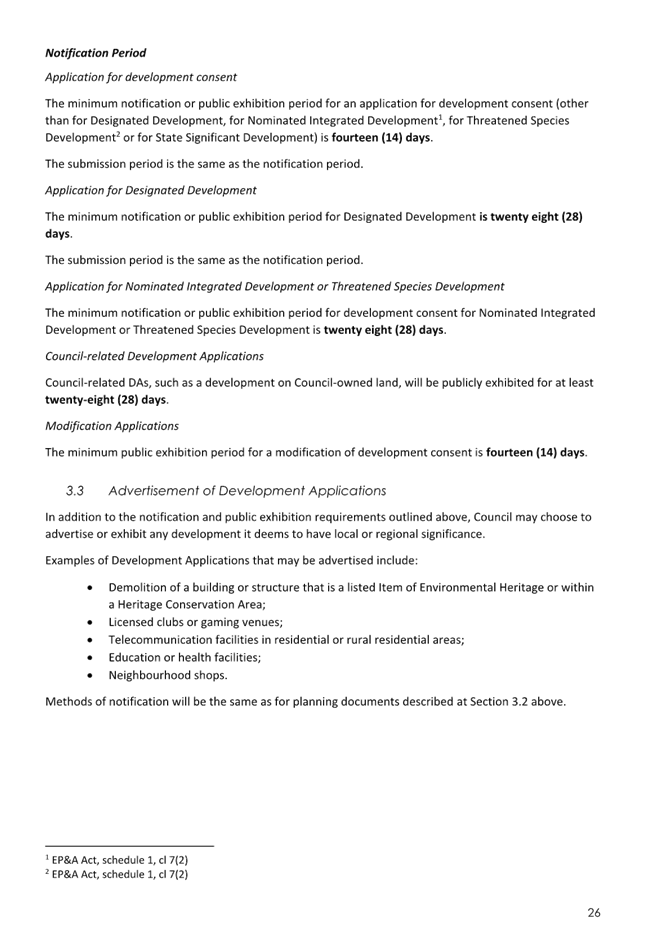
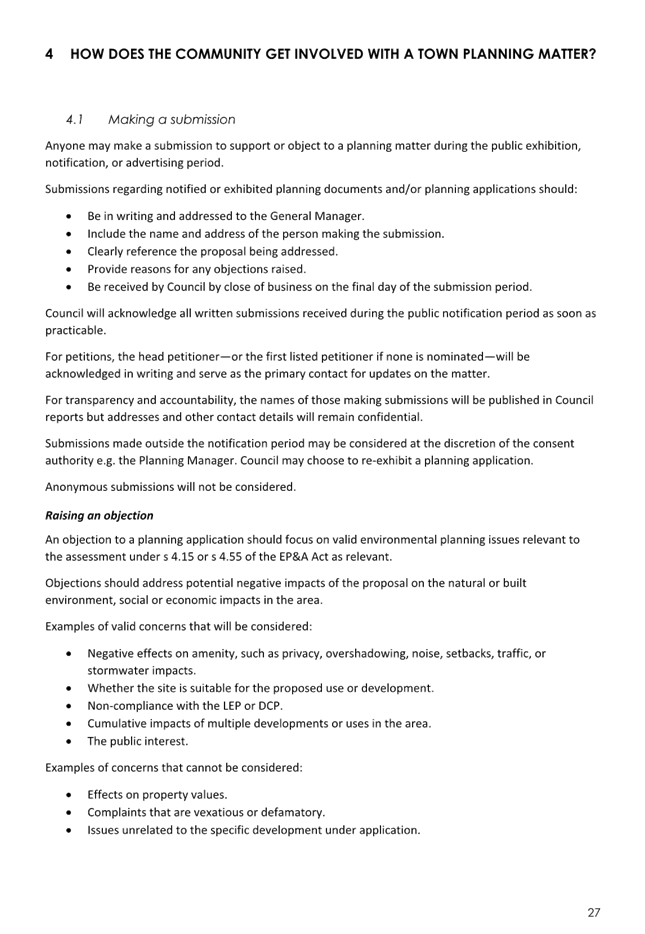
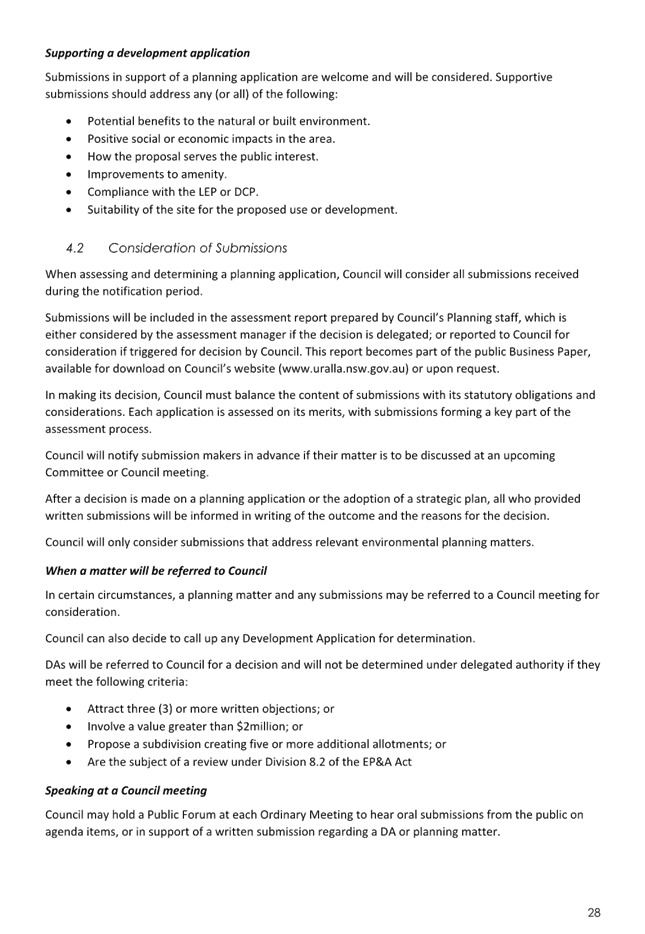

|
Ordinary Council Meeting Business Agenda
|
17 December 2024
|
14.6 Request
- Renaming of Emu Crossing Bridge
|
Department:
|
Infrastructure &
Development
|
|
Prepared By:
|
Group Manager Infrastructure
Services
|
|
Authorised By:
|
Director Infrastructure & Development
|
|
Reference:
|
UINT/24/15825
|
|
Attachments:
|
1. Email
- Request to Rename Emu Crossing Bridge - Received 12 September 2024 ⇩ 
2. Email
- Geographical Names Board (GNB) - Renaming of Emu Crossing Bridge ⇩ 
3. Geographical
Names Board (GNB) - Place Naming Policy - 2019 ⇩ 
4. Email
Response from TfNSW ⇩ 
|
|
LINKAGE TO INTEGRATED PLANNING AND REPORTING FRAMEWORK
|
|
Goal:
|
2. We
drive the economy to support prosperity
4. We
are an independent shire and well-governed community
|
|
Strategy:
|
2.3. Communities
that are well serviced with essential infrastructure
4.1. Informed
and collaborative leadership in our community
4.3. An
efficient and effective independent local government
|
Summary
The purpose of this report is for Council to consider a
request for the renaming of the “Emu Crossing Bridge”.
|
Recommendation
That Council:
1. Notes
the recent request to rename Emu Crossing Bridge.
2. Notes
the Policy Guidelines set out in Section 9.3 and 7 of the Geographical Name
Board’s Place Naming Policy 2019 which advised against the formal
naming of infrastructure after a living person, or a deceased person within
12 months of their passing.
3. Determines
whether to initiate or not initiate community consultation to change the name
of the Emu Crossing Bridge
4. Advises
the requester of its determination.
|
Background:
The bridge was opened in 2015.
At that time there were three
proposals from the community re the naming of the bridge:
1. QUT
Nursing faculty recommending the name “Nurse May Yarrowick Bridge”.
2. Anaiwan
Local Land Council recommending the name “Nurse May Yarrowick
Bridge”.
3. Bundarra
Bridge Committee (Chair Dr Robert Crouch) recommending the name “Emu
Crossing Bridge”.
The grounds for requests 1 and 2
were that it was appropriate to honour May Yarrowick, considered to be the
first Indigenous person to be qualified as a practising nurse in Australia. May
graduated from Sydney’s Crowne Street Hospital in 1905. May was born in
the Bundarra Region, and later returned as the region’s much respected
midwife for many years. Her photo is immortalised on the wall at the Bundarra
aged care facility. Locally she is now universally referred to as Aunty May.
Aunty May is deceased and interred at the Bundarra Cemetery.
The grounds of the request in 3
was that the area on which the bridge was located had been known as “Emu
Crossing Creek” since settlement.
Council resolved to proceed with
Option 3, naming the Bridge - “Emu Crossing Bridge” in 2015.
Report
On 12 September 2024, Council
received a letter from Mr Tim Bower (Attachment 1) requesting Council consider
and support his proposal to rename the Emu Crossing Bridge in honour of the
retiring Councillor and Deputy Mayor, Mr Bob Crouch.
An email was sent to the
Geographical Names Board (GNB) on 19 September 2024 seeking confirmation of
their Policy regarding the naming/renaming of bridges in honour of a living
person (Attachment 2).
The response from the Geographical
Names Board Secretariat, advised that as the “location” is a
Bridge, it is a matter for Transport for NSW (TfNSW). However, the Board
also confirmed it is not advised to name a place after a living person
until they have been deceased for at least 12 months. The Policy’s
justification is that “using the name of a living person is
unacceptable (nationally and internationally) as it may lead to favouritism
and/or inappropriate naming. There are examples where people commemorated have
later proven to be of poor character or otherwise thought to be unworthy.”
Refer to Section 7 of GNB’s Place Naming Policy 2019 (Attachment 3).
GNB also state that “another
key principle is that place names are meant to be enduring, and that
“changes are discouraged unless the change has been deemed to be either
in the public interest or for safety reasons. Changing well established names
can lead to address or location confusion, especially to electronic navigation
services.” (Sec 9.3. NSW Place Name Policy)”.
Following this advice from GNB, an
email was sent to Tracey Niddrie, TfNSW’s Associate Community &
Safety Partner for the New England region on 20 September 2024 requesting
confirmation of TfNSW’s Policy regarding the naming/renaming of bridges
in honour of a living person.
Tracey responded on 22 November
2024 citing a response from TfNSW’s Senior Manager for Bridges (NSW).
They noted that there are some inconsistencies in the cross-over of
responsibilities between USC, TfNSW and GNB and that needs to be reviewed. But
notwithstanding that, “They (USC) should follow the names board
requirements”. Essentially, TfNSW’s advice is that as the
‘final’ approver of a name change (Refer to Section 11.3 –
Bridge Naming of Attachment 3), Council should comply with GNB’s Place
Naming Policy 2019 (Attachment 3). A copy of the email trail and written
response from Tracey Niddrie of TfNSW is attached for reference (Attachment 4).
for future consideration
If a Change of Name is still
proposed there are some issues to consider. TfNSW is responsible for the naming
of bridges and other structures on freeways. Local councils are
responsible for initiating the naming of bridges on local, regional and state
roads (other than freeways). TfNSW however are the approval body these
proposals. The GNB does not name bridges, however, it encourages all
bridge naming to follow the guidelines as set out in their policy. The naming
of bridges and other structures on roads does not have a formal legislative
basis. However, the same GNB procedures for road naming applies to bridges and
other road infrastructure.
If Council were to submit a naming
proposal, it should be ultimately supported by a Council resolution following
community consultation. This would need to follow standard Public Consultation
Procedures.
TfNSW will approve a naming
proposal for a bridge or structure provided that:
• The
name has wide community support.
• Any
Aboriginal name has the support of local Aboriginal groups.
· Consideration
has been given to National and State commemorative initiatives involving the
naming of new of key road infrastructure.
• The
name is consistent with GNB place name criteria.
• The
design of the name plaque accords with TfNSW requirements.
Conclusion
Council should consider the Policy
Guidelines set in Section 9.3, 7 and 11.3 of the Geographical Name
Board’s Place Naming Policy 2019, as endorsed by TfNSW, in making a
determination on this matter.
The guidelines generally advise
against (but do not prohibit) changing an established name. The guidelines do
however recommend against naming a place after someone who is still living.
Council Implications
Community Engagement/Communication
Council is empowered to recommend bridge name changes to
TfNSW as the final approver, but only after significant community consultation.
Policy and Regulation
Nil
Financial/Long Term Financial Plan
Nil
Asset Management/Asset Management Strategy
Nil
Workforce/Workforce Management Strategy
Nil
Legal and Risk Management
Nil
Performance Measures
Nil
Project Management
Nil


|
Ordinary Council Meeting
Business Agenda
|
17 December 2024
|
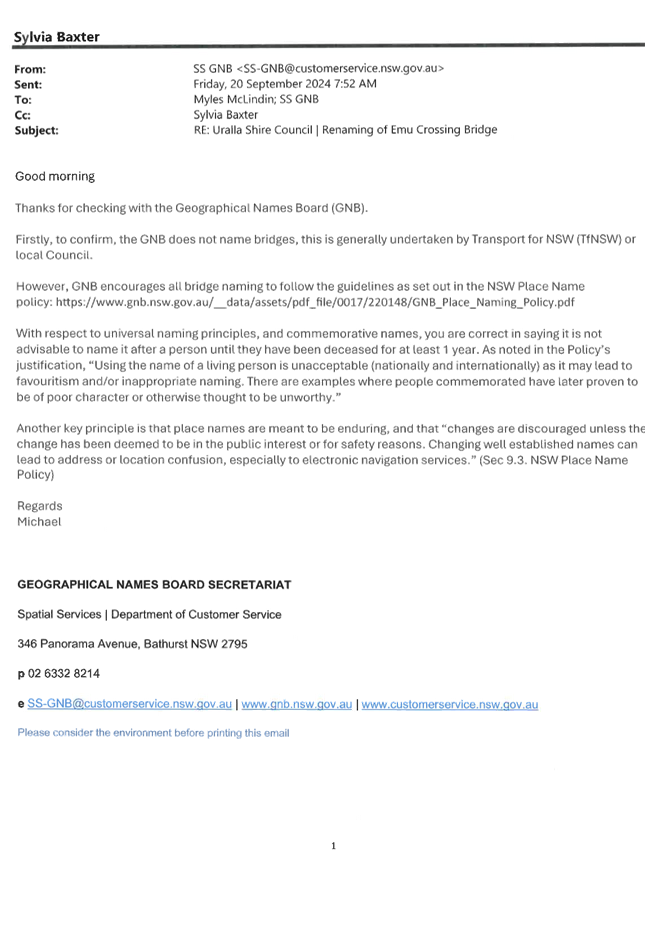

|
Ordinary Council Meeting Business Agenda
|
17 December 2024
|
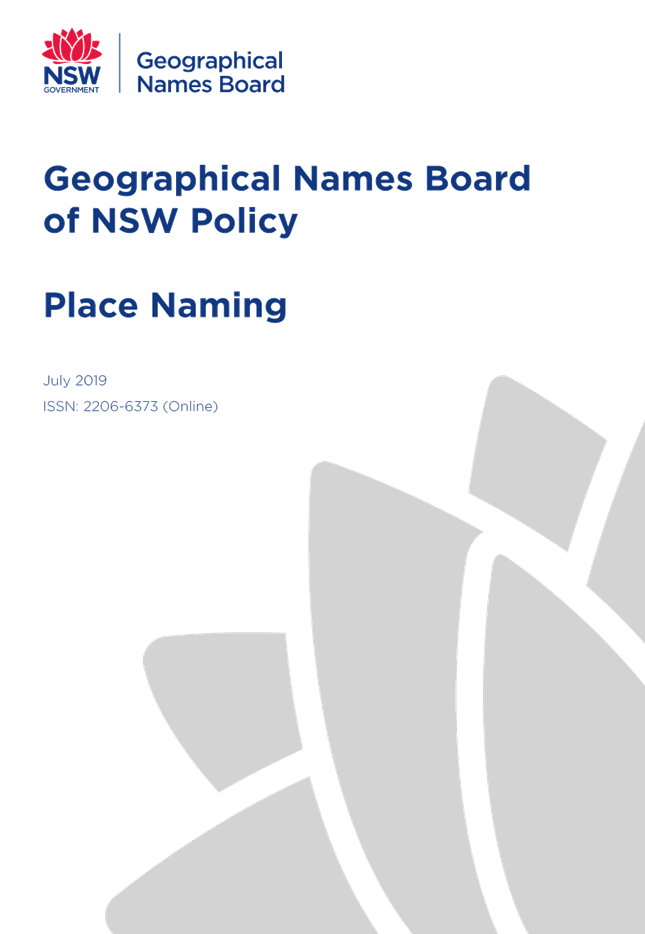
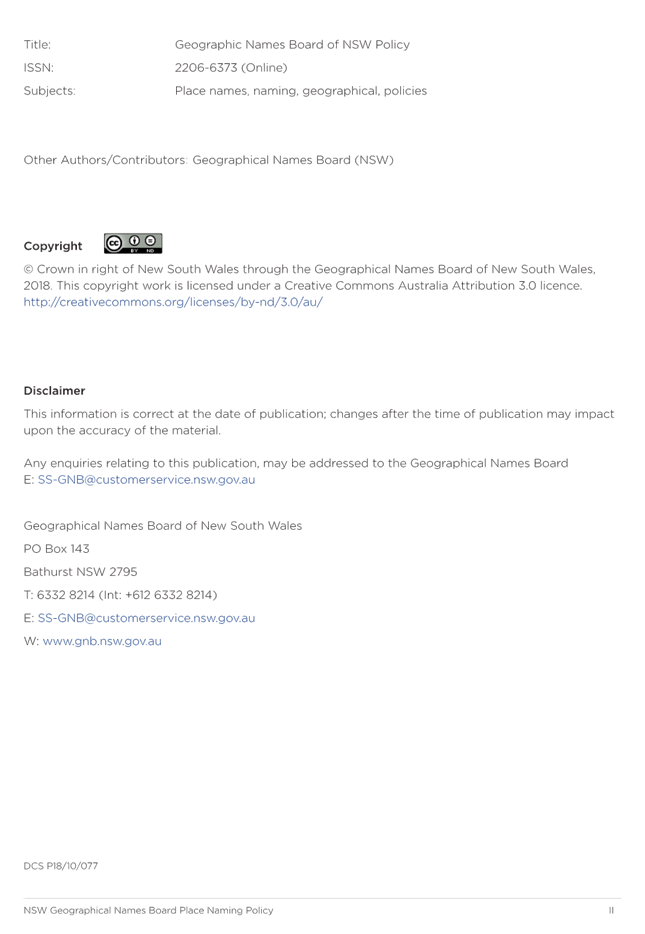
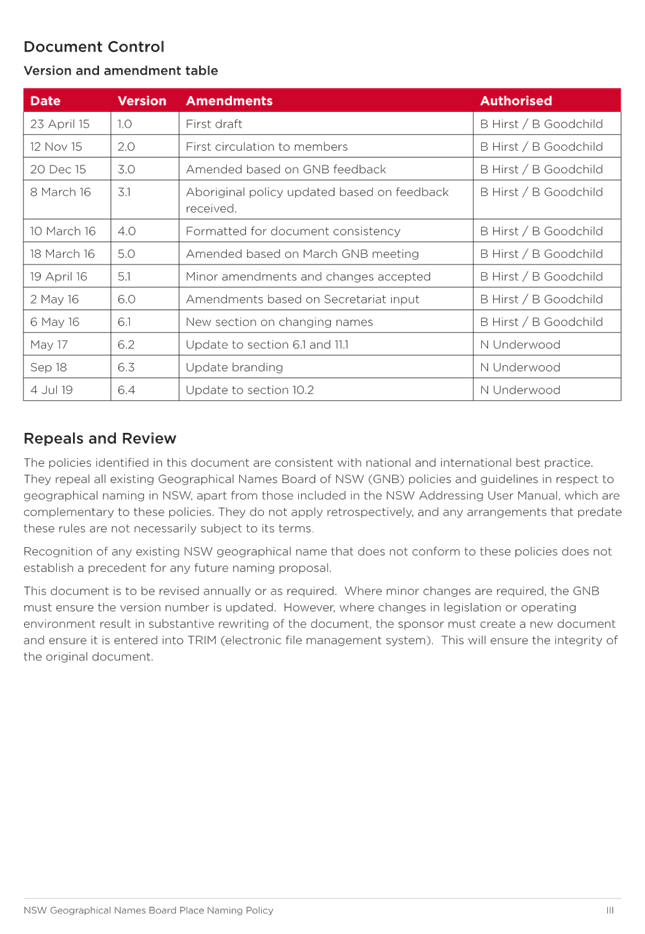
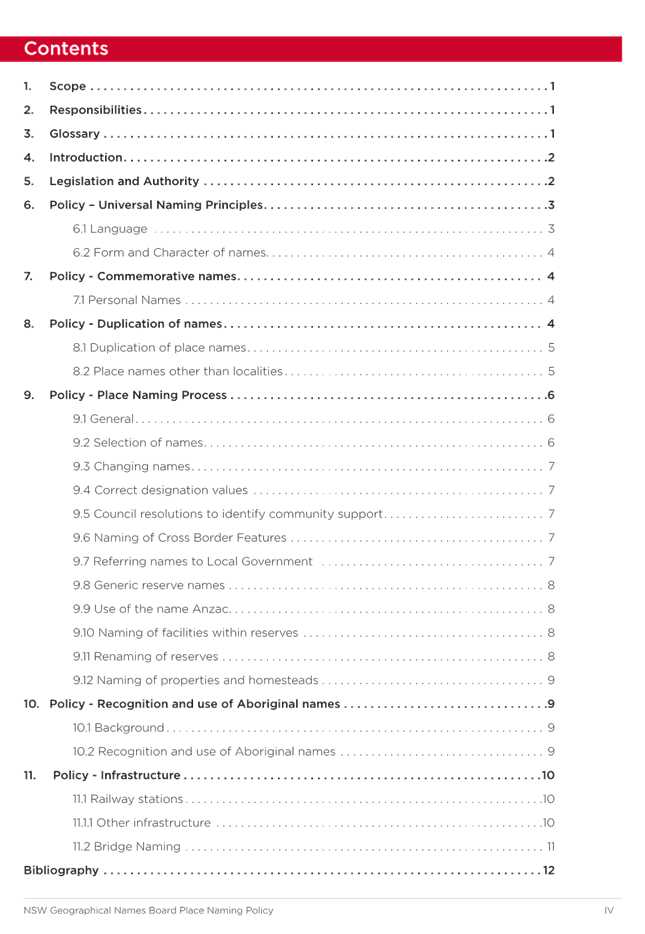
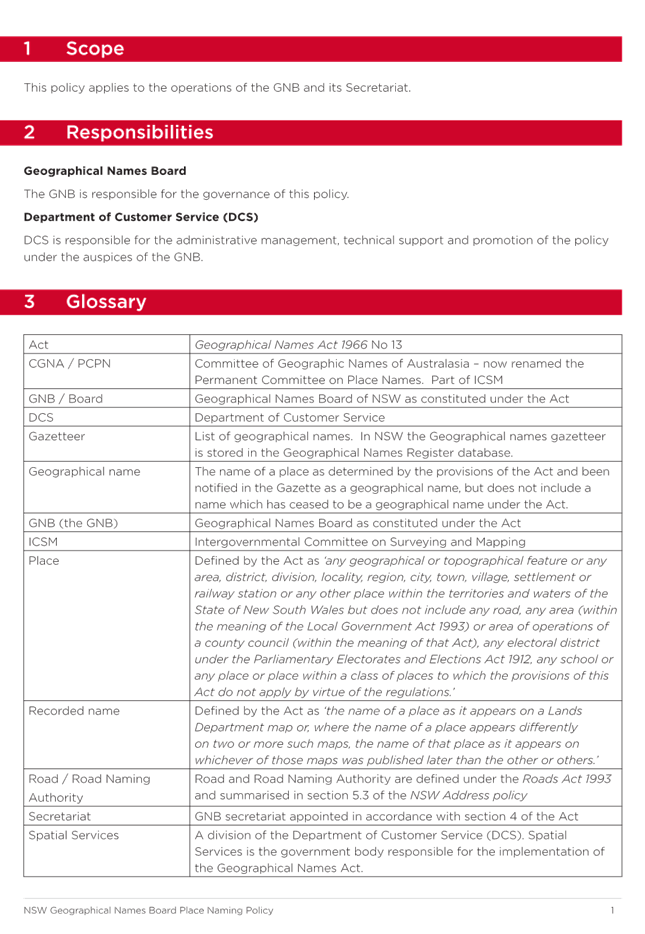
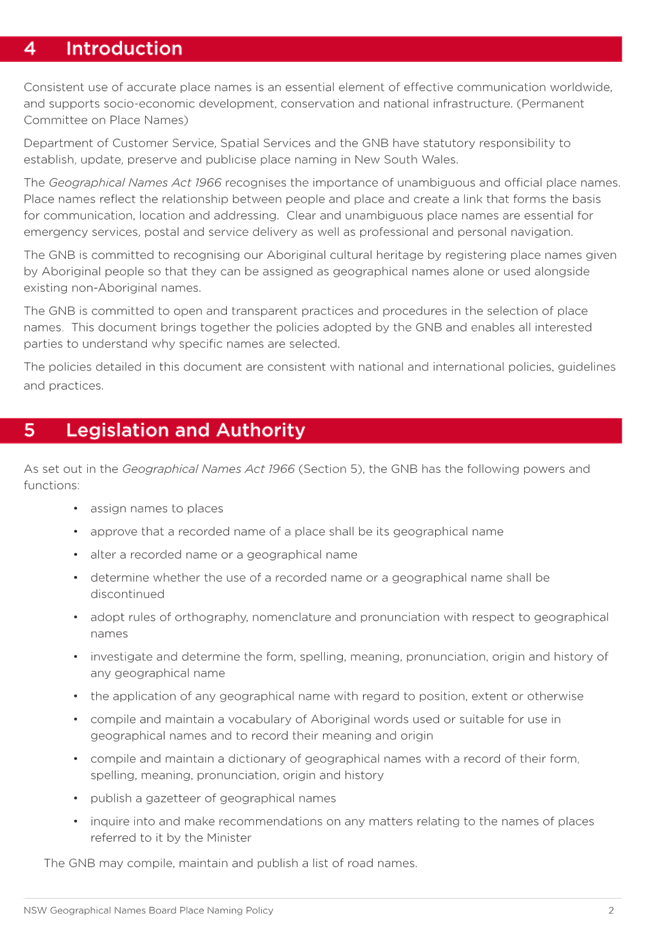
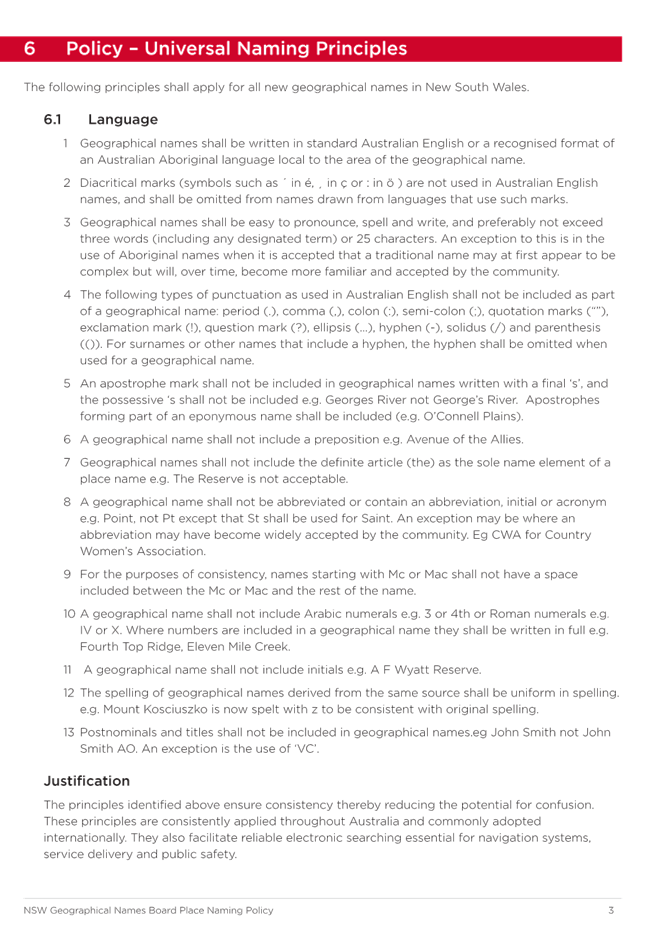
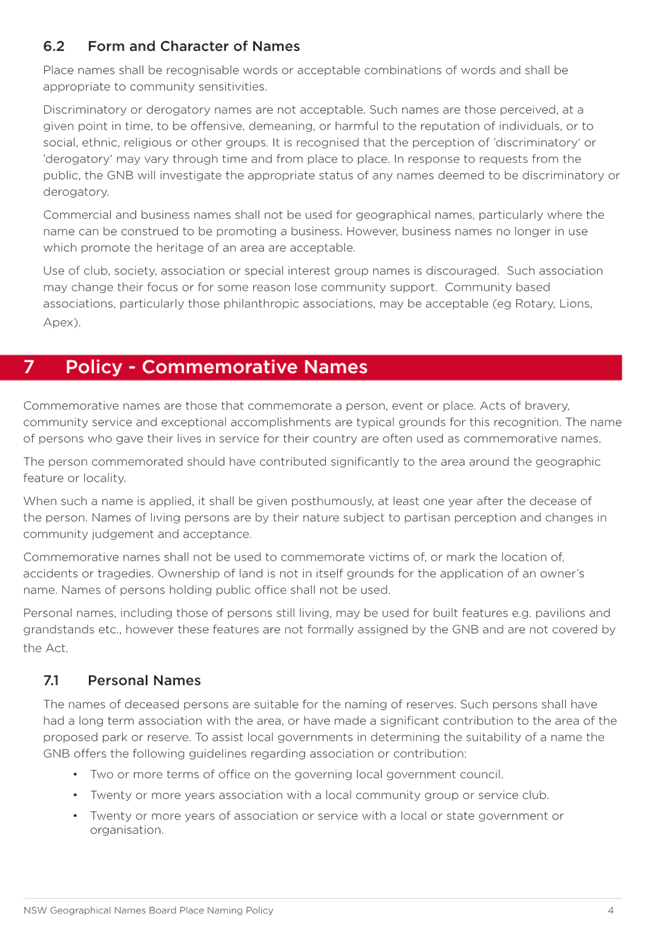
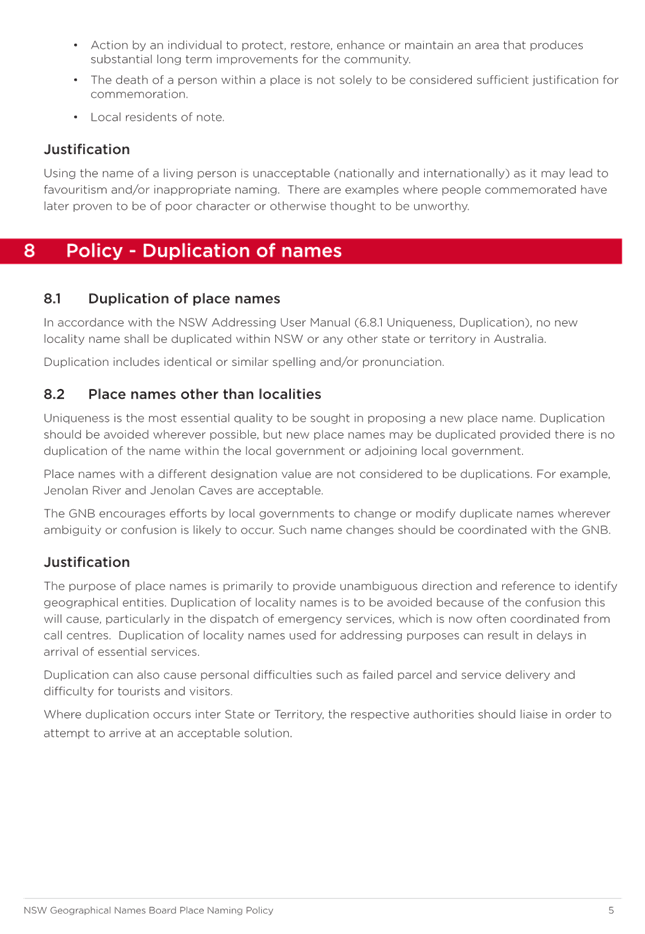
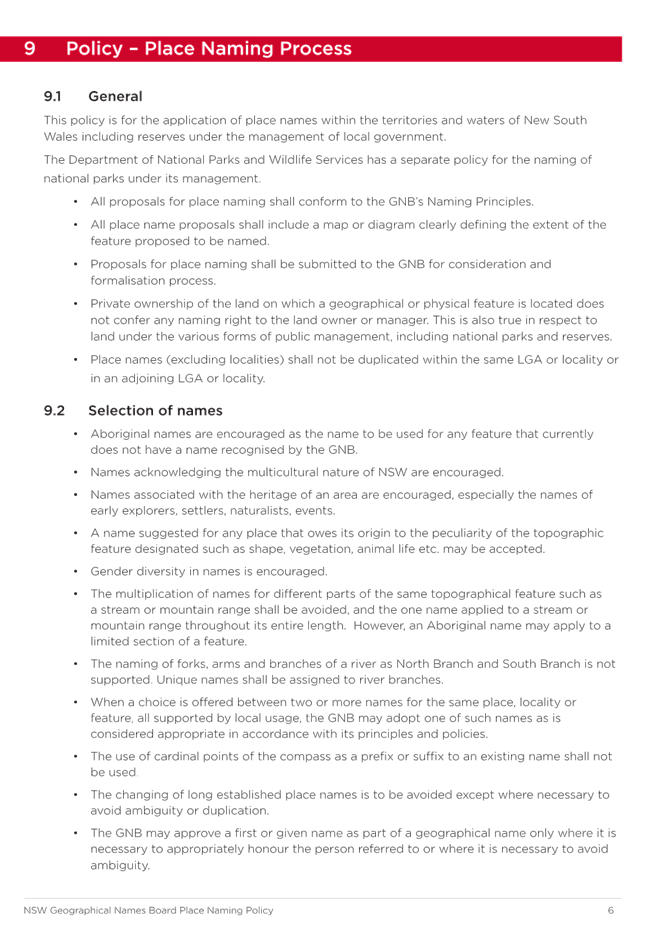
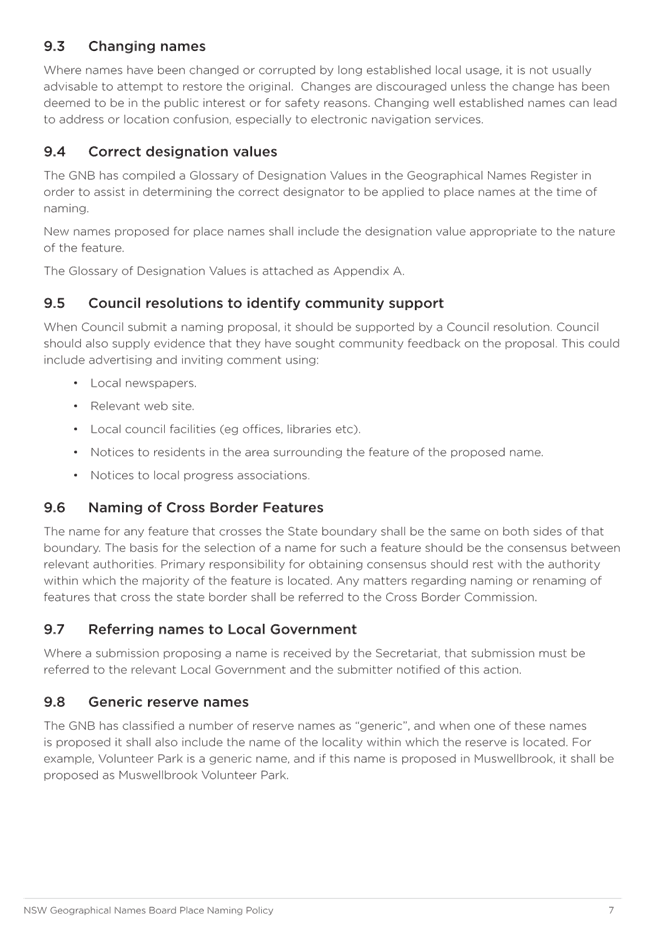
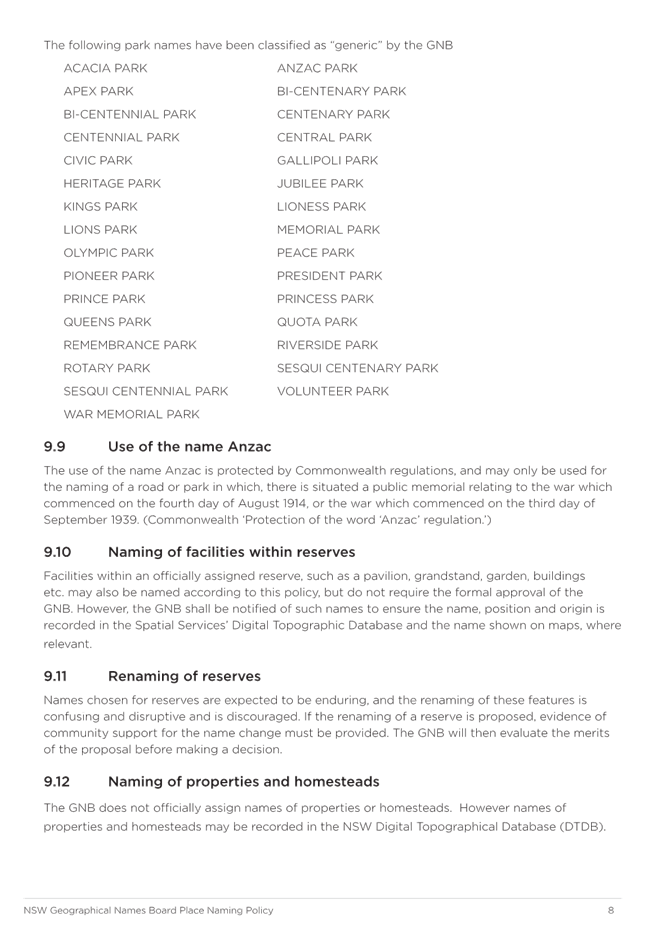

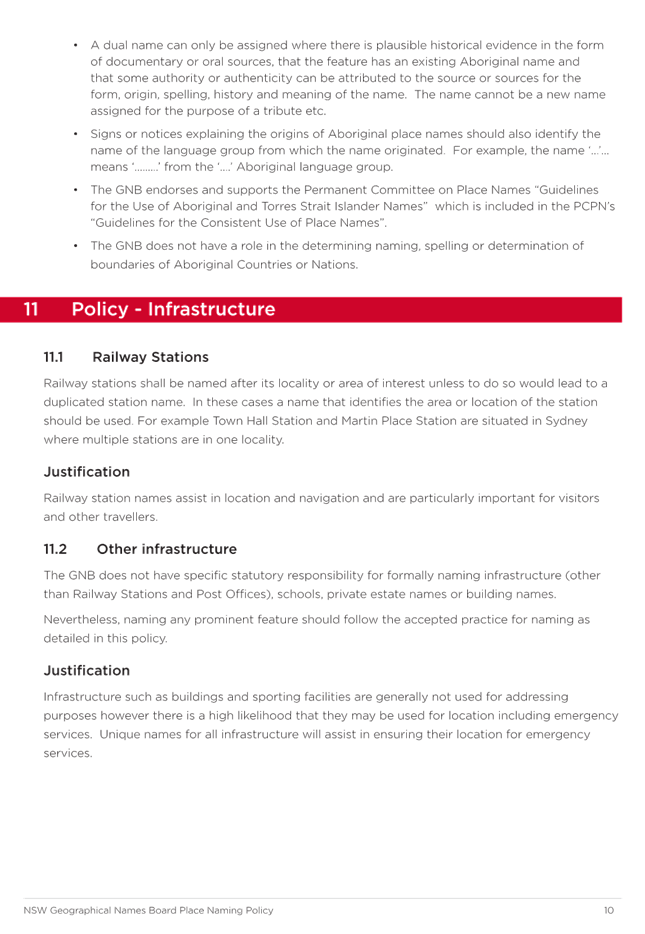
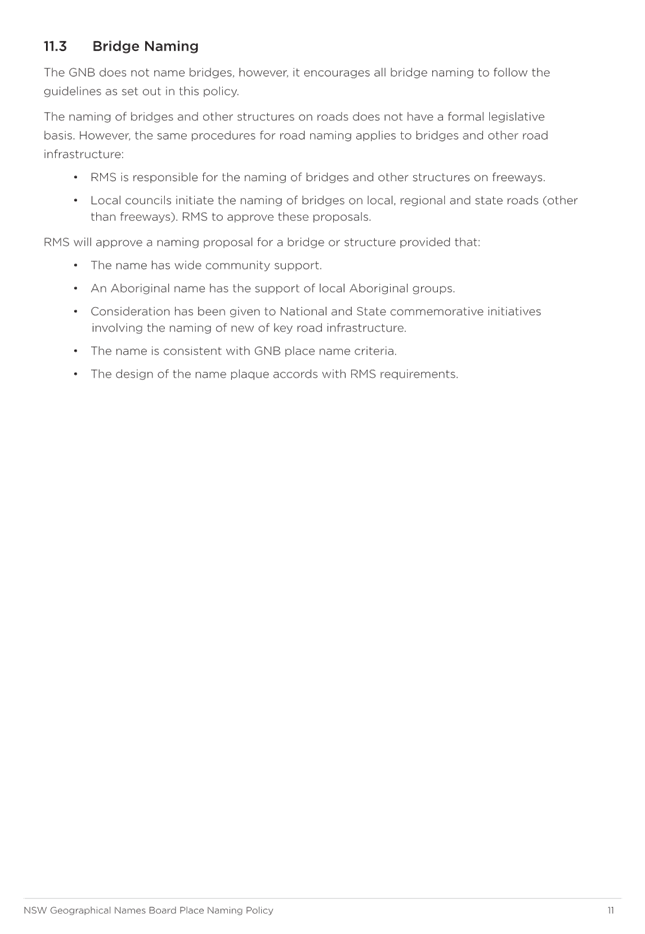
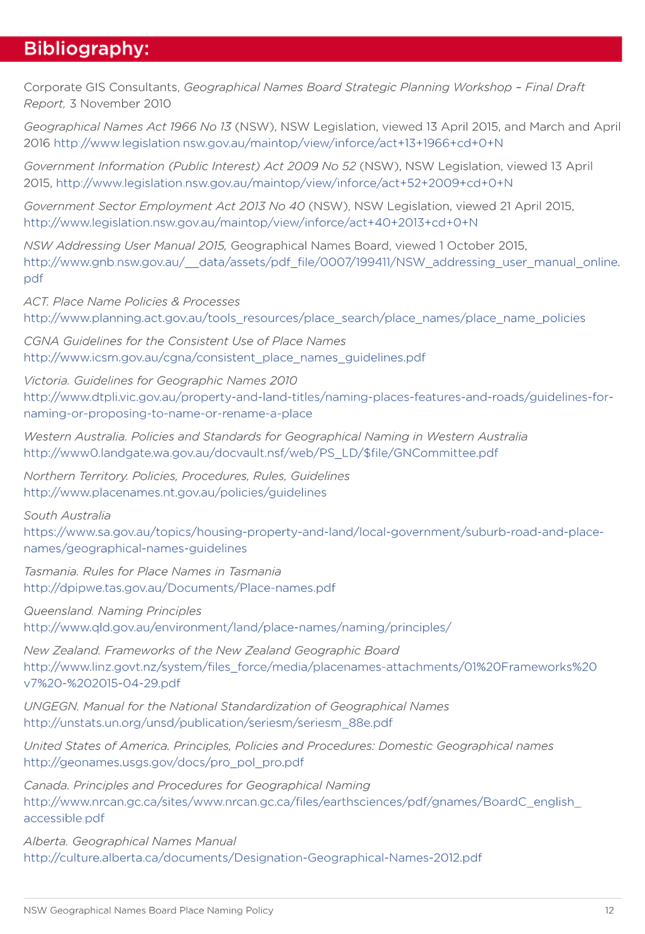


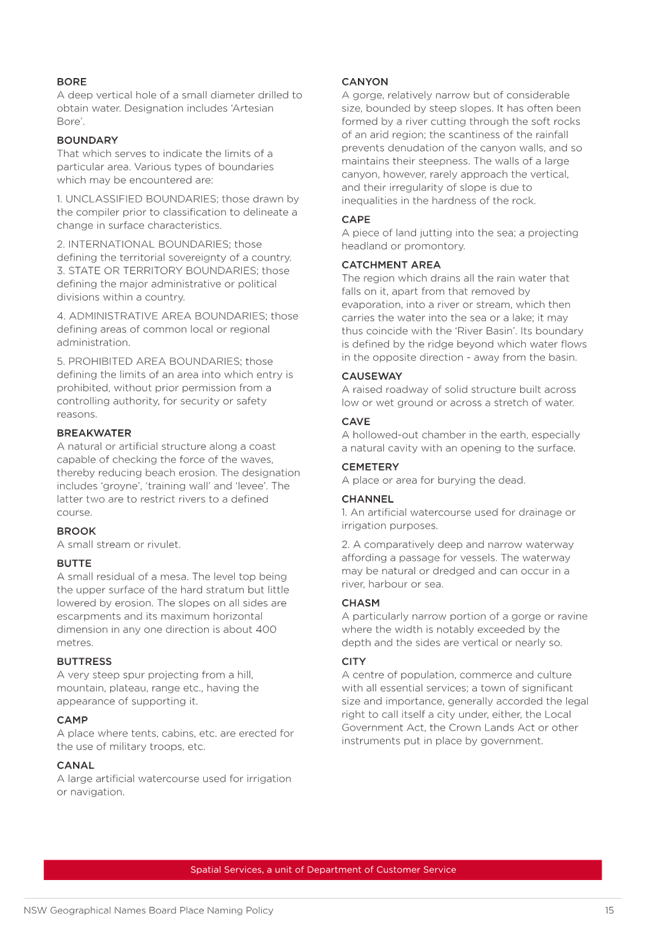
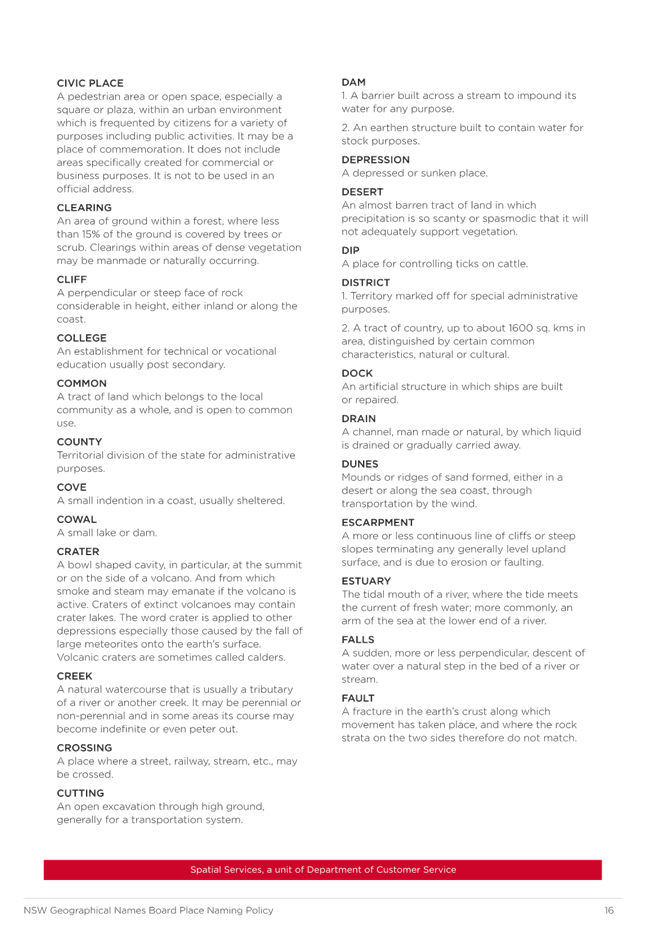
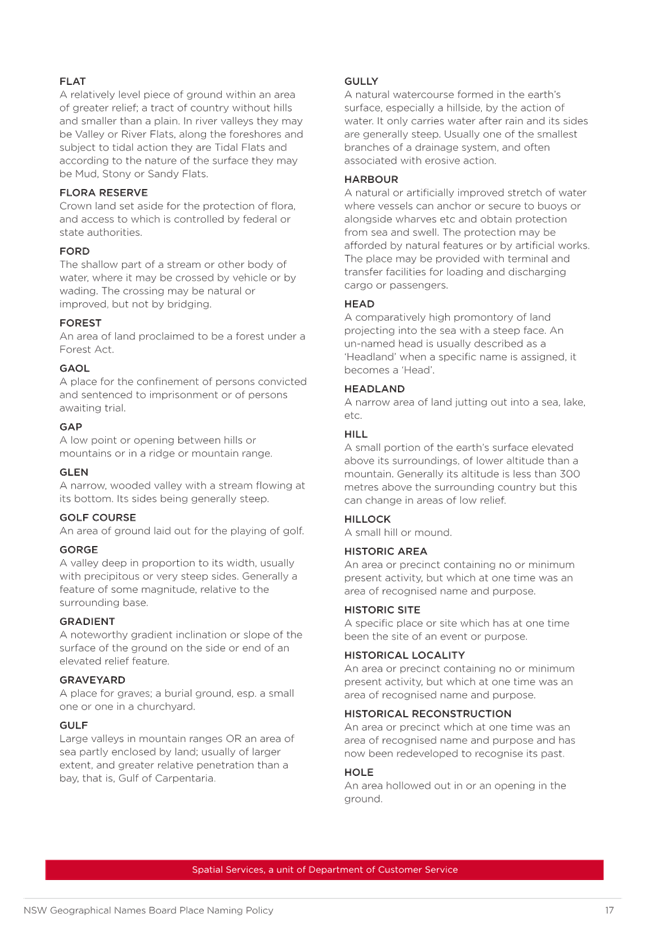
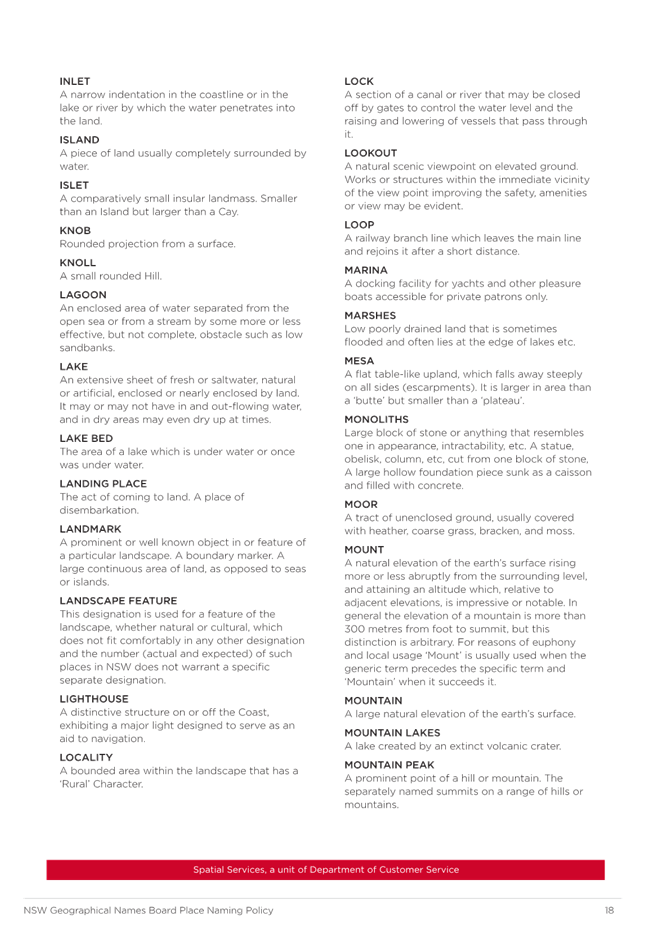

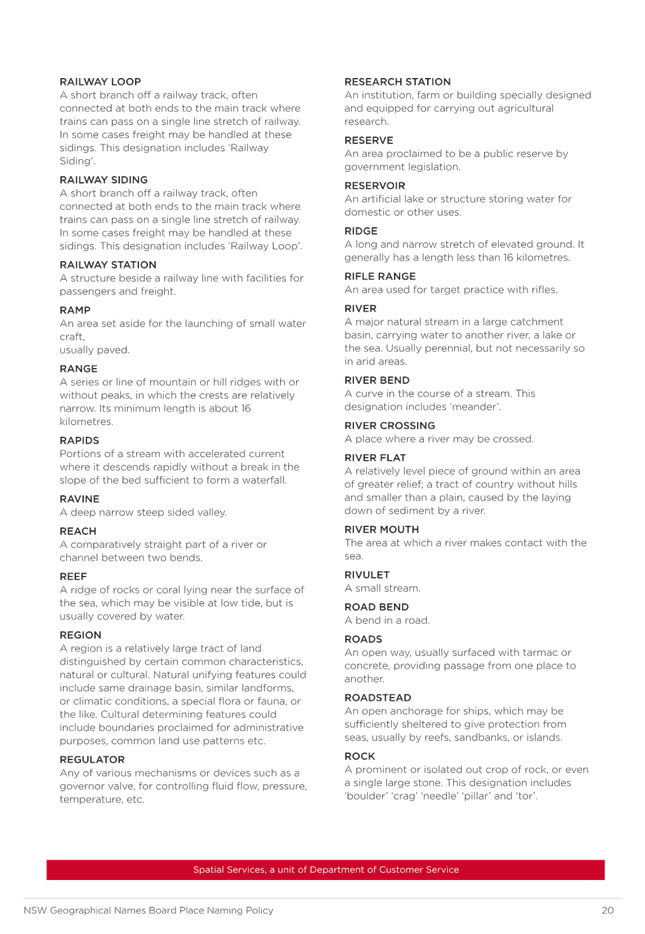
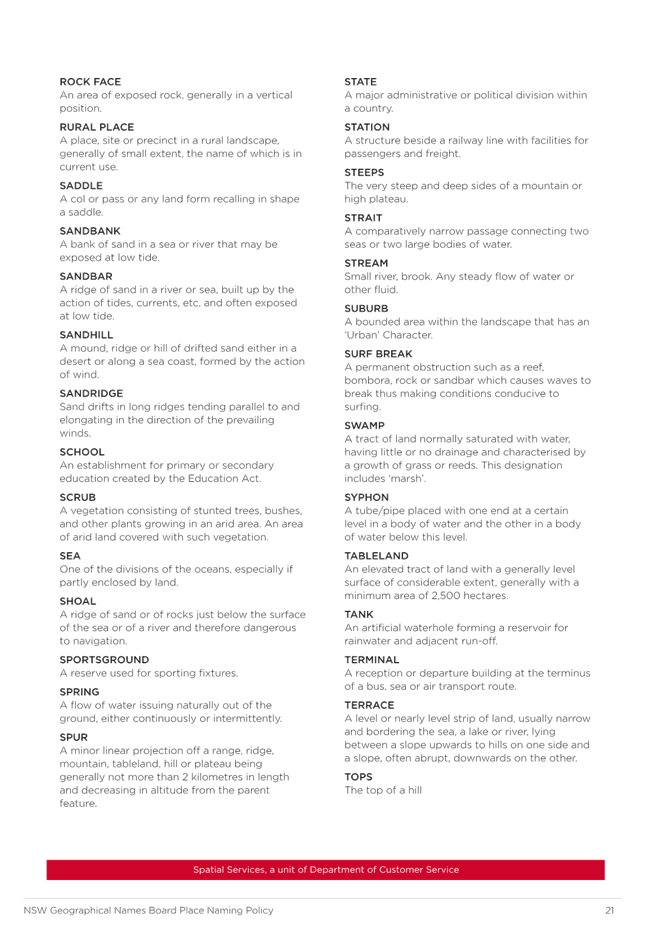
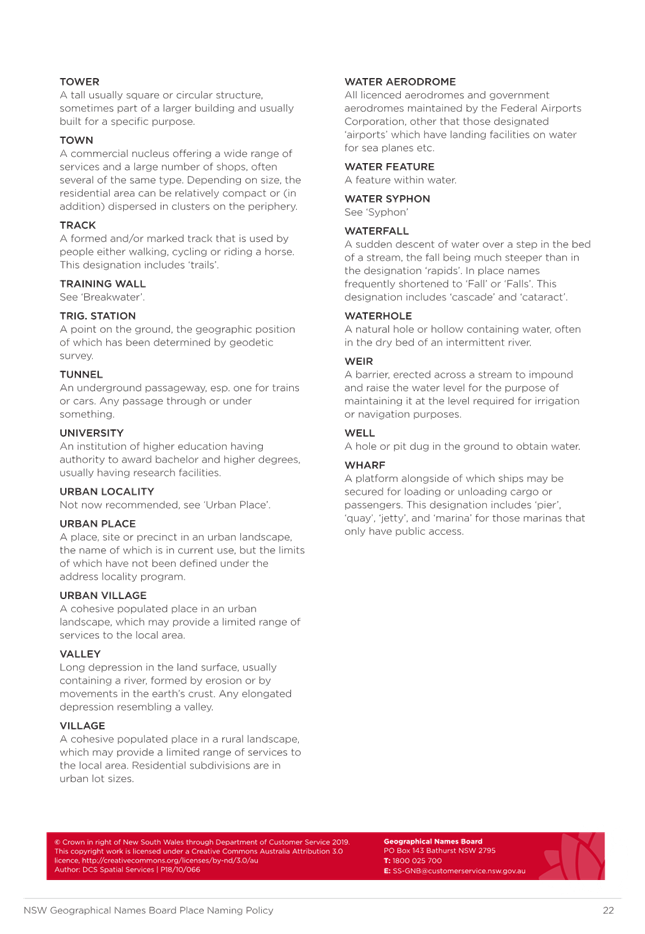
|
Ordinary Council Meeting Business Agenda
|
17 December 2024
|
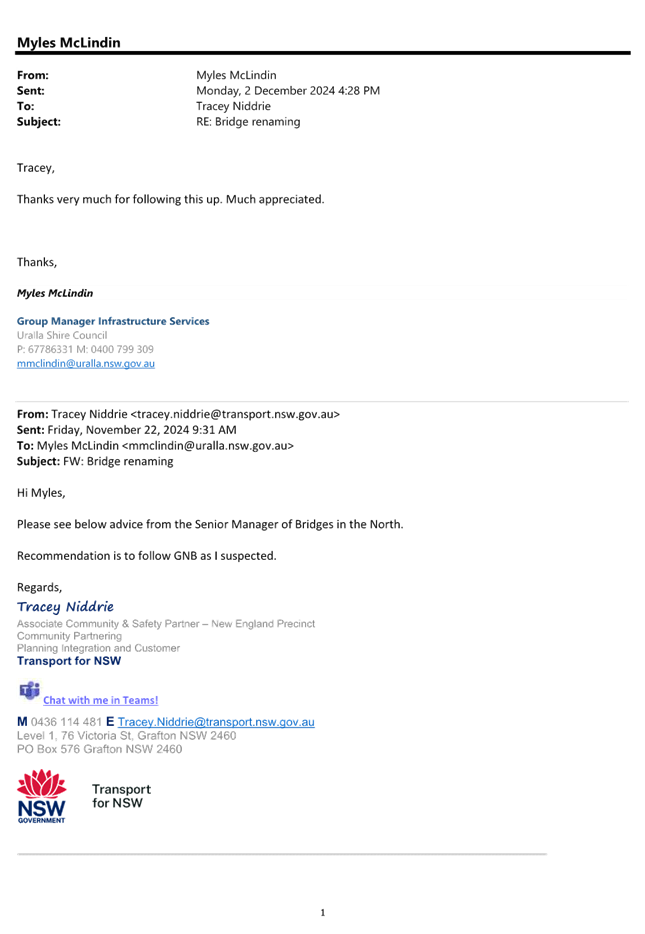

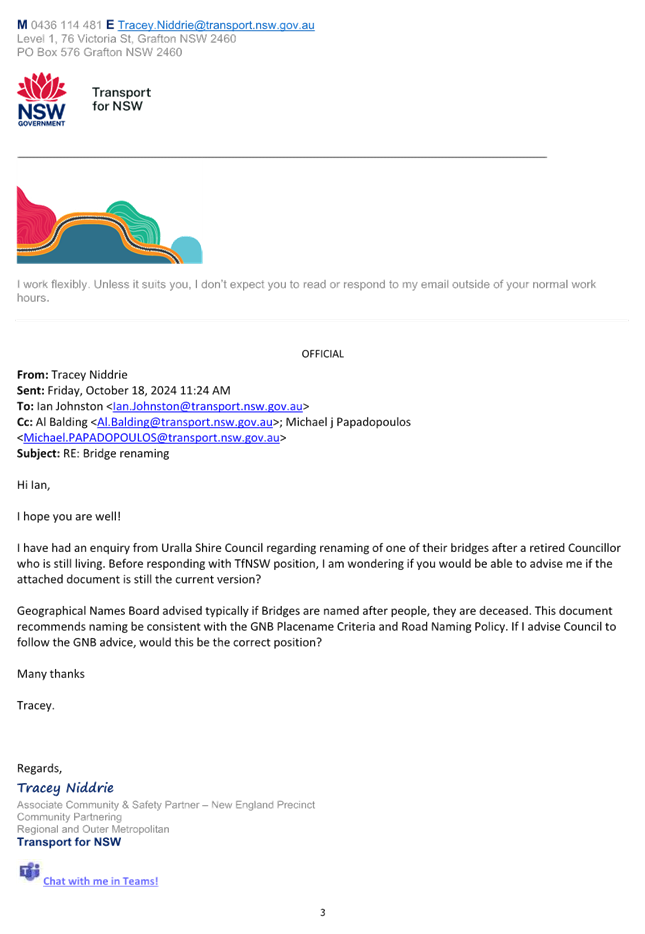
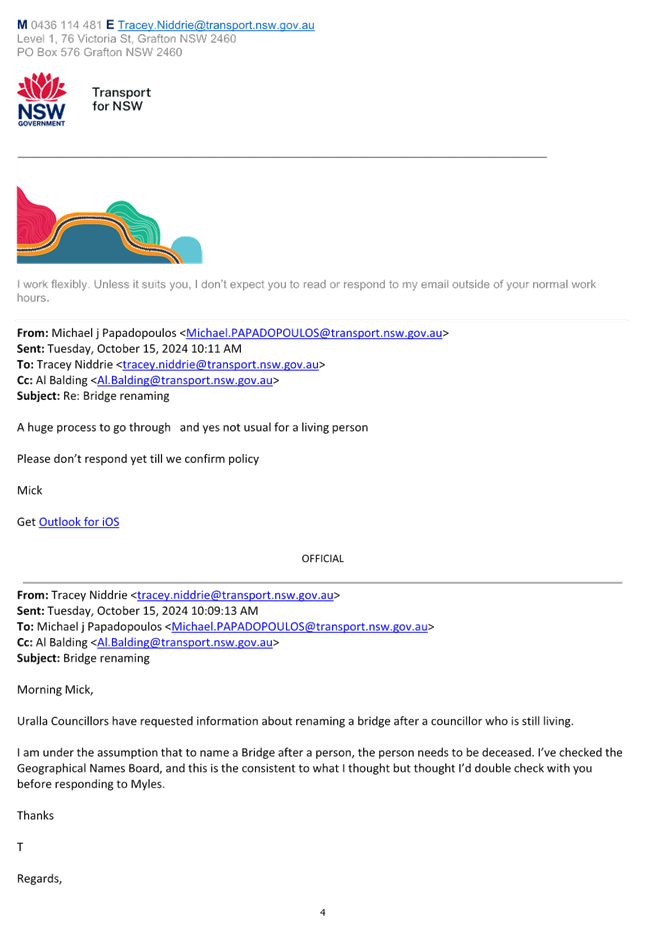
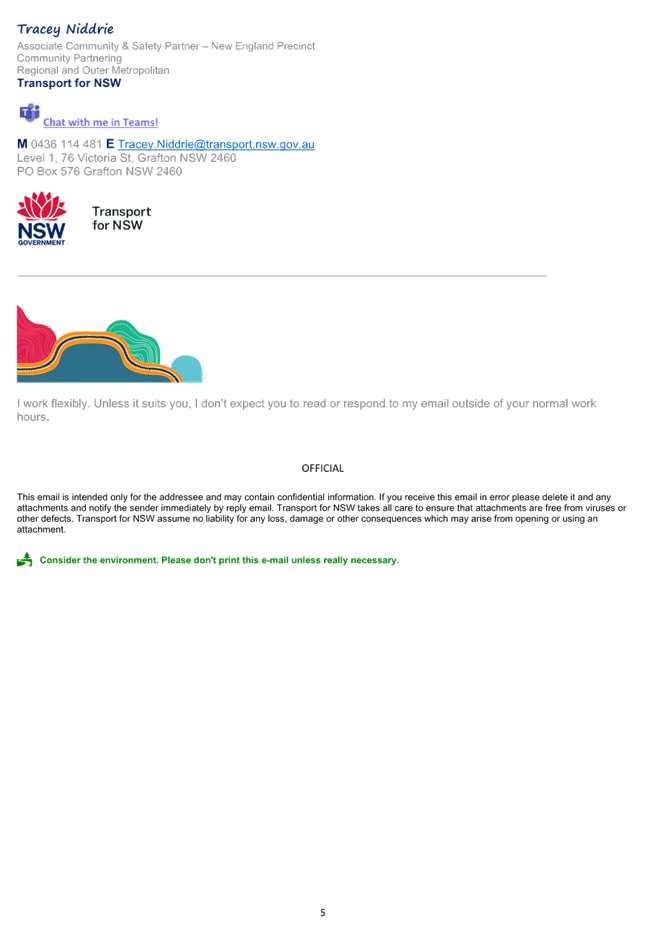
|
Ordinary Council Meeting Business Agenda
|
17 December 2024
|
14.7 Council
Provision of In Kind Support to NE Drum Runners
|
Department:
|
Infrastructure &
Development
|
|
Prepared By:
|
Director Infrastructure &
Development
|
|
Authorised By:
|
General Manager
|
|
Reference:
|
UINT/24/19430
|
|
Attachments:
|
1. ABHA
Certificate of Currency 2025 ⇩ 
|
|
LINKAGE TO INTEGRATED PLANNING AND REPORTING FRAMEWORK
|
|
Goal:
|
2. We
drive the economy to support prosperity
4. We
are an independent shire and well-governed community
1. We
have an accessible inclusive and sustainable community
|
|
Strategy:
|
2.1. An
attractive environment for the business sector
4.3. An
efficient and effective independent local government
1.1. A
growing community with an active volunteer base and participation in
community events
1.2. A
safe, active and healthy shire
|
Summary
Council has been approached by the New England Drum Runners
(NEDR), a newly formed not-for-profit barrel racing club based at Bundarra, to
provide in-kind support to its planned events.
The specific form of the requested in-kind support is the
periodic use of Council’s water truck for the purpose of dust suppression
at the club’s nine (9) planned events between January and December 2025.
If Council was to endorse the request Council’s
regular operational resource would operate the truck on the occasions requested
as a volunteer member of the organisation and would be covered by the
organisation’s insurance.
This report recommends that Council favourably consider the
request.
|
Recommendation
That Council resolves to provide the requested in kind
support in the form of periodic access and use of Council’s water truck
for New England Drum Runner events in Bundarra during the 2025 calendar year
on the basis that:
a) Council’s
truck operator resource becomes a volunteer member of the New England Drum
Runners;
b) The
New England Drum Runners accepts Council’s truck operator resource as a
volunteer member; and
c) The
New England Drum Runners Association maintains its Public Liability insurance
coverage of $20,000,000 for the period of the 2025 calendar year.
|
Report
The New England Drum Runners are a horse barrel racing group
which is an affiliate of the Australian Barrel Horse Association (ABHA). The
New England Drum Runners has requested that Council consider whether it is able
to provide in-kind support to a series of Bundarra based events which will be
managed by the NEDR during the 2025 calendar year.
The Australian Barrel Horse Association holds insurance
coverage for Public Liability claims (refer to Attachment 1).
Council currently provides “in-kind” support to
several other existing worthy activations and local events including, for
example, schools-based sporting and swimming activities, the annual Seasons of
New England and Thunderbolts Festival, the most recent Winter Solstice and
Uralla Christmas celebrations, and the annual Fairy Festival.
The principles Council has considered when previously
deciding to provide or not to provide such support can generally be described
as follows: to what extent will the activation support or sustain healthy
outcomes (sport-focussed events for example); build community connections;
build local business; or increase local amenity; social celebration; or
increased social amenity.
A secondary but important consideration is also the extent
to which the activation or event is actually driven by, and organised by, the
community itself.
In this instance it is recommended that the proposed in-kind
support would enable the New England Drum Runners to deliver, under their own
resources and effort, a series of events in Bundarra which meet or
substantially progress many of the social and societal principles sought by
Council and its community.
Conclusion
This report recommends that Council approve the provision of
the limited in-kind Council support requested by the New England Drum Runners.
Council Implications
Community Engagement/Communication
The recommendation would provide a substantive signal of
increased engagement between the Bundarra community and its Council.
Policy and Regulation
Nil.
Financial/Long Term Financial Plan
Nil for staff, inconsequential for plant.
Asset Management/Asset Management Strategy
Nil.
Workforce/Workforce Management Strategy
A single Council resource acting in the capacity of a volunteer
to the New England Drum Runners Association.
Legal and Risk Management
Controlled. Refer to the risk requirements as listed in the
recommendation.
Performance Measures
Nil.
Project Management
Director Infrastructure and Development.

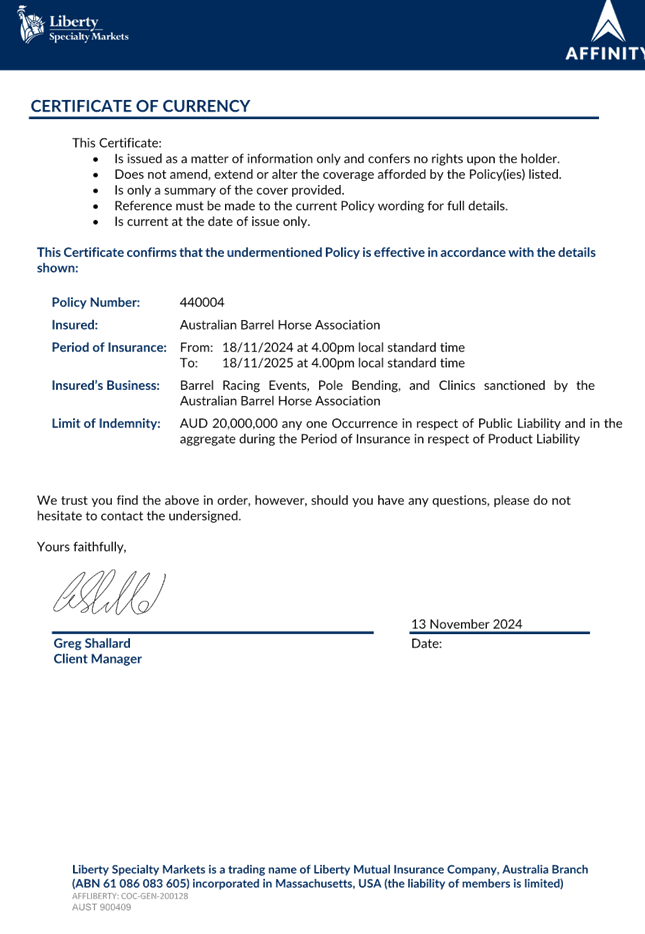
|
Ordinary Council
Meeting Business Agenda
|
17 December 2024
|
14.8 Loans
as at 30 November 2024
|
Department:
|
Corporate & Community
|
|
Prepared By:
|
Senior Finance Officer
|
|
Authorised By:
|
Director Corporate & Community
|
|
Reference:
|
UINT/24/20376
|
|
LINKAGE TO INTEGRATED PLANNING AND REPORTING FRAMEWORK
|
|
Goal:
|
4. We
are an independent shire and well-governed community
|
|
Strategy:
|
4.2. A
strategic, accountable and representative Council
|
Summary
This report provides Council with a reconciliation of
borrowings as at the end of the reporting month.
|
Recommendation
That Council notes that the total loan position as of
30 November 2024 is $1,245,918.
|
Report
This report is provided to inform Council of the
reconciliation of borrowings on a monthly basis. A reconciliation of borrowings
for the month of November confirmed that the loan position as of 30 November
2024 is $1,245,918.
The table below has been modified to provide details of
interest applied and instalments paid since the last report.

Conclusion
I, Rasel Siddique, Acting Manager Finance & IT hereby
certify that the above borrowings have been made in accordance with the
requirements of the Local Government Act 1993 (the Act) (Chapter 15, Part 12
– sections 621 to 624) and the Local Government (General) Regulation 2021
(the Regulation) (Section 230).
|
Ordinary Council
Meeting Business Agenda
|
17 December 2024
|
14.9 Investments
as at 30 November 2024
|
Department:
|
Corporate & Community
|
|
Prepared By:
|
Senior Finance Officer
|
|
Authorised By:
|
Director Corporate & Community
|
|
Reference:
|
UINT/24/20375
|
|
LINKAGE TO INTEGRATED PLANNING AND REPORTING FRAMEWORK
|
|
Goal:
|
4. We
are an independent shire and well-governed community
|
|
Strategy:
|
4.2. A
strategic, accountable and representative Council
|
Summary
This Report contains a summary of bank accounts, term
deposits, cash management accounts and investments in structured credit
instruments. The investments have been made in accordance with Section 625 of
Local Government Act 1993, Regulation 212 of the NSW Local Government (General)
Regulations 2021, and Council’s Investment Policy 2019.
|
Recommendation
That Council notes the cash position as of 30 November
2024 consisting of:
· cash and
overnight funds of $2,247,830;
· term deposits of
$24,350,000;
· total
convertible funds of $26,597,830 ($2,247,830 + $24,350,000) (including
restricted funds).
|
Report
Current term deposits of $24,350,000 spread over the next
twelve months will receive interest rates ranging from 4.90% to 5.45%, with an
average rate of 5.18%. Council’s General Fund bank balances (refer to the
Schedule of Cash at bank and Term deposits below) have been reconciled to the
bank statement as of 30 November 2024.
An additional table has been added to this report to provide
movement of term deposits with different banks.
key issues
Official cash rate
The current official cash rate as determined by the Reserve
Bank of Australia (RBA) is 4.35% as at the date of this report. The
timing of potential interest rate changes will be guided by the incoming data
and the RBA Board’s assessment of the outlook for inflation and the
labour market. The changes in interest rates have resulted in higher investment
returns this year.
McMaugh Gardens - Bond Liability
As per the Department of Health’s prudential
guidelines, the council is advised to disclose the amount of McMaugh
Garden’s bond liability in the investment report.
McMaugh Garden’s Bond liability status as of 30 November 2024 is shown
below:
Restricted and Unrestricted Cash, Cash Equivalents, and
Investments
Of the amount of cash disclosed in this report, not all the
cash is available for unrestricted use by Council. Most of the cash has been
set aside to meet external restrictions, being those funds that have been
provided for specific purposes such as developer contributions, government
grants, loans, water supplies, sewer services and Aged Care Bonds.
Additionally, a portion of the cash has been set aside to cover future
commitments that Council has made relating to asset renewals, remediation works
or leave provisions.
Most of the Council’s cash is externally restricted
and not available for day-to-day operational expenditure. As per
unaudited financial statements for the year ending 30 June 2024, the amount of
unrestricted cash reported in the audited financial statements is $1,878,692.
Council updates its restriction status at the end of each quarter, and the
updated restriction status is provided with the quarterly budget review
statements.

Conclusion
I, Rasel Siddique, Acting Manager – Finance & IT,
hereby certify that the above investments have been made in accordance with the
Section 212 of the Local Government (General) Regulation 2021, and section 625
of the Local Government Act 1993, and Council’s investment policy.
|
Ordinary Council
Meeting Business Agenda
|
17 December 2024
|
14.10 Monthly Finance
Report for November 2024
|
Department:
|
Corporate & Community
|
|
Prepared By:
|
Corporate Accountant
|
|
Authorised By:
|
Director Corporate & Community
|
|
Reference:
|
UINT/24/18108
|
|
Attachments:
|
1. Monthly
Financials-November 2024 ⇩ 
|
|
LINKAGE TO INTEGRATED PLANNING AND REPORTING FRAMEWORK
|
|
Goal:
|
4. We
are an independent shire and well-governed community
|
|
Strategy:
|
4.1. Informed
and collaborative leadership in our community
4.2. A
strategic, accountable and representative Council
|
Summary
The purpose of this report is to provide an overview of the
Council’s financial performance up to the reporting date, along with
analytical comments on significant variances with the budget.
|
Recommendation
That Council receives the attached Monthly Finance
Report for November 2024.
|
REPORT
This report provides for the information of Councillors the
Income Statement and CAPEX Summary, including a breakdown by fund, for the
month ending 31 October 2024.
|
Ordinary Council Meeting
Business Agenda
|
17 December 2024
|
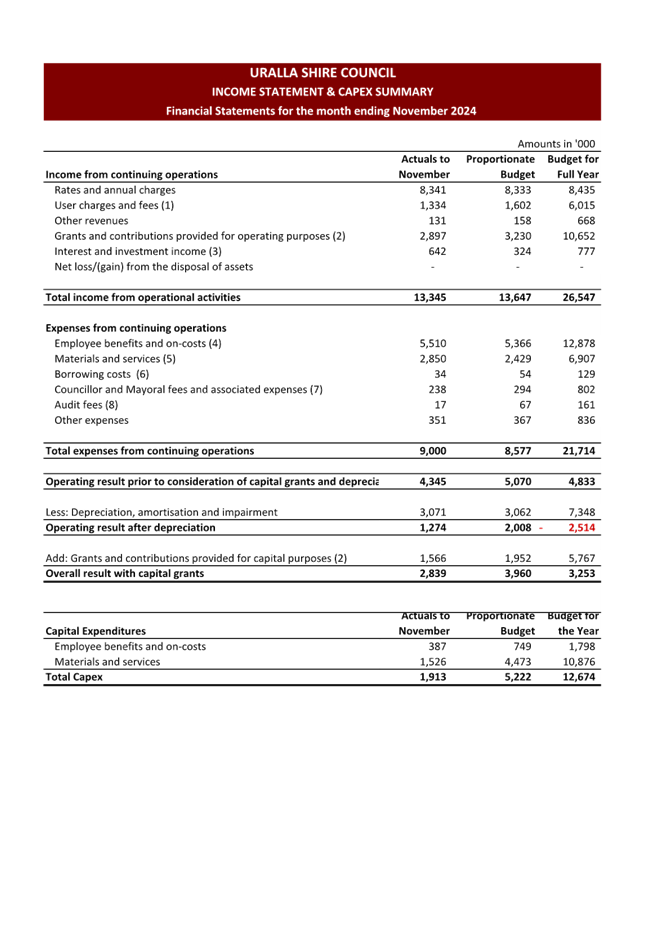

|
Ordinary Council
Meeting Business Agenda
|
17 December 2024
|
14.11 Debt Recovery
Update
|
Department:
|
Corporate & Community
|
|
Prepared By:
|
Corporate Accountant
|
|
Authorised By:
|
Director Corporate & Community
|
|
LINKAGE TO INTEGRATED PLANNING AND REPORTING FRAMEWORK
|
|
Goal:
|
4. We
are an independent shire and well-governed community
|
|
Strategy:
|
4.2. A
strategic, accountable and representative Council
|
Summary
At the Ordinary meeting of 25 June 2024, it was noted as
part of the budget review process that outstanding rates had been
increasing. As of 1 July 2024, there was a balance of $1,354,550 in
outstanding rates.
Debt recovery initiatives were subsequently implemented and
the total amount of outstanding rates as of 30 November 2024 was $818,002 (a
reduction of $523,150).
This report provides an update on the actions taken by
officers to recover the outstanding debts to date following the review of
Council’s current debt recovery process.
|
Recommendation
That Council notes the debt recovery update report.
|
Report
Historical
background:
Historically, a debt collection agency was engaged to assist
with debt recovery for the Council. However, during the COVID lockdowns, debt
recovery processes were paused by many Councils, including Uralla Shire Council
(USC).
In June 2024 it was identified that rate arrears had
increased significantly over the past few years. As a result, Council
initiated the debt recovery process in accordance with the USC Debt Recovery
Policy 2020 (the Policy). The process involves a reminder letter to ratepayers
with outstanding debt, with a follow-up reminder letter 14 days later if
required. Any ratepayers with a debt greater than $1,000 are then
referred to a debt recovery agency.
Outcome
of Reminder Letters:
The first reminder letter was sent on 16 July 2024 to 498
property owners with outstanding rates exceeding $100. A second reminder was
issued on 8 August 2024 to 309 property owners with outstanding rates over $100
as of 31 July 2024.
Since follow-up efforts began in July 2024 the council has
recovered $523,150. Additionally, 29 payment arrangements totalling $117,253
have been finalised. By 30 November 2024, arrears from the 2023-24 period had
decreased to $818,002 (refer Table below: Movements of Arrear Rates as of 30
November 2024).
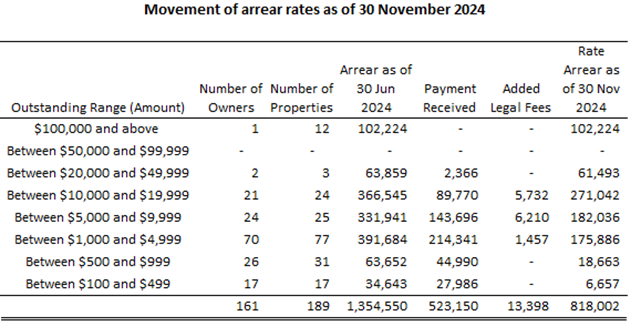
Next Steps in the Debt Recovery Process:
Council has engaged SR Law, an authorised Local Government
debt collection agency with significant experience in regional local
government, to assist with the next phase of the debt recovery process.
Debt recovery will be in accordance with Council’s current 2020 Debt
Recovery and Hardship Policies, and will take into consideration the impact of
financial stress on the wellbeing of the relevant Uralla shire ratepayers.
SR Law will review each ratepayer cohort (referred to as
‘Outstanding Range’ in the above table) and recommend an
appropriate debt recovery approach based on the cohort size, duration of the
arrears, number of properties involved per ratepayer, and the cost to service
the debt recovery. Recommendations may range from a Letter of Demand to a
letter offering a payment plan.
Ratepayers with payment plans (29 ratepayers, or 18% of the
total group, with a combined debt of $117,253 outstanding), will continue to be
managed by the Finance team. It is noted that as of 30 November 2024
$35,800 has been received through payment plan instalments.
Council is also undertaking a review of the current Debt
Recovery and Hardship Policies in accordance with best practice for small
regional Councils and with the assistance of SR Law.
The draft revised policies are to be presented at the March
2025 Audit and Risk Improvement Committee (ARIC) prior to a final report to
Council in March 2025.
cONCLUSION
In partnership with SR Law, Council will adopt a case
management approach towards debt recovery of rate arrears. SR Law has
commenced the legal phase of debt recovery, on behalf of Council. The
wellbeing of ratepayers will be factored into the debt recovery process with
information provided about financial counselling and other available support
services. Regular reporting to Council on debt recovery progress will
continue.
COUNCIL IMPLICATIONS
Community
Engagement/Communication
Community consultation of the
revised Debt Recovery Policy and Hardship Policy will take place in April
2024. There will be ongoing positive and supportive communication with
ratepayers who have outstanding rates from both Council employees and SR Law.
Policy and Regulation
o Uralla
Shire Council Debt Recovery Policy 2020
o Local
Government Act 1993
o Local
Government Regulations (General) 2005
o Local
Government Code of Accounting Practice and Financial Reporting
o Australian
Accounting Standards.
Financial/Long Term Financial
Plan
There is a negative impact on cash
flow management when outstanding debts are not collected on time.
Workforce/Workforce Management
Strategy
Education for Council employees,
especially the Finance and Customer Support teams, of the new policies and procedures
for debt recovery and hardship will be required before implemented.
Legal and Risk Management
There was an issue of incorrect contact details for
ratepayers due to address changes of owners without advice to Council.
This risk was managed through phone calls, emails, and other forms of research
to establish correct contact details and updates to the council database.
|
Ordinary Council
Meeting Business Agenda
|
17 December 2024
|
14.12 s355 Committees
|
Department:
|
Infrastructure &
Development
|
|
Prepared By:
|
Director Infrastructure &
Development
|
|
Authorised By:
|
General Manager
|
|
Reference:
|
UINT/24/17413
|
|
Attachments:
|
1. Submission
on Future of UTEC ⇩ 
2. Terms
of Reference - Bundarra School of Arts Hall and Community Consultative s355
Committee ⇩ 
3. Terms
of Reference - Uralla Township and Environs Committee (UTEC) ⇩ 
|
|
LINKAGE TO INTEGRATED PLANNING AND REPORTING FRAMEWORK
|
|
Goal:
|
4. We
are an independent shire and well-governed community
|
|
Strategy:
|
4.1. Informed
and collaborative leadership in our community
4.2. A
strategic, accountable and representative Council
4.3. An
efficient and effective independent local government
|
Summary
Council’s previously
appointed s355 committees, being the Bundarra School of Arts Committee and the
Uralla Township and Environs Committee, have both automatically ceased their
respective terms of appointment as a natural consequence of the recent local government
elections.
This report recommends that
Council awaits the outcomes and learnings of the current ‘Striking a New
Deal’ (SaND) Project prior to reconsidering the respective committee
Terms of Reference and the reestablishment of either of the committees at a
future time.
|
Recommendation
That Council receives a
future report regarding the replacement need and potential terms of reference
for the Bundarra School of Arts and Uralla Township and Environs Committee
following the completion and analysis of the current Striking a New Deal
Project.
|
Report
Council, utilising section 355 of
the Local Government Act previously appointed two advisory committees which
have now reached their natural end of term three months after the most recent
local government election.
Council issued differing Terms of
Reference to each committee at the time of appointment to achieve appropriate
points of focus for each committee. The different objectives for each committee
reflected the different needs of the two communities represented at that time.
Generally, however, both
committees were intended to play a key role in providing advice to Council;
largely strategic advice in the case of UTEC, and more operationally focussed
advice in terms of the Bundarra committee. Both committees during their terms
provided Council with a demonstrable example of planned and proactive
engagement with the community. Some members of both committees admitted to
suffering a sense of frustration at times with their lack of impact (refer to
attached copies of feedback from the most recent UTEC Committee members).
Several issues have limited the
opportunity for the committees to realise their full potential impact and value
on Council’s decision making and priority setting. A principal limiting
factor which impacted the committees was an ongoing difficulty in recruiting
and then maintaining the appropriate membership numbers. This issue itself
naturally limited the range of views which were consequently raised and
debated.
Prior to considering the
reestablishment of the committees, this report recommends that Council await
the learnings and outcomes of the impending Striking a New Deal (SaND) Project.
This facilitated project will work with Council to increase the capacity of the
wider community to engage effectively regarding their vision, expectations and
priorities. It is anticipated it will help establish how, when, to what level,
and on which issues the community wishes to be consulted.
This information should be
expected to provide a detailed insight into the potential future role of s335
committees and the most appropriate and enabling Terms of Reference for those
committees.
Conclusion
Council’s s355 committees
have been naturally disbanded. This report recommends Council await the
learnings of the SaND Project before considering the reestablishment of any
s355 committees or the settlement of their attending Terms of Reference.
Council Implications
Community Engagement/Communication
Council is empowered to appoint committees under s355 of the
NSW Local Government Act.
Policy and Regulation
Nil
Financial/Long Term Financial Plan
Nil
Asset Management/Asset Management Strategy
Nil
Workforce/Workforce Management Strategy
Nil
Legal and Risk Management
Nil
Performance Measures
Nil
Project Management
Nil
|
Ordinary Council Meeting
Business Agenda
|
17 December 2024
|

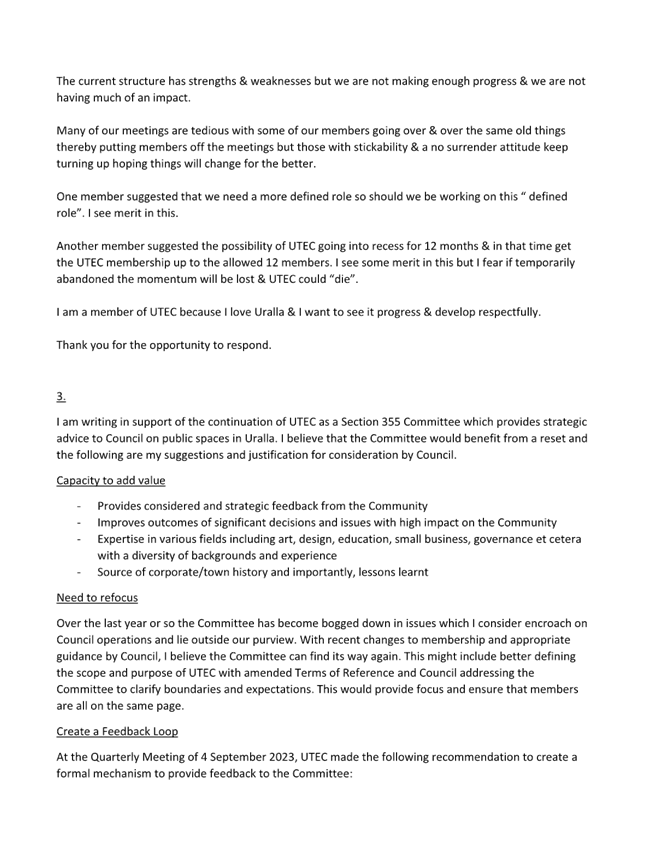
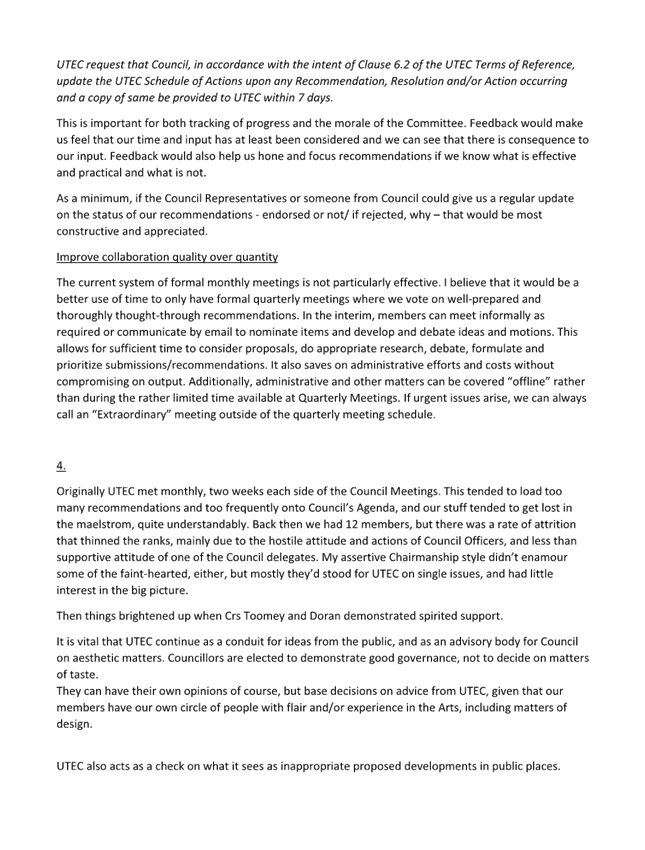
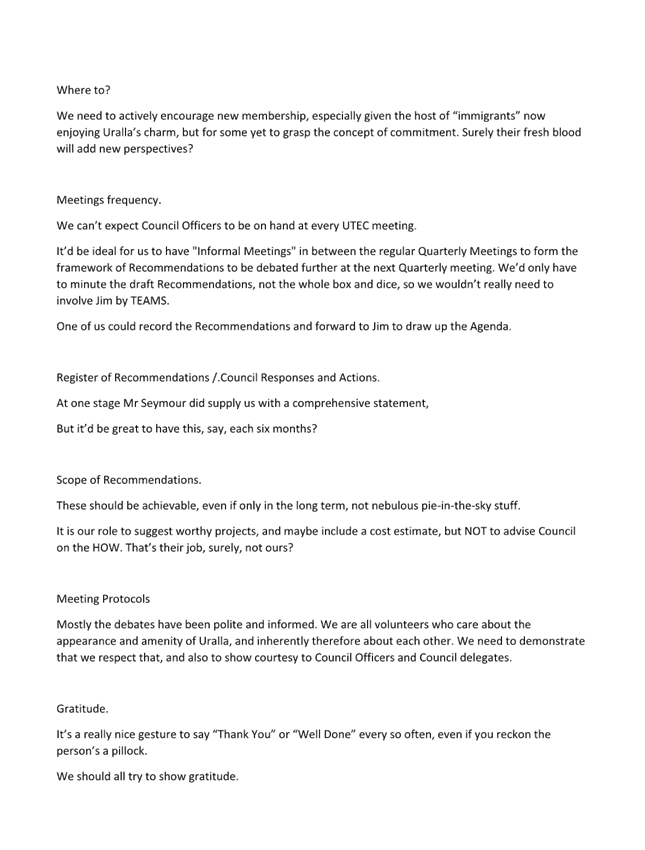
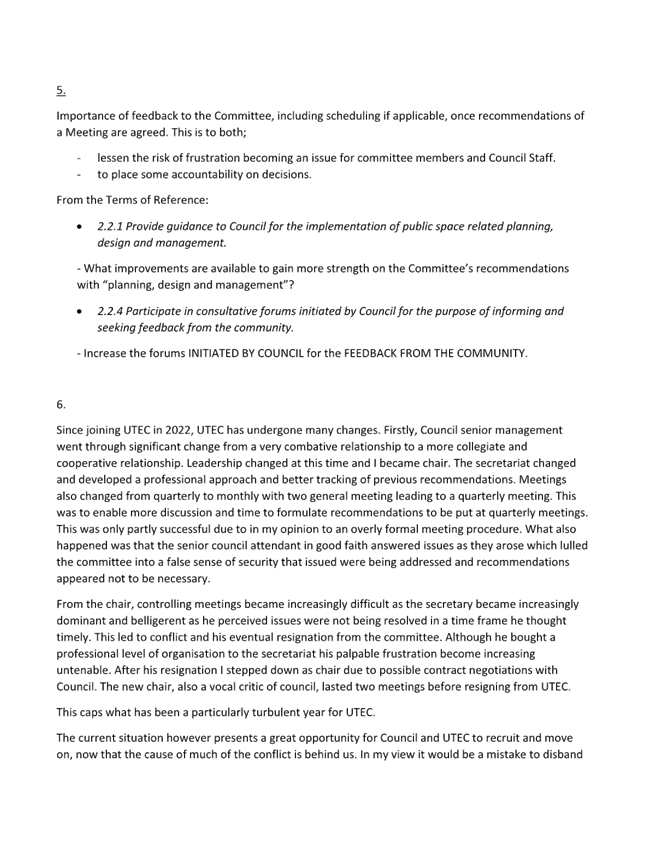

|
Ordinary Council Meeting Business Agenda
|
17 December 2024
|



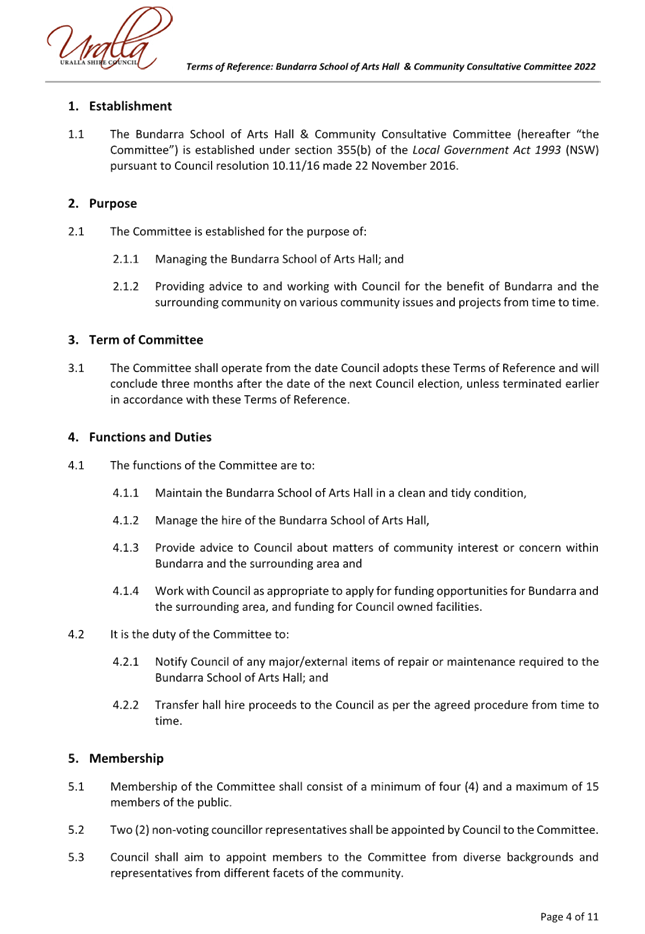
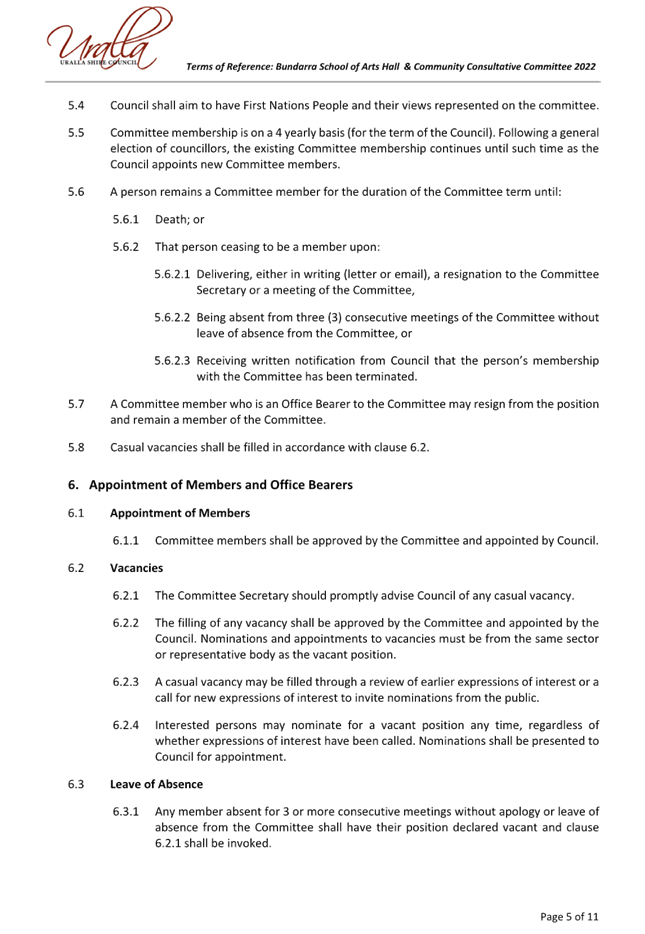
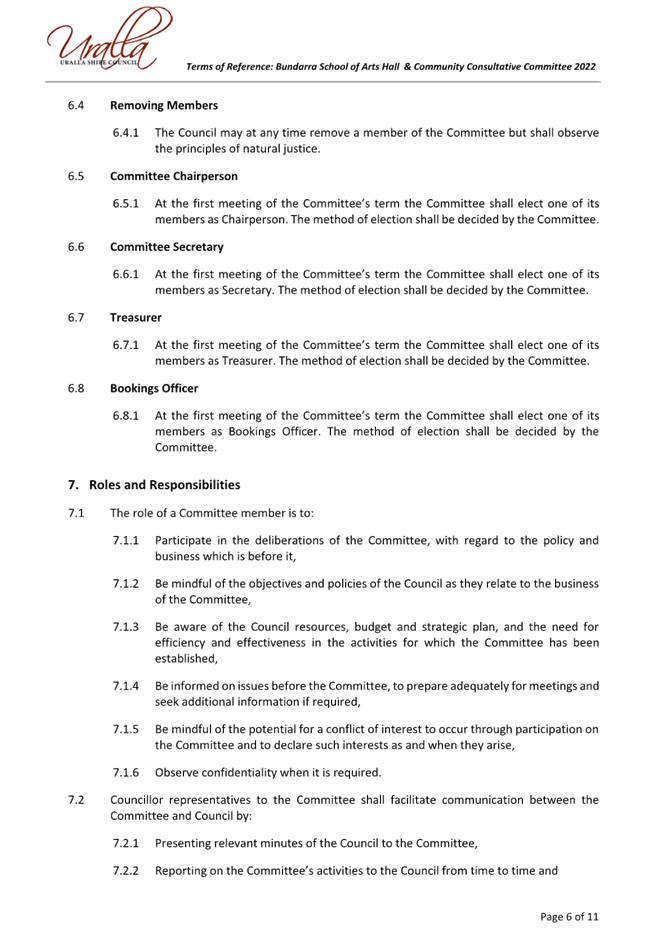
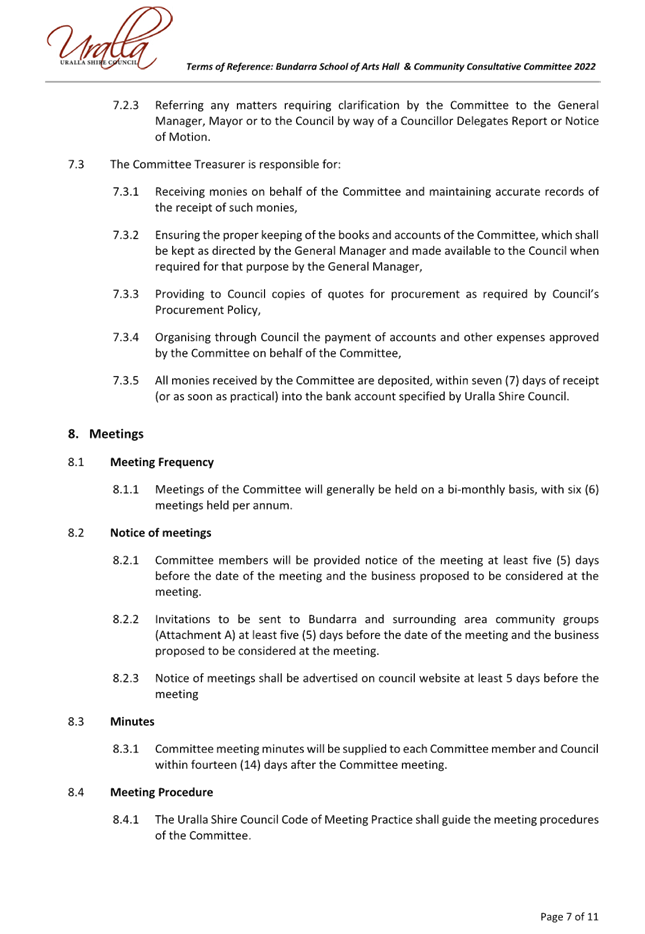


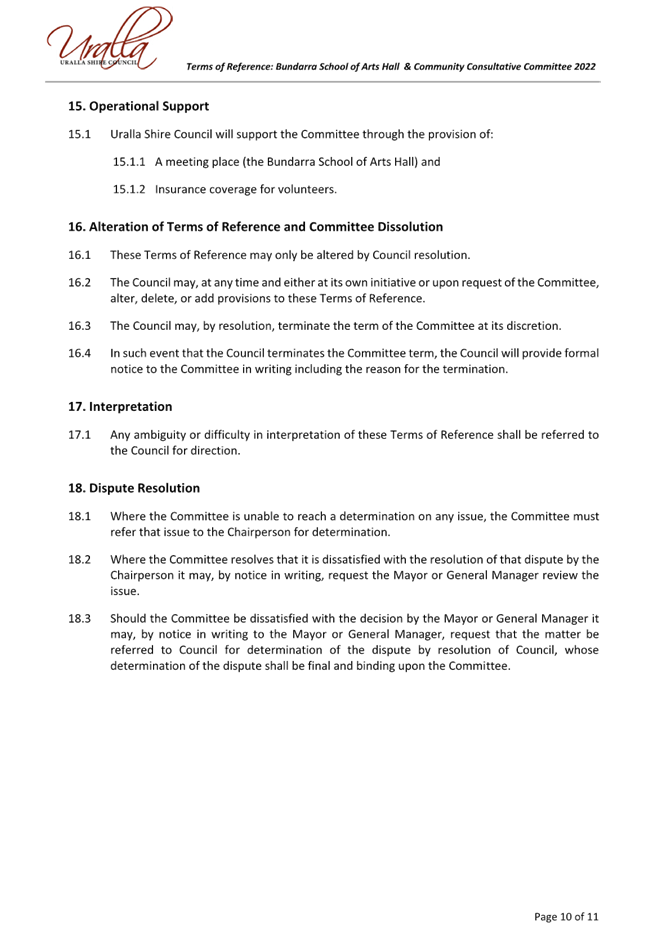

|
Ordinary Council Meeting Business Agenda
|
17 December 2024
|
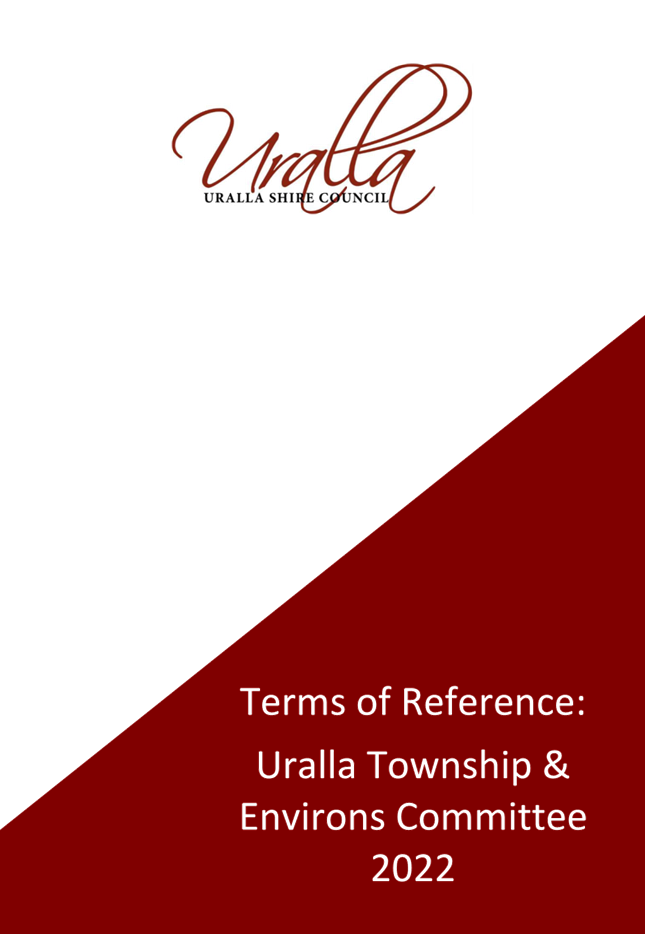
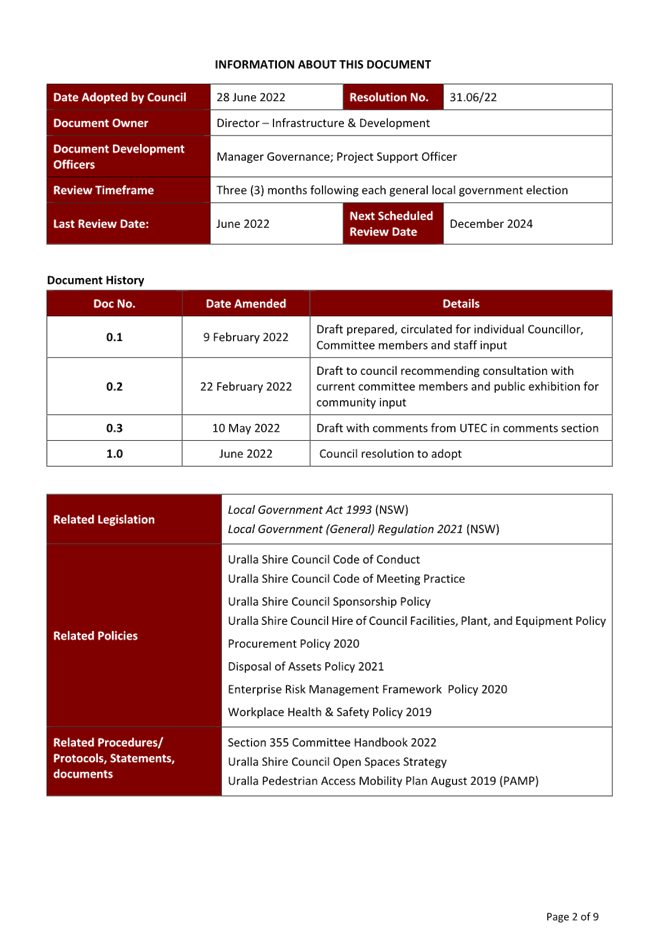
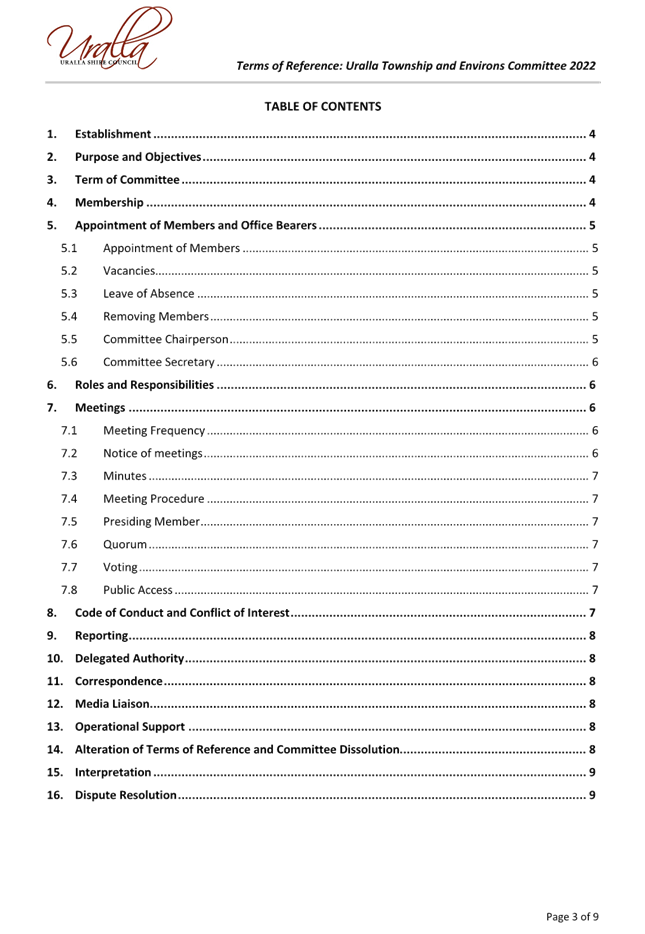
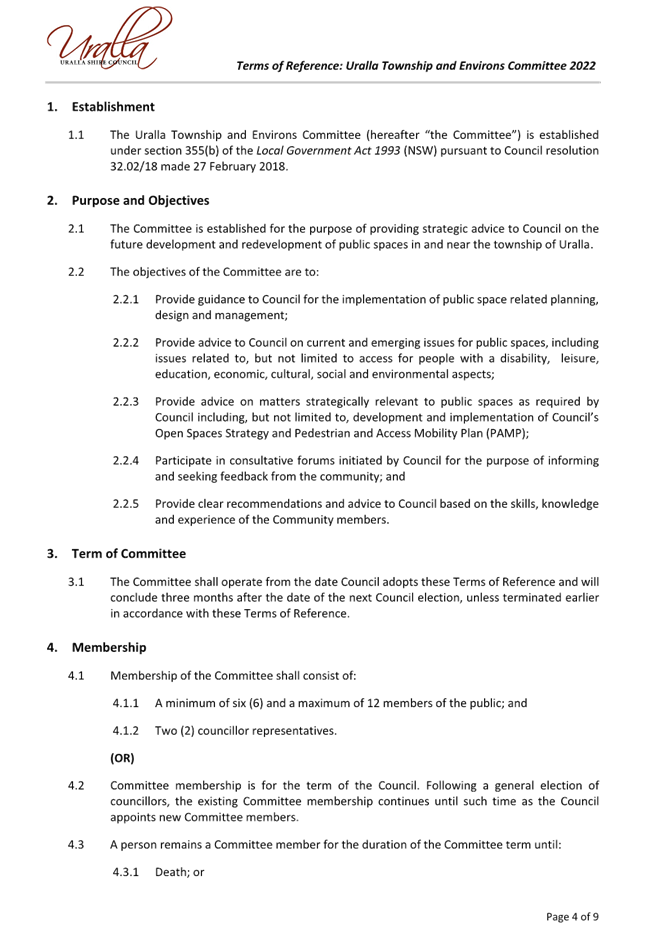
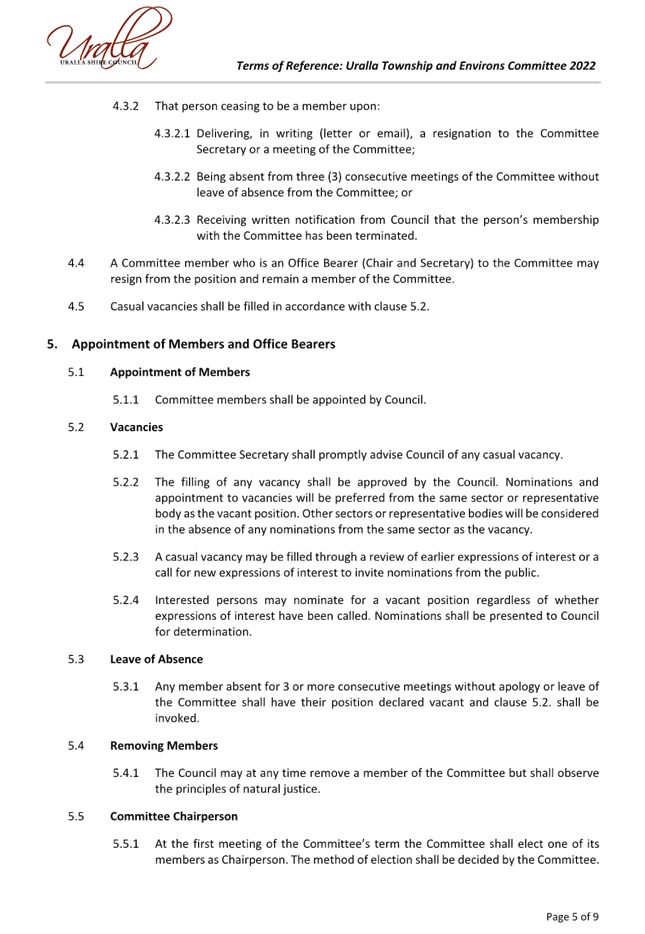
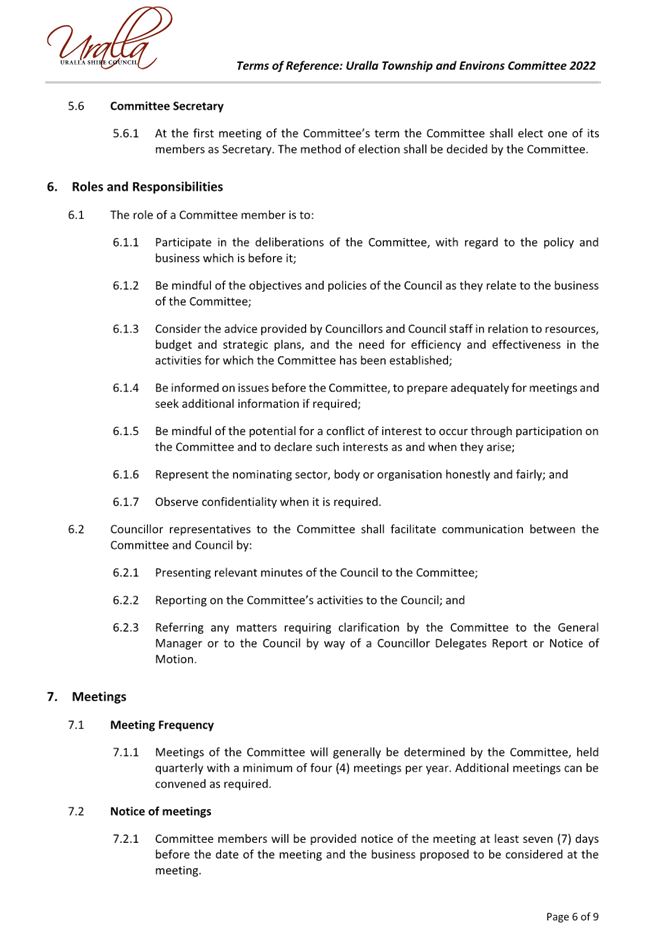
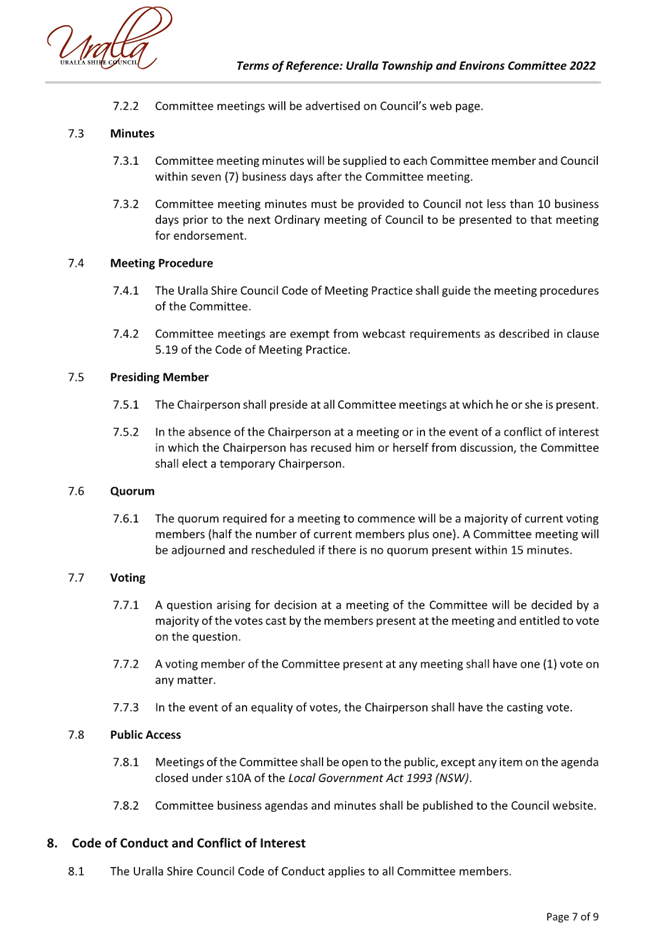
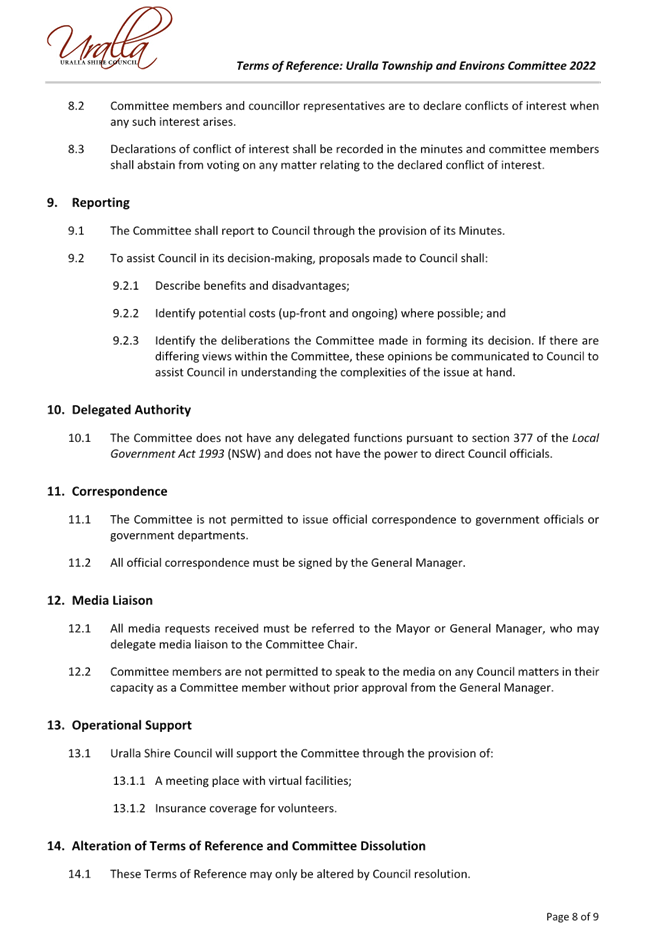
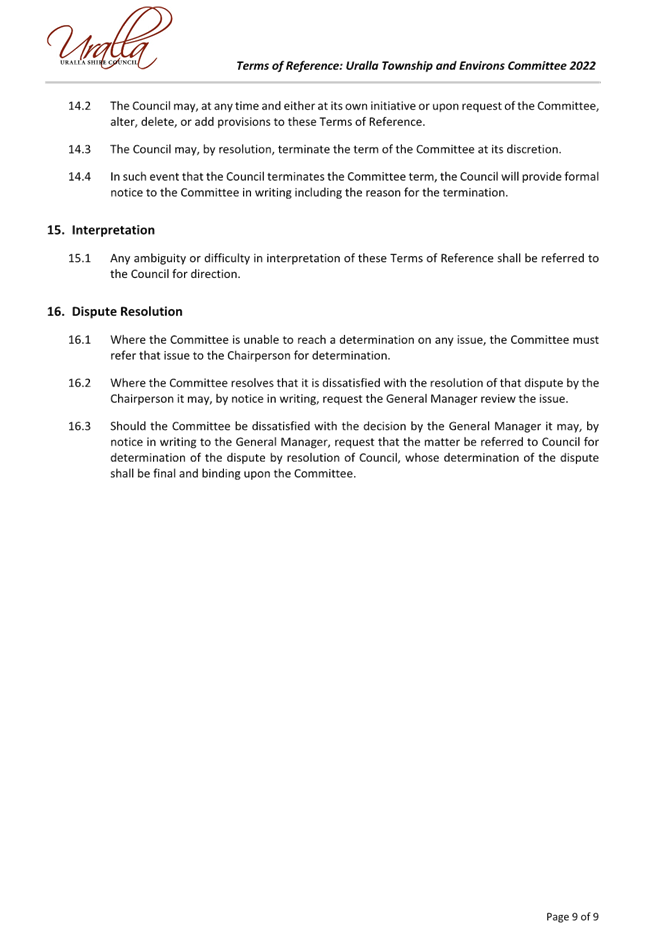
|
Ordinary Council
Meeting Business Agenda
|
17 December 2024
|
14.13 Council
Instrument of Delegation - General Manager
|
Department:
|
Corporate & Community
|
|
Prepared By:
|
Manager Governance and
Service Centre
|
|
Authorised By:
|
Director Corporate & Community
|
|
Reference:
|
UINT/24/19888
|
|
Attachments:
|
1. Delegations
of General Manager 2024 ⇩ 
|
|
LINKAGE TO INTEGRATED PLANNING AND REPORTING FRAMEWORK
|
|
Goal:
|
4. We
are an independent shire and well-governed community
|
|
Strategy:
|
4.3. An
efficient and effective independent local government
|
Summary
A governing body of council may delegate certain
functions to the General Manager. Such delegations must be made by a council
resolution (Chapter 12 Part 3 ss 377-381 of the Local Government Act 1993 (‘LG
Act’)).
The General Manager has delegations from the previous Council term
which need to be reviewed and renewed (s 380 of the LG Act).
A review of the form and content of the delegation has been undertaken
to make the delegations consistent with the proposed Community Engagement
Strategy, and to address potential risks to Council arising from the language
used in the current delegations to the General Manager.
The proposed changes to the current delegations to the General Manager
are at clause 6 of schedule 1, which deals with the assessment and
determination of a Development Application (‘DA’) under the Environmental
Planning and Assessment Act 1979 (‘EPA Act’). These proposed changes
are summarised below:
· 3(a) – It is
proposed to change this provision so that a DA will be referred to Council for
determination if three (3) or more written submissions objecting to the
development subject of the DA are received during the public exhibition period.
· 3(d) – It is
proposed to delete this clause. The current wording requires that
non-compliance with any control of Council requires that the DA be referred to
Council for determination.
· 3(e) - This clause
has been amended to remove the requirement for modification applications (made
under s 4.55 of the EPA Act) to be referred to Council for determination.
The purpose
of this report is to present
the revised instrument of delegation to Council for endorsement.
|
Recommendation
Any previous delegation to the General Manager be
revoked and Council delegate to the General Manager the “Instrument of
Delegation - General Manager” attached to this report.
|
Report
The General Manager has delegations from the previous Council term
which need to be reviewed and renewed (s 380 of the LG Act). The proposed
instrument of delegations is based upon the current delegations to the General
Manager.
Delegations and
authorisations are the mechanism by which the Council enables its officers to
act on its behalf by transferring responsibility for decision making through
the organisation. They enable Council to carry out its functions and to be
accountable for the decisions and actions taken on its behalf under specific
legislative and policy provisions. The underlying principle is that those tasked
with the responsibility to carry out a function should have the corresponding
authority to carry it out.
Council’s
general power to delegate its functions is contained within Section 377 of the LG
Act. Section 377 also expressly exempts specific functions from being
delegated. The instrument of delegation outlines the range of decisions and/or
exercise of powers and functions available to the General Manager.
Only the General Manager can
sub-delegate a function to council officers. It is important therefore to
ensure that the delegation made to the General Manager covers all the
legislative and regulatory functions tasked to officers of the Council. Failure
to properly delegate all functions to the General Manager can nullify any
instrument of sub delegation and potentially render as void decisions or
actions of Council, which exposes Council to risk.
The Council’s current
delegation to the General Manager has been amended over time. Clause 6 of
schedule 1 provides restrictions on the determination of a DA. It is proposed
to amend the current instrument of delegation at clause 6(3) of schedule 1 as
set out below:
1. 6
(3)(a) – This has been changed so that a DA will be referred to Council
for determination if three (3) or more written submissions objecting to the
development subject of the DA are received during the public exhibition period.
2. 6
(3)(d) – This clause is proposed to be deleted on the basis that the
current wording would require that any non-compliance with any control of
Council requires that the DA be referred to Council for determination.
3. 6
(3)(e) - This clause has been amended to remove the requirement for
modification applications (made under s 4.55 of the EPA Act) to be referred to
Council for determination.
The reason for the proposed
amendment is to align the delegations to the General Manager with the proposed
Community Engagement Strategy. It will reduce any potential for ambiguity in
the written instrument of delegations. Further, it will reduce the volume of
planning applications which are required to be referred to Council for
determination.
In the recent decision of Filetron
Pty Ltd v Innovate Partners Pty Ltd atf Banton Family Trust 2 and Goulburn
Mulwaree Council [2024] NSWCA 41 NSW (‘Filetron’), the Court of
Appeal held that a DA determined under delegation by a Council officer was
invalid on the basis that the DA was required to be referred to Council for
determination. This issue arose due to ambiguity around the circumstances in
which a DA was required to be referred to Council for determination.
Revision to clause 6 (3)(a) of
schedule 1
The current delegation at clause 6
(3)(a) of schedule 1 requires that a DA be referred to Council for
determination if ‘the DA comprises one or more of the following elements
… Public interest (any submission opposing the development received
during the public exhibition period)’. “Public interest” is
not defined in the instrument of delegations. This exposes Council to risk as
the normal meaning of “public interest” is very broad and captures
a wide range of matters.
To reduce ambiguity around this
condition on the delegation to the General Manager, it is proposed to amend
this referral requirement to three (3) or more submissions by way of objection.
It is recommended that a numerical control on the delegations be imposed,
rather than any qualitative or subjective requirement, for example having a
requirement that any ‘unresolved submission’ means that the DA
needs to be referred to Council for determination.
Deletion of clause 6 (3)(d) of
schedule 1
The current delegation at clause 6
(3)(d) of schedule 1 requires that a DA be referred to Council for
determination if ‘the DA comprises one or more of the following elements
… Non-compliance with the relevant prescribed planning controls or a
proposal involving a qualitative planning matter that cannot be resolved by
conditions of consent’.
The proposed deletion of clause 6
(3)(d) is to provide greater flexibility to the assessing and determining
delegate in circumstances where a DA may not strictly comply with
Council’s development controls.
Section 4.15(3A)(b) of the EPA Act
requires that if a DA does not comply with the standards set out in its
development control plan, the consent authority [Council] is to be flexible in
applying those provisions and allow reasonable solutions that achieve the objects
of those standards for dealing with that aspect of the development.
The current delegations require
for example, that DA which proposes a minor variation to Council’s
setback requirements be referred to Council for determination. Having to refer
all minor variations to Council’s controls will delay development which
is otherwise approvable and adds additional matters to Council’s agenda
for its ordinary meeting. This reduces Council’s overall efficiency when
assessing DAs.
In addition, the current wording
refers to ‘qualitative planning matter’, the meaning of this phrase
is ambiguous and lacks clarity as to what would be considered to be a
‘qualitative planning matter’. This ambiguity exposes Council to
risk if an objector were to challenge what would be considered to be a
‘qualitative planning matter’ in any appeal filed with the Land and
Environment Court.
Revision to clause 6 (3)(e) of
schedule 1
The current delegation at clause 6
(3)(d) of schedule 1 requires that a modification application under s 96 [now s
4.55] of the EPA Act, other than a modification application made under s 96(1)
[now s 4.55(1)] to correct a minor error, or misdescription or miscalculation,
be referred to Council for determination.
A consent authority does not have
the power to approve a modification application unless the development subject
of the modification application is ‘substantially the same’ as
development approved in the original grant of consent. This means that any
amendment to a DA is not going to result in approval of a DA which is radically
different from a DA previously determined by Council.
The proposed removal of this
referral requirement will improve efficiency in the determination of
modification applications and reduce the workload for Council at its ordinary
meetings.
The Council’s endorsement of
the proposed amendments to the instrument of delegation does not fetter its
authority to call up an application for its consideration and determination. Further,
it does not restrict the General Manager from seeking further direction from
Council concerning any of the delegated functions relating to the assessment
and determination of a DA.
Conclusion
The instrument of delegation for
the General Manager is a critical delegation for the organisation.
The current instrument of
delegation has been reviewed and updated to align with current policy in order
to optimise the efficient and effective management of Council’s
operations and to reduce its risk in light of the Court of Appeal’s
recent decision on instruments of delegation in Filetron.
Council Implications
Community Engagement/Communication
The amendment to the
delegations aligns with the proposed amendment to the Community Engagement
Strategy.
Policy and Regulation
A review of the General
Manager’s delegation falls within the good governance framework. Section
377 of the Act allows Council to delegate to the General Manager other than
those items specified in the section.
Financial/Long Term Financial Plan
The administration and
implementation of Council’s delegations is the responsibility of the
governance program utilising existing resources.
Asset Management/Asset Management Strategy
Not applicable
Workforce/Workforce Management Strategy
Delegations are attached to
positions within the organisation and provide clarity for the relevant staff
member.
Legal and Risk Management
Corporate Governance –
the delegation complies with legislative requirements. This risk is assessed as
low.
Project Management
Manager Governance and Service Centre
|
Ordinary Council Meeting
Business Agenda
|
17 December 2024
|
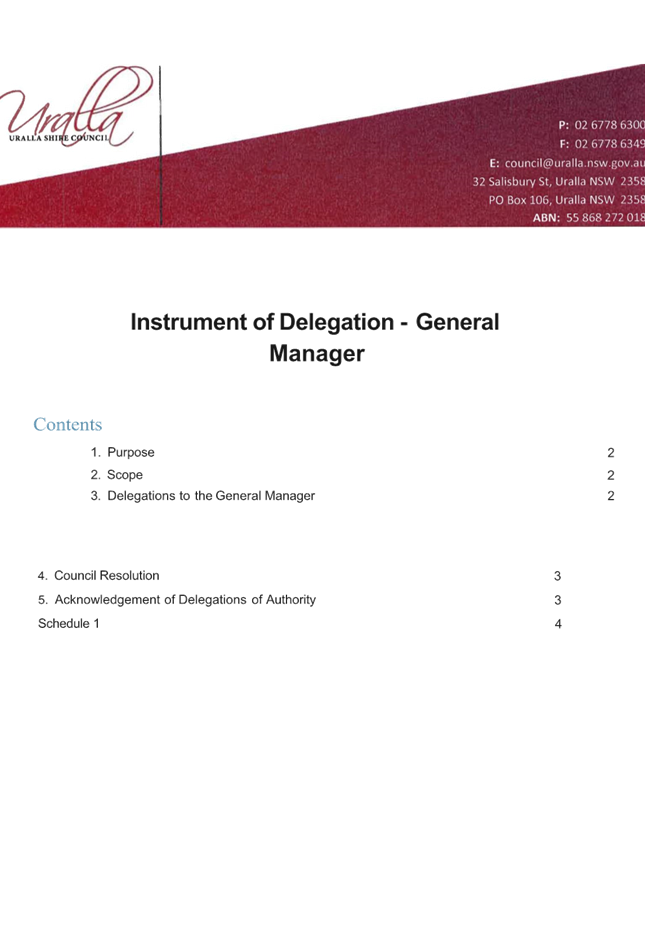
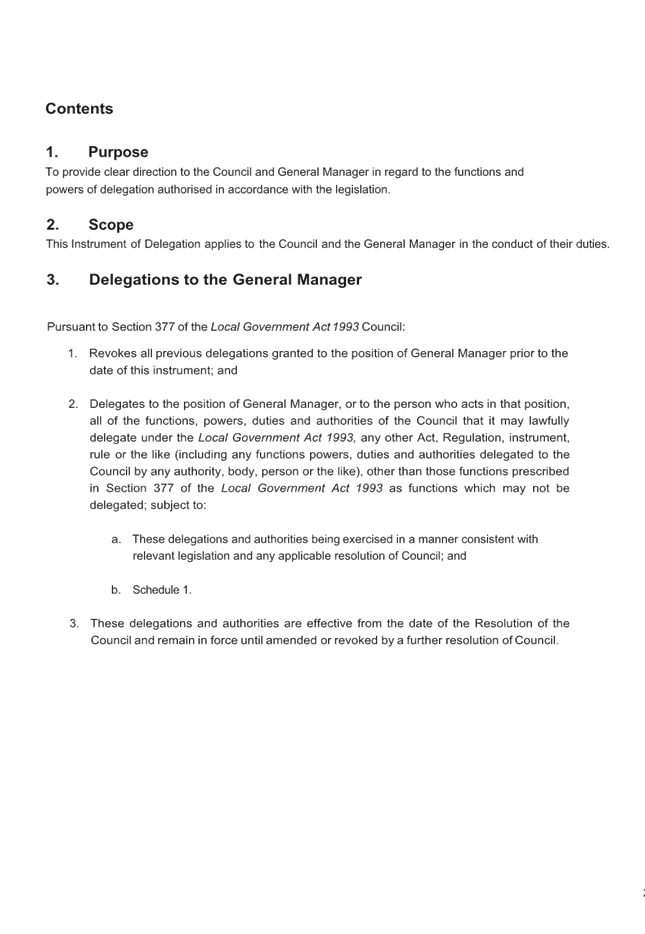
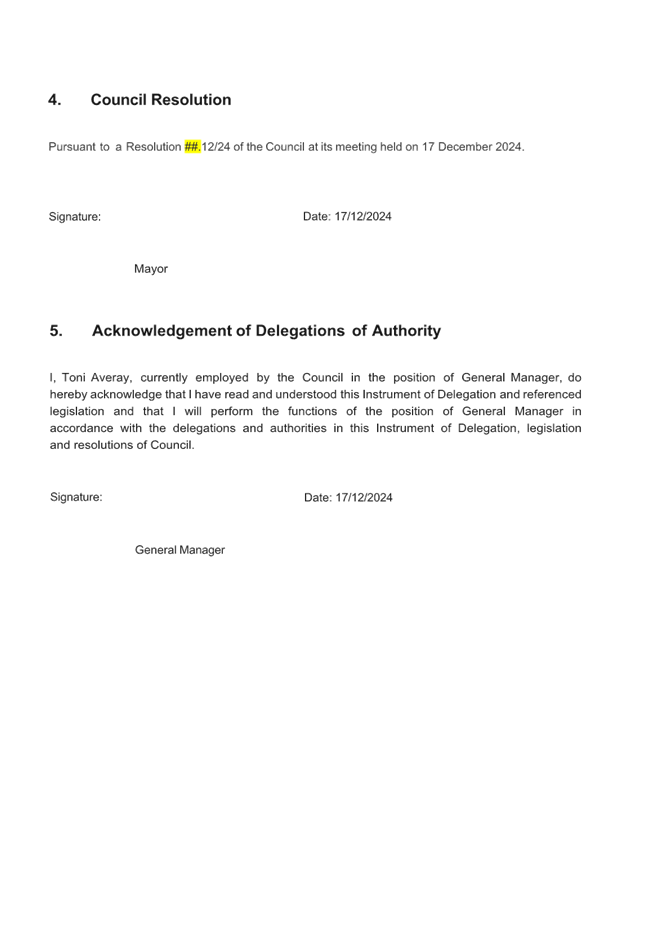
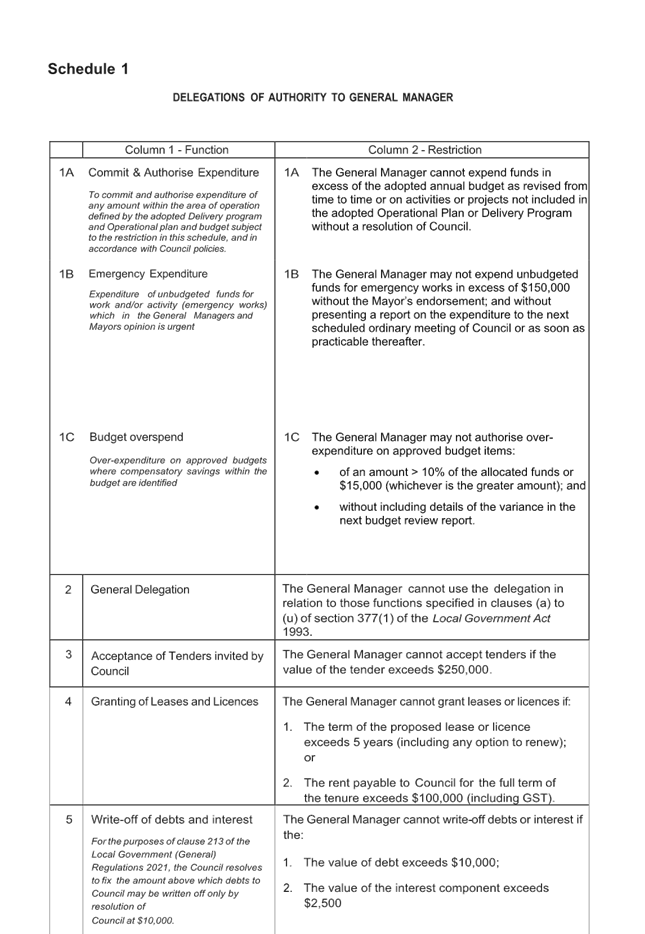
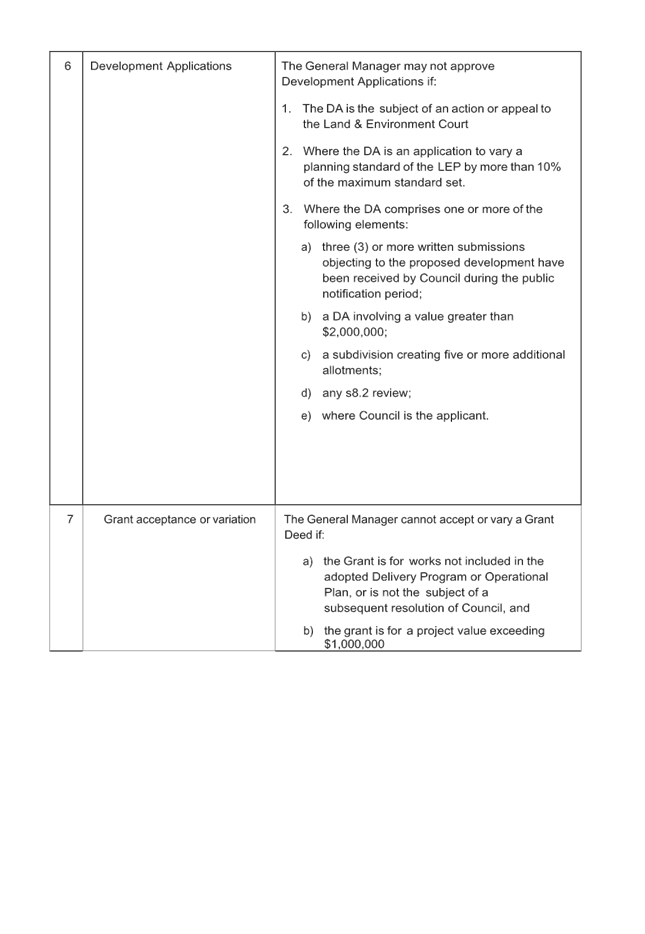
|
Ordinary Council
Meeting Business Agenda
|
17 December 2024
|
14.14 Register
Resolutions Actions Status as at 11 December 2024
|
Department:
|
General Manager’s
Office
|
|
Prepared By:
|
Executive Assistant
|
|
Authorised By:
|
General Manager
|
|
Reference:
|
UINT/24/20058
|
|
Attachments:
|
1. Resolutions
Actions Status Report for 17 December 2024 Ordinary Meeting ⇩ 
|
|
LINKAGE TO INTEGRATED PLANNING AND REPORTING FRAMEWORK
|
|
Goal:
|
4. We
are an independent shire and well-governed community
|
|
Strategy:
|
4.1. Informed
and collaborative leadership in our community
|
Summary
The purpose of this report is to provide Council with the Resolution
Action Status updates.
|
Recommendation
That Council notes the Resolution Actions Status Report
as at 11 December 2024.
|
Report
Following every council meeting, the resolutions of Council
which require action are compiled. This document is referred to as the
Resolutions Action Status Report.
The purpose of the Resolutions Action Status Report is to enable
Council to monitor progress of resolutions until they are actioned.
Once resolutions have been completed they are removed
automatically from the report.
Conclusion
The Resolutions Action Status Report is presented to Council
at each Ordinary Meeting.
|
Ordinary Council Meeting
Business Agenda
|
17 December 2024
|
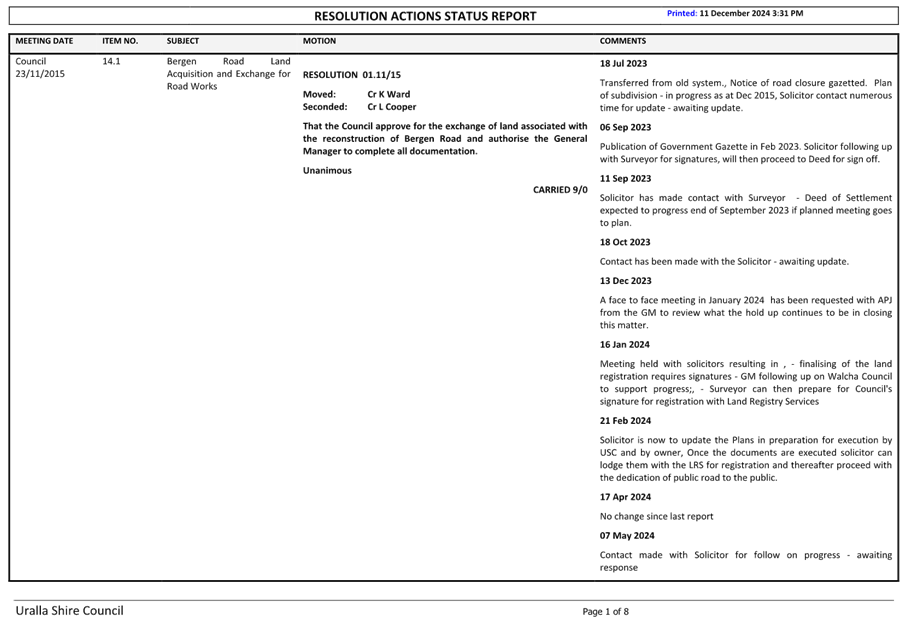
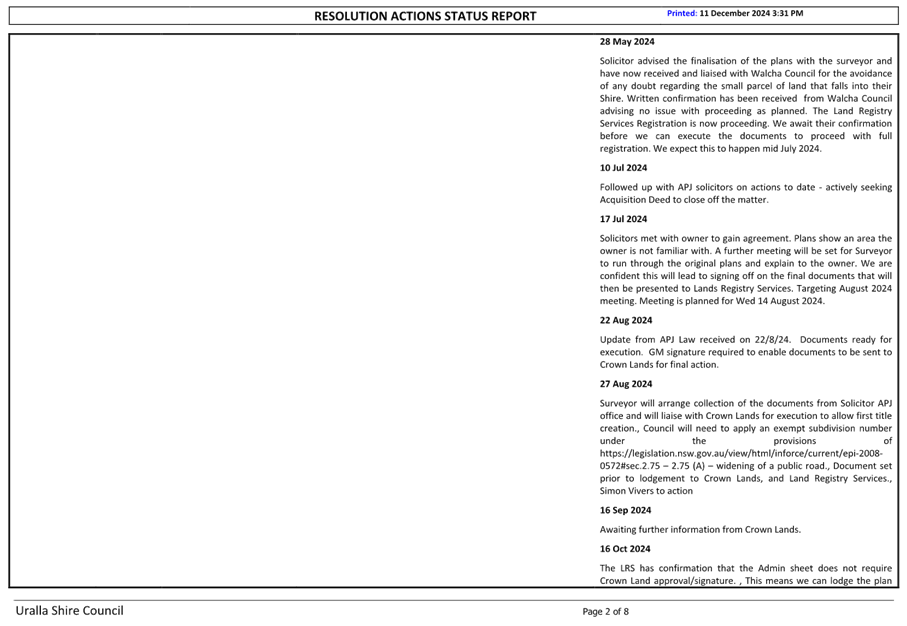
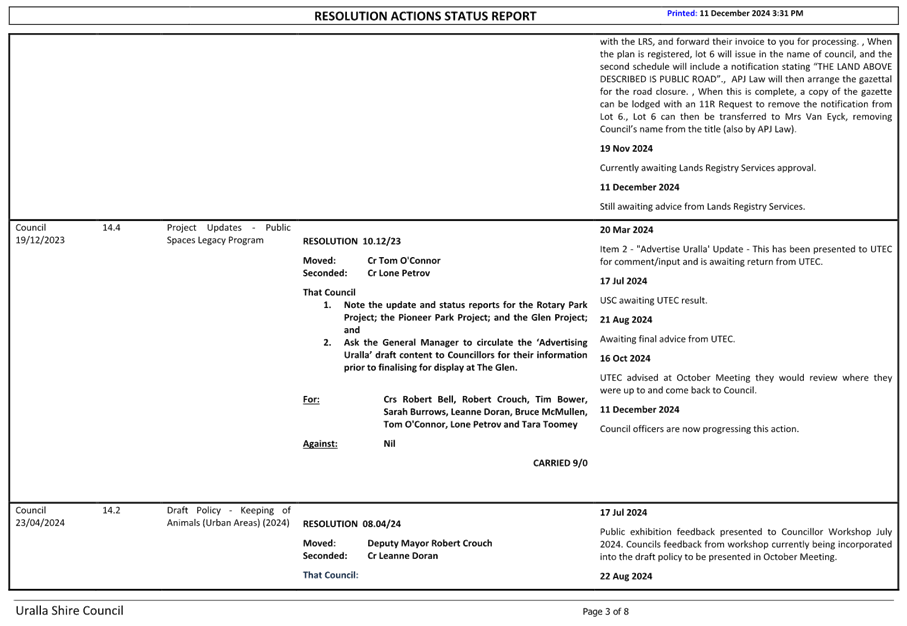
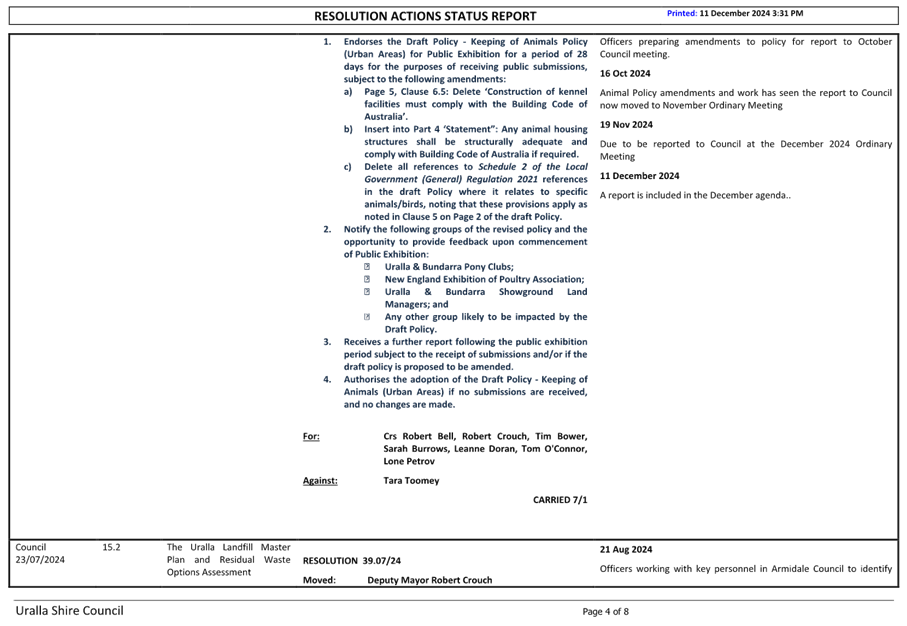

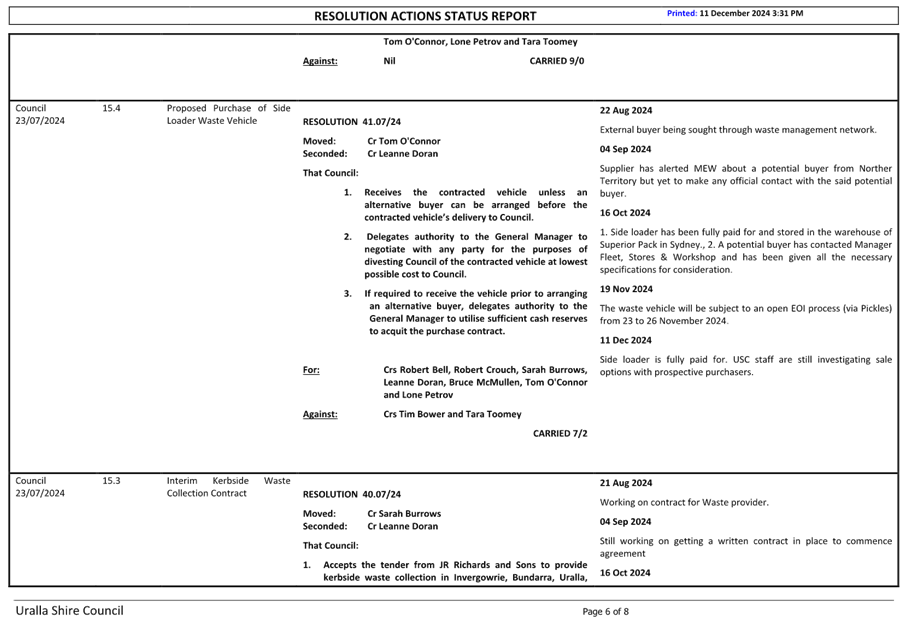
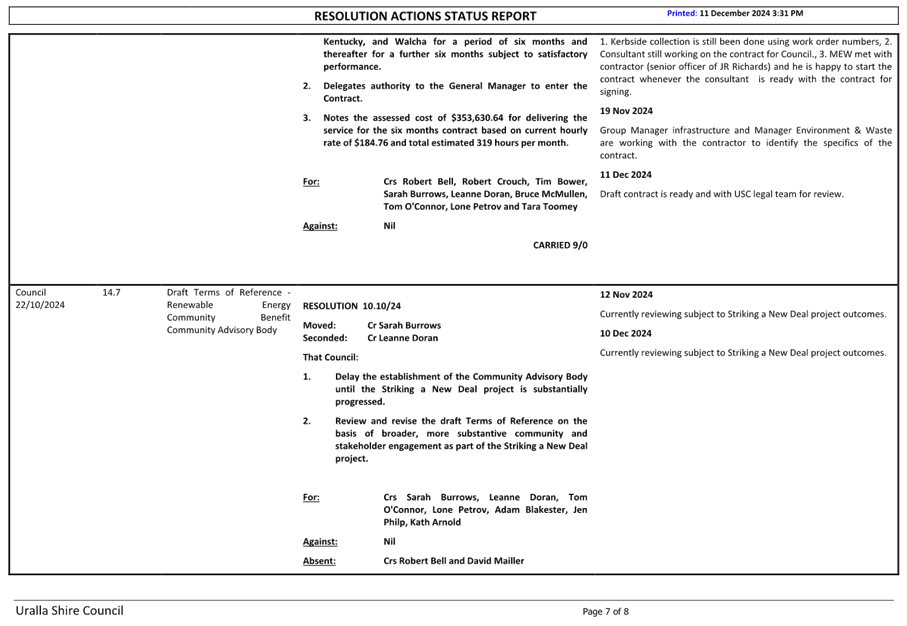
|
Ordinary Council
Meeting Business Agenda
|
17 December 2024
|
15 Confidential
Matters
|
Recommendation
That Council considers the confidential report(s) listed
below in a meeting closed to the public in accordance with Section 10A(2) of
the Local Government Act 1993:
15.1 Grace
Munro Aged Care Centre limited - update on lease proposal
This matter is considered to be confidential under Section
10A(2) - c, d(i) and d(ii) of the Local Government Act 1993, and the
Council is satisfied that discussion of this matter in an open meeting would,
on balance, be contrary to the public interest as it deals with information
that would, if disclosed, confer a commercial advantage on a person with whom
the Council is conducting (or proposes to conduct) business, commercial
information of a confidential nature that would, if disclosed prejudice the
commercial position of the person who supplied it and information that would,
if disclosed, confer a commercial advantage on a competitor of the council.
15.2 New
England Weeds Authority Update Report
This matter is considered to be confidential under Section
10A(2) - a and f of the Local Government Act 1993, and the Council is
satisfied that discussion of this matter in an open meeting would, on
balance, be contrary to the public interest as it deals with personnel
matters concerning particular individuals (other than councillors) and
details of systems and/or arrangements that have been implemented to protect
council, councillors, staff and Council property.
|




























































































































































































